Show HN Today: Discover the Latest Innovative Projects from the Developer Community
 ShowHN Today
ShowHN TodayShow HN Today: Top Developer Projects Showcase for 2025-07-05
SagaSu777 2025-07-06
Explore the hottest developer projects on Show HN for 2025-07-05. Dive into innovative tech, AI applications, and exciting new inventions!
Summary of Today’s Content
Trend Insights
Today's Show HN submissions highlight a surge in AI-driven solutions, particularly in the realm of local-first applications that prioritize user privacy and data control. This trend indicates a growing awareness among developers regarding the importance of data security and the potential of AI to enhance user experiences without compromising personal information. Developers should seize the initiative to explore AI for content analysis and generation, to boost user engagement and streamline content creation. Moreover, the emergence of declarative UX frameworks is paving the way for dynamic and adaptive user interfaces, empowering developers to create more responsive and personalized applications. Keep an eye on tools for streamlining application build and distribution across different platforms, it's where the next big thing is, and there's a lot to gain by making developers' lives easier. Embracing this spirit of innovation, every developer should strive to find creative ways to tackle real-world problems. Embrace the power of open source, contribute to projects that inspire you, and build solutions that make a difference. The future is in your hands, so go forth and create!
Today's Hottest Product
Name
News Alert - Real-time global news monitoring with keyword alerts
Highlight
This project utilizes real-time data streams to monitor global news sources and sends instant email alerts based on custom keywords. The core innovation lies in providing immediate, relevant information tailored to a user's specific interests. Developers can learn from the efficient use of data streams and email notification systems to create timely information delivery systems. This is particularly useful for applications where staying ahead of breaking news is crucial, such as financial analysis or reputation management.
Popular Category
AI
Game
Tool
Popular Keyword
AI
LLM
Game
Technology Trends
Local-first AI applications for enhanced privacy and data control
AI-powered tools for content analysis and generation (text, images)
Declarative UX frameworks for dynamic UI flows
Tools for managing and distributing application builds for cross-platform development
Terminal UI for improving developer workflow
Project Category Distribution
AI-related tools and applications (35%)
Games and entertainment applications (20%)
Developer tools and utilities (45%)
Today's Hot Product List
| Ranking | Product Name | Likes | Comments |
|---|---|---|---|
| 1 | News Alert - Global Real-time Keyword Monitoring System | 18 | 2 |
| 2 | MCP-123: A Minimalist Multi-Call Procedure Server/Client | 14 | 1 |
| 3 | Quotatious - A Word Guessing Game with Dynamic Hinting | 7 | 5 |
| 4 | VT Chat: Privacy-First Local AI Chat with Advanced Research Capabilities | 5 | 4 |
| 5 | Flaget - A Tiny CLI Argument Parser for Node.js | 3 | 6 |
| 6 | Terms of Service Analyzer: A Deep Dive into the Fine Print | 5 | 3 |
| 7 | eBay ThinkPad Price Oracle | 6 | 2 |
| 8 | PayToSay: The Immutable Chat | 4 | 2 |
| 9 | Liryo: Personalized Reading Analytics & Journaling | 6 | 0 |
| 10 | LogDog: Mobile App Remote Debugging & Mocking | 5 | 1 |
1
News Alert - Global Real-time Keyword Monitoring System
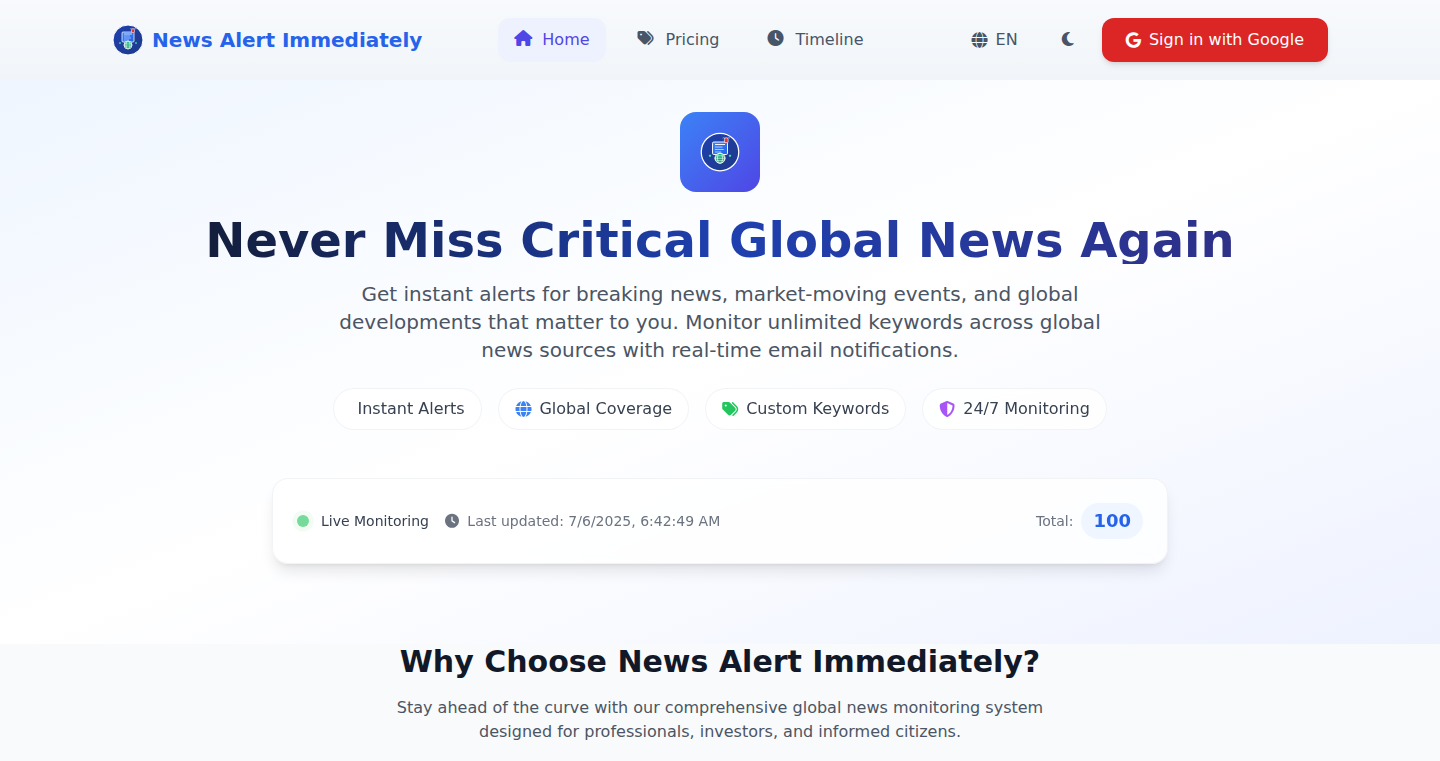
Author
zxcholmes
Description
This project is a 24/7 news monitoring service that sends instant email alerts when your pre-defined keywords appear in breaking news worldwide. It uses sophisticated web scraping and natural language processing (NLP) techniques to identify and filter relevant news articles from various global sources. The key innovation lies in its ability to provide real-time alerts with smart filtering, ensuring users receive only the most important news updates. This tackles the problem of information overload by delivering timely and targeted information.
Popularity
Points 18
Comments 2
What is this product?
News Alert is a system that constantly scans news websites and other online sources globally, looking for your specified keywords. It uses web scraping to extract information, NLP to analyze the text, and then sends you an email alert if your keywords are found in a breaking news story. It's innovative because it provides real-time monitoring and intelligently filters out less important news, saving you time and keeping you informed. So this is useful for staying ahead of the news and not missing important information.
How to use it?
Developers can integrate this service into their existing systems to monitor news related to their products, competitors, or any other topics. They can specify keywords, set up email notifications, and receive real-time updates. The system can be used as a standalone application by setting it up with required keywords. The project's REST API can allow developers to seamlessly integrate it with their other applications. So this lets you monitor information without you having to do all the manual search and analysis.
Product Core Function
· Real-time Alerts: This core function continuously monitors news sources and immediately sends alerts when keywords are detected. It utilizes web scraping techniques to extract data and near real-time processing to ensure the latest information is available. So this is useful for timely information discovery.
· Custom Keyword Tracking: Users can define a list of keywords to monitor, allowing them to tailor the service to their specific needs and interests. The service then tracks all the news sources globally for these specific keywords. So this gives you personalized news monitoring.
· Smart Filtering: The system uses NLP to analyze news articles and prioritize important news. It determines relevance based on content and context, reducing noise and delivering only the most relevant information. So this makes sure that you are not overwhelmed with useless data.
· Global News Source Coverage: It monitors multiple international news sources, including major news outlets and other sources, providing comprehensive coverage. This broad approach ensures users receive alerts from a wide variety of information sources. So this is useful for not missing information from various sources.
· Email Notification: The system sends instant email notifications containing the relevant breaking news information. This is the main delivery method. So this means you get notified and can immediately take action on important information.
Product Usage Case
· An investor tracking financial news to monitor the stock performance of a specific company. They could set up keywords related to the company name and key terms to receive instant alerts about important news, financial reports, and analyst opinions that might affect their investment decisions. So this is useful for making better investment decisions.
· A marketing professional tracking mentions of their company's products or services in the news. They could define keywords related to their brand and products to monitor the performance, identify potential PR issues, and respond quickly to any negative press or feedback. So this enables faster management and response to marketing related information.
· A business professional staying informed about the latest industry trends and competitor activities. They can monitor news related to their industry, competitors, and emerging technologies to gain a competitive edge and make informed business decisions. So this is useful for taking appropriate and smart business decisions.
· A security analyst tracking news about global conflicts, political events, or major incidents which can affect business operations and security. They can monitor for keywords related to specific events or regions to receive alerts about any emerging threats or risks. So this is useful for timely risk assessment and mitigation
2
MCP-123: A Minimalist Multi-Call Procedure Server/Client
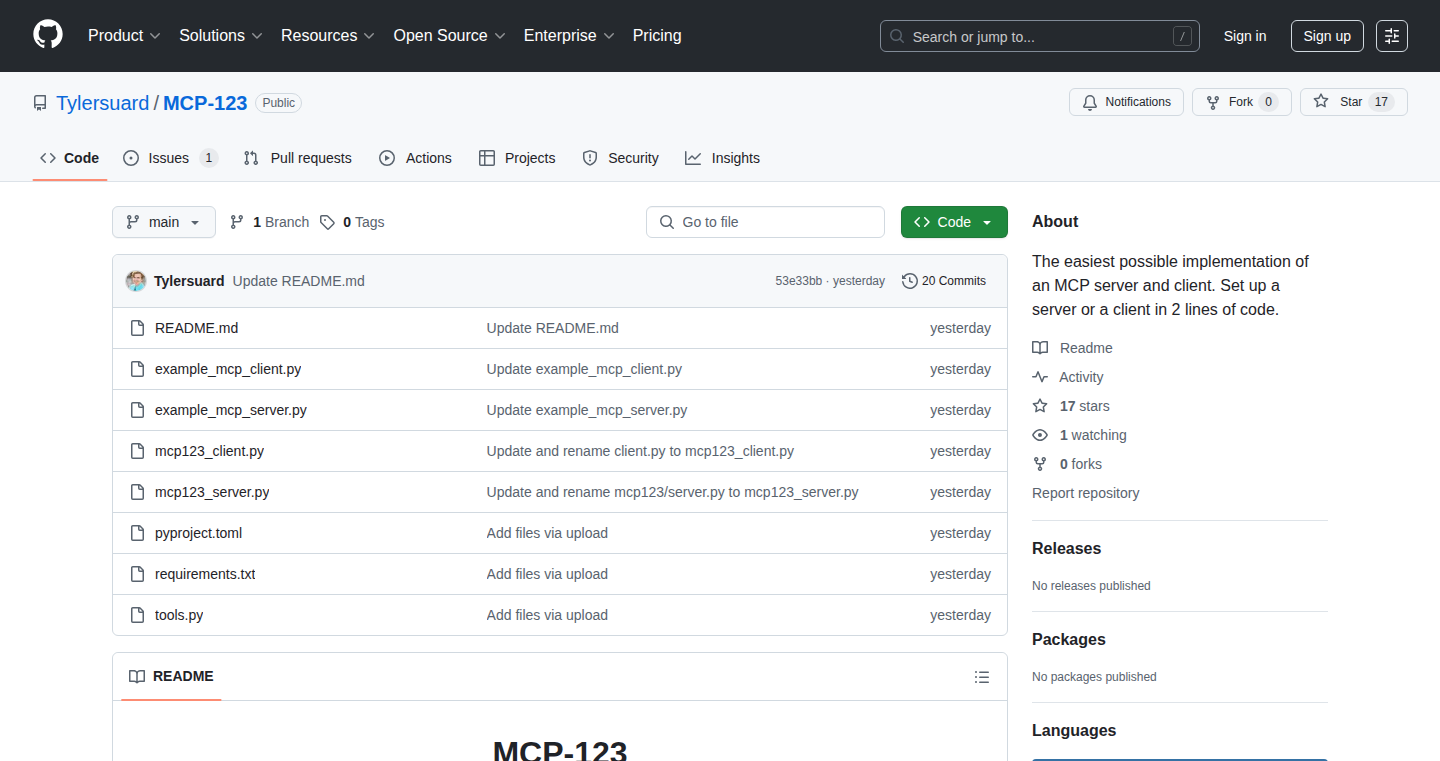
Author
tylersuard
Description
MCP-123 simplifies the creation of server-client applications, especially those utilizing Multi-Call Procedures (MCP). The innovation lies in its extremely concise implementation - a two-line server/client setup. It avoids the complexities of Docker or Mac-specific scripts, making it accessible on Windows. It auto-discovers and calls functions using OpenAI, streamlining the interaction between the server and client. So, it allows you to quickly build applications where different parts of your program communicate and execute actions, like using a remote control to operate a device, only much simpler to set up.
Popularity
Points 14
Comments 1
What is this product?
MCP-123 is a library to create MCP-based applications with a very minimal setup. It allows a server to expose functions that a client can automatically discover and call. The core technology is about making the communication between software components (the server and the client) easier. It leverages the power of OpenAI to automatically identify and use the functions provided by the server. For example, if you need to remotely control a system or expose functionalities of a program, MCP-123 makes it much easier. So this makes it much easier to share functions between different programs, regardless of where they are running.
How to use it?
Developers can use MCP-123 by pointing it to a Python file containing the functions they want to expose as services (like a `tools.py` file). Then, they run the server using a single command: `server.run_server(...)`. The client then automatically discovers these functions and can call them through OpenAI integration. This setup is incredibly useful in scenarios like building APIs, creating plugins, or allowing different systems to interact seamlessly. So, you can quickly make components of your software work together.
Product Core Function
· Two-line server/client setup: This dramatically reduces the boilerplate code required to set up a server-client interaction. It speeds up development and simplifies the learning curve for developers, making it easier to experiment with distributed systems. So this allows you to get your program running fast.
· Windows-friendly: Supports the Windows operating system, opening up opportunities for developers who primarily use Windows environments. It broadens the scope of users and application scenarios. So, this makes your program portable and widely compatible.
· Auto-discovery and function calling via OpenAI: The library automates the process of discovering and calling functions on the server, leveraging OpenAI's capabilities. This significantly reduces the manual effort required to connect different parts of your application. So, this removes complexity and connects all your functions automatically.
· Simplifies MCP implementation: Provides an easy way to apply Multi-Call Procedures without getting bogged down in complex configurations. This makes it quicker to build applications that share resources and execute actions remotely. So this reduces configuration and allows for quick setup.
Product Usage Case
· API creation: Developers can quickly expose functions as API endpoints for other applications to consume. This allows for easy integration with third-party systems or other parts of the same application. So, you can build APIs easily.
· Plugin development: MCP-123 can be used to create plugins that extend the functionality of existing applications, making it simpler for external services to connect. So you can make a plugin very quickly to extend functionality.
· Remote control and automation: Users can build applications that remotely control devices or automate tasks by exposing functions for execution on other systems. So you can build remote controllers.
3
Quotatious - A Word Guessing Game with Dynamic Hinting
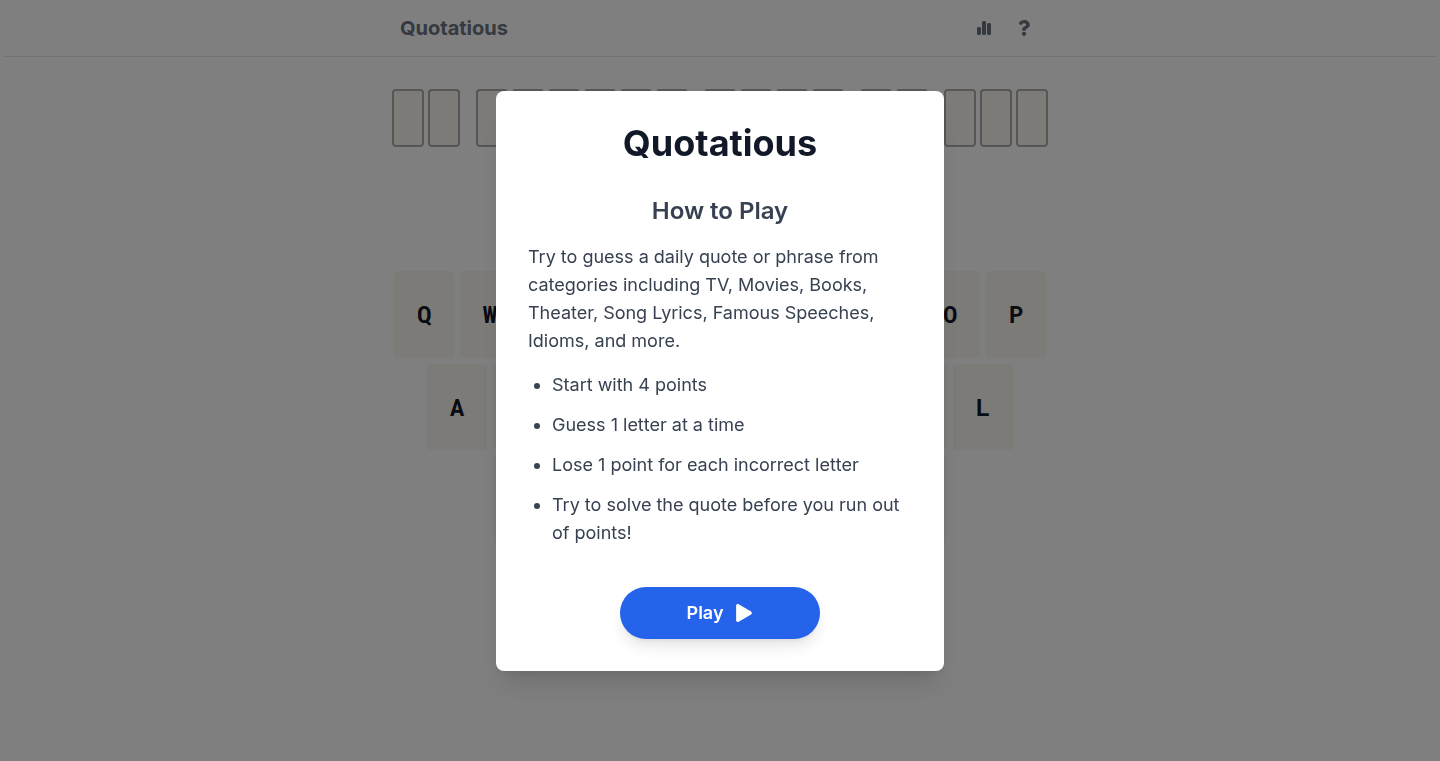
Author
jcusch
Description
Quotatious is a web-based word game inspired by Wordle and Hangman. It allows players to guess a hidden quote by revealing letters, similar to Hangman, but incorporates Wordle's guessing format. The innovative aspect lies in its dynamic hinting system. Instead of static hints, the game offers adaptive clues based on the player's progress, adjusting the difficulty and information revealed as the player makes guesses. This addresses the challenge of creating a balance between challenge and enjoyment in word games. So this makes it more fun for me, by making the game more dynamic and engaging.
Popularity
Points 7
Comments 5
What is this product?
Quotatious is built using web technologies likely including HTML, CSS, and JavaScript for the front-end, and potentially a server-side language (like Python with Flask or Node.js) for handling game logic, data storage, and hint generation. The innovation lies in the adaptive hint generation. As players guess, the game analyzes their attempts and provides increasingly helpful hints, such as revealing letters in specific positions or providing thematic clues. It might use algorithms to select the next clue that's most helpful without giving away the answer too easily. So this means it's a smart game that adapts to how well you play.
How to use it?
Players can access Quotatious through a web browser. They can guess the hidden quote by typing letters. The game provides visual feedback on correct letter positions and incorrect guesses. Hints appear dynamically based on the player's actions. Developers interested in modifying or integrating Quotatious could access the source code (likely available on GitHub), adjust the hint generation algorithms, modify the game's UI (user interface), or create their own quote databases for a personalized experience. So this gives me a way to create my own custom version of this fun game.
Product Core Function
· Word Guessing Mechanism: The core of the game allows players to repeatedly guess letters to unveil a hidden quote. This fundamental function showcases the basic word puzzle mechanics. This means I get a fun, interactive word game.
· Adaptive Hint System: The game uses an innovative hint system that provides contextual clues based on a player's progress. This feature enhances the player experience by offering tailored hints. So I get hints that are just right for the level of difficulty.
· Quote Database Management: Quotatious stores and manages a database of quotes, likely used to generate the hidden quotes for the players. This function enables the game to have a large variety of games. So this gives me a game that always has something new to offer.
· User Interface (UI) and User Experience (UX): The game offers a clean and intuitive user interface that facilitates gameplay. This aspect focuses on making the game easy to play and visually appealing. So I get a game that's easy and fun to play.
Product Usage Case
· Educational Tool: Teachers can use Quotatious as an interactive tool to enhance vocabulary and improve language skills. They could customize the quotes to align with the educational material being taught. So I can use this in the classroom to make learning fun.
· Custom Puzzle Creation: Developers can modify the quote database and hint mechanisms to create customized word puzzles with specific themes or topics. This supports personalized gaming or the integration of game mechanics into other applications. So I can build my own unique games based on my interests.
· Gamification of Language Learning: Quotatious can be used as a fun and effective tool for learning new languages. Different quote databases could be developed for various languages. So this helps me learn a new language in an interactive way.
· Adaptive Difficulty Levels: The hint system enables dynamic adjustment of difficulty based on the player's performance, therefore it can be integrated with adaptive learning platforms. So this makes the game challenging, but not too hard.
4
VT Chat: Privacy-First Local AI Chat with Advanced Research Capabilities
Author
vinhnx
Description
VT Chat is a privacy-focused AI chat application that prioritizes local storage of all conversations, ensuring user data remains within their control. It offers advanced research features and integrates with multiple AI models like Claude 4 Sonnet and Gemini 2.5 Pro. The core innovation lies in its true local-first architecture using IndexedDB for chat storage, guaranteeing user data privacy by eliminating server-side data storage and preventing developer access to API keys. It allows users to switch between various AI providers (OpenAI, Anthropic, Google, etc.) for comparison, with complete data isolation on shared machines. So, this is like having your own secure AI assistant, capable of complex research and powered by different AI models, all without compromising your privacy.
Popularity
Points 5
Comments 4
What is this product?
VT Chat is an AI chat application built on a local-first architecture. This means all your chat data is stored directly in your browser using IndexedDB, a local storage mechanism. The innovation here is in ensuring that no conversation data or API keys ever leave your device, providing maximum privacy. This approach avoids the common practice of storing user data on a server, reducing the risk of data breaches and maintaining user control. Furthermore, the app incorporates advanced research capabilities, such as multi-step research with source verification and AI-powered semantic routing, enabling users to conduct complex research tasks directly within the chat interface. So, it's a private, powerful AI chatbot with built-in research tools.
How to use it?
Developers can use VT Chat by either self-hosting the open-source code or using the hosted version. The core technology revolves around the local-first design, leveraging technologies like Next.js 14, TypeScript, and Turborepo. You can integrate VT Chat's features by studying the source code and adapting its components for your specific needs. For instance, you could use its approach to securely manage API keys or incorporate its research workflow architecture into your own AI-powered applications. So, you can either use it directly or learn from it to build your own privacy-focused AI applications.
Product Core Function
· Local-First Architecture: All chat data is stored locally in IndexedDB, ensuring complete privacy as no data is sent to any server. This is crucial for users concerned about data security and privacy. This prevents your conversations from being stored or viewed by others. So, you get a truly private chat experience.
· Multi-Model Support: The application supports multiple AI models (OpenAI, Anthropic, Google, etc.) allowing users to compare outputs and leverage different AI capabilities. This provides flexibility and the ability to select the best AI for a specific task. So, you can choose the best AI model for your needs and compare their performance.
· Advanced Research Features: Includes Deep Research, Pro Search, and AI Memory, which facilitates multi-step research with source verification, real-time web search integration, and the creation of a personal knowledge base. This significantly enhances the research capabilities within the chat application. So, you can conduct complex research and get more reliable information.
· Document Processing: Includes features for processing PDFs and structured extraction that turn documents into JSON, enabling users to work with various document formats. This allows for easy information extraction and summarization. So, you can easily get information from your documents.
· AI-Powered Semantic Routing: Automatically activates tools based on user queries, improving the efficiency and accuracy of research workflows. This is beneficial for managing complex interactions and automating different tasks. So, your AI assistant automatically selects and activates the right tools to help you.
Product Usage Case
· Secure Data Storage: Developers can adopt the local-first architecture to build other applications where data privacy is critical, such as secure messaging apps or personal data management tools. It can protect sensitive user information. So, you can build applications that value and protect user privacy.
· AI Research Workflow Integration: Other developers can integrate the advanced research features (Deep Research, Pro Search) into their own applications, particularly in areas like scientific research, market analysis, or any domain requiring in-depth analysis. It can help make the research process more efficient. So, you can make your existing tools more powerful with these research functionalities.
· Multi-AI Model Comparison: Developers building AI-driven tools can use the multi-model integration approach to compare the performance of different AI models side-by-side within their own applications. It can help in finding the best AI model for different projects. So, you can choose the right AI model for your own projects.
· Privacy-Focused Chatbot Development: Developers looking to build their own AI chatbots can use VT Chat's architecture as a reference to ensure user data privacy, which is important for regulated industries like healthcare or finance. It provides a blueprint for secure development. So, you can easily build your own secure and reliable AI chatbot.
5
Flaget - A Tiny CLI Argument Parser for Node.js
Author
biodiscus
Description
Flaget is a lightweight (5KB) command-line argument parser for Node.js, offering a smaller and faster alternative to the popular yargs-parser. It tackles the common problem of parsing arguments passed to command-line interfaces (CLIs) – like when you type commands in your terminal. The innovation lies in its compact size and efficiency, making it ideal for projects where file size and performance are critical.
Popularity
Points 3
Comments 6
What is this product?
Flaget is a specialized tool that takes the text you enter in the command line (like 'myScript --verbose --port 8080') and breaks it down into meaningful pieces that your program can understand. Think of it like a translator for your CLI commands. It offers the same functionality as larger parsing libraries like yargs-parser, but is much smaller, which makes your applications faster and easier to distribute. So this is useful to anyone who is working on command-line tools, such as scripts or Node.js applications, helping the users to build applications quickly.
How to use it?
Developers can easily integrate Flaget into their Node.js projects by installing it via npm (Node Package Manager) and then using a simple API to parse command-line arguments. You would typically import Flaget into your script and then pass the `process.argv` array (which contains the command-line arguments) to its parsing function. This function returns an object containing all the parsed arguments. So this is something you can use in developing applications that need to read from the command line.
Product Core Function
· Parsing Command-Line Flags: Flaget parses common flag formats (e.g., --flag, -f value) enabling developers to define and process command-line options. It is important because it allows you to customize the behavior of a program through arguments, making it more versatile and user-friendly. So this allows your program to support customizable behavior via command-line input.
· Lightweight Library: Being only 5KB, Flaget contributes to faster loading times for Node.js applications. This is especially useful for projects where speed and efficiency are paramount. So this will reduce the overall file size of your project.
· Compatibility: Flaget works seamlessly with different command-line argument structures, offering broad support for CLI argument formats. This allows developers to write cleaner and more structured code when implementing CLI tools.
· Ease of use: Flaget is designed to be simple to use and easily integrated into any project. Developers are able to parse and understand the arguments, which is important to make application user-friendly.
Product Usage Case
· Automated Testing: Used in automated testing scripts, allowing developers to specify different test configurations through command-line arguments. For example, you can write a script that runs different tests based on what you provide on the command line, such as test type, or test number. It helps to build automated test suites, streamlining the testing process and making debugging easier. So you will benefit from automated testing.
· Build Tools: Integrate Flaget into build tools and scripts to handle various build configurations. If you are building a web application, for example, you can build different versions of your app. This would make it easy for others to build it too, because they can build with configuration inputs like a production mode or a development mode. So this makes building your apps more streamlined.
· Development Tools: Used in CLI tools for developer workflows. For example, it might be used in a tool to manage the building process for a web server. This saves developers time, because they don't have to write the whole command over and over again. So it saves developers time.
6
Terms of Service Analyzer: A Deep Dive into the Fine Print
Author
geminiboy
Description
This project analyzes Terms of Service (ToS) agreements using Natural Language Processing (NLP) techniques. It identifies key clauses, potential risks, and simplifies complex legal jargon into easily understandable summaries. It tackles the problem of overwhelming and often deliberately obfuscated ToS documents, making it easier for users to understand their rights and obligations. So, this helps you understand what you're agreeing to, without having to read the entire document.
Popularity
Points 5
Comments 3
What is this product?
This project, built using NLP, essentially 'reads' Terms of Service documents for you. It breaks down the dense legal text into manageable pieces, identifying important sections like data privacy, user rights, and dispute resolution. The innovative aspect is its ability to highlight potential risks and provide a simplified, human-readable overview of the document. This involves complex algorithms to understand the meaning of words and sentences, enabling the software to make informed conclusions. So, you get a clear picture of the ToS, quickly.
How to use it?
Developers can use this project by either submitting a ToS URL or pasting the text directly into the analyzer. The system then processes the text and presents a summarized version with key findings. The output can be easily integrated into other applications or used as a standalone tool for quick ToS review. Imagine building a browser extension that automatically analyzes ToS documents as you browse! So, as a developer, you can build tools to inform users about the legal aspects of the services they are using.
Product Core Function
· Key Clause Extraction: The analyzer identifies and highlights the most important clauses within the ToS document, such as those related to data privacy, liability, and termination. This saves users time by focusing their attention on the most critical sections. So, you quickly understand what's essential to know.
· Risk Assessment: The system flags potential risks and unfavorable terms within the ToS. This helps users identify potentially problematic clauses that could negatively impact them. So, you can spot potential dangers before agreeing to the ToS.
· Summarization: The project provides a summarized version of the ToS in plain language. This makes the complex legal language easier for the average user to understand. So, the jargon becomes understandable.
· Comparison: The analyzer allows users to compare ToS agreements from different services, revealing similarities and differences. So, you can compare and contrast the ToS of different services.
· Sentiment Analysis: The system can analyze the overall 'tone' or sentiment of the ToS document, providing an understanding of whether the terms are generally favorable or unfavorable to the user. So, you can get a sense of the overall fairness of the document.
Product Usage Case
· Building a Privacy-Focused Browser Extension: Integrate the analyzer into a browser extension to automatically scan and summarize ToS documents as users browse the web. This empowers users to make informed decisions about the services they use, giving them information about their privacy. So, it helps users choose privacy-respecting services.
· Legal Tech App Integration: Integrate the analyzer's API into a legal tech application, allowing users to quickly assess the ToS of various services before making a decision. This simplifies the legal research process for individuals. So, the app can show people how to get their questions answered.
· Educational Tool for Consumer Rights: Use the analyzer as an educational tool to teach consumers about their rights and obligations under different service agreements. This will provide more education. So, it gives consumers the knowledge they need to be informed.
· Contract Review Automation: Automate the initial review process for legal contracts, allowing legal professionals to quickly identify key clauses and potential risks. So, lawyers can work faster and be more efficient in dealing with contracts.
7
eBay ThinkPad Price Oracle
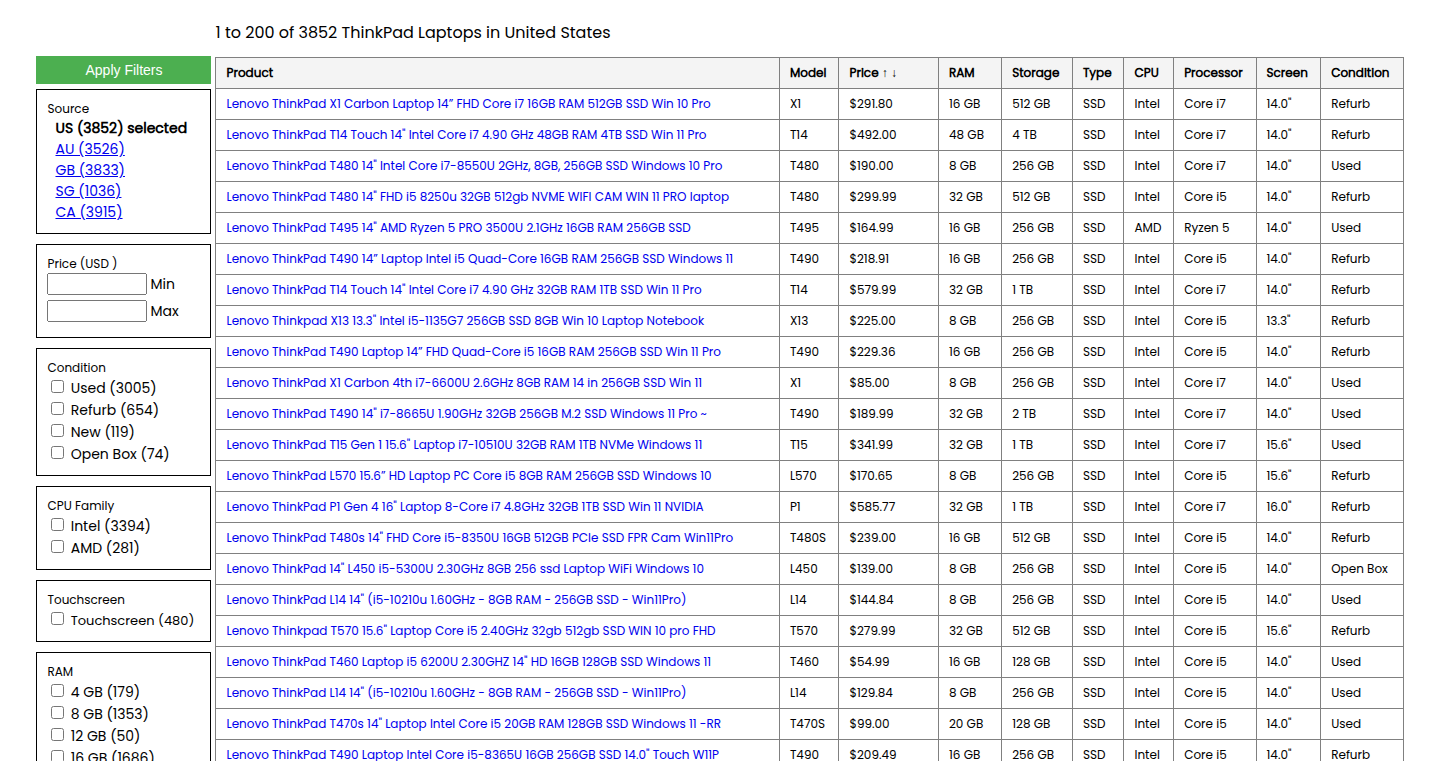
Author
sagunsh
Description
This project analyzes eBay listings for ThinkPads to provide users with insights into current market prices. The innovation lies in its automated data collection and analysis, using web scraping to gather information from eBay and then applying data science techniques to determine fair prices. It solves the problem of manually sifting through countless eBay listings and makes it easier for users to understand the real market value of ThinkPads, potentially leading to better buying or selling decisions.
Popularity
Points 6
Comments 2
What is this product?
This project is essentially a price prediction tool for ThinkPads on eBay. It works by automatically collecting data from eBay listings (web scraping), which includes information like the model, condition, seller ratings, and asking price. Then, using data science techniques like statistical modeling, it analyzes this data to estimate a reasonable price for a given ThinkPad configuration. It’s innovative because it automates what would otherwise be a tedious manual process. So what is the value? It gives a quick estimate of how much a ThinkPad is worth on the market now. It saves you time and helps you make a more informed decision.
How to use it?
Developers can use this in several ways. They could integrate the price estimates into their own applications, create their own eBay price analysis tools, or even use the code as a starting point for analyzing prices of other products on eBay. The core functionality focuses on data extraction and modeling. The developers can use web scraping libraries (like Scrapy or Beautiful Soup in Python) to extract data from eBay and machine learning libraries (like scikit-learn) to build the price models. For example, you might use the estimated price data from this project to create a browser extension or build another product feature.
Product Core Function
· Automated Data Collection: This core function uses web scraping to gather data from eBay listings. This automated process saves time compared to manual data gathering and ensures a continuous stream of information, allowing users to keep up to date. Value: saves time, provides fresh data, essential for price analysis. Use Case: When you have to constantly analyze product listing and can set automatic extraction process
· Price Prediction Modeling: The project uses data science to predict prices, taking into account various factors such as the ThinkPad's model, condition, and seller information. Value: provides an estimated fair market value, reducing the need to manually research current pricing. Use Case: when trying to assess how expensive your ThinkPad is
· Data Visualization: The project visualizes the data. Value: it helps understand the pricing trends and patterns visually, making it easier to grasp the data. Use case: quickly determine how much the item is worth
Product Usage Case
· Buying a Used ThinkPad: A user is looking to purchase a used ThinkPad on eBay. Instead of manually checking multiple listings, they could use this tool to get a quick estimate of the fair market price for the specific model and configuration they want. This allows the buyer to identify potentially overpriced listings, or spot good deals. The user is able to filter and compare product conditions. So what is the value? It helps make sure you are not overpaying.
· Selling a ThinkPad: A seller wants to list their ThinkPad on eBay. They can use the tool to determine a competitive and reasonable price for their laptop, increasing the likelihood of a successful sale. The project gives the seller an idea of the fair market price. So what is the value? It helps you sell faster and for a better price.
· Developing a Price Comparison Website: A developer could integrate the project's data and analysis into a price comparison website, providing users with detailed price comparisons for ThinkPads across different listings. This would be useful for consumers as they can compare the listing by the machine learning's predicted price. So what is the value? This would enable you to compare prices and features side-by-side in an automatic fashion.
8
PayToSay: The Immutable Chat
Author
bahrtw
Description
PayToSay is a public chat room with a unique twist: users must pay a small fee to post messages. This project explores the idea of scarcity and value in the digital age. It addresses the problem of information overload and fleeting online conversations by creating a limited, permanent chat log. The core innovation lies in using monetary cost to filter content and create a more considered, lasting digital record. It's a technological experiment in social dynamics and the economics of attention. So this could be used to create a more valuable online discussion by putting a price on each message.
Popularity
Points 4
Comments 2
What is this product?
PayToSay is a web-based chat application. The technical principle behind it is simple: it integrates a payment system (likely using a platform like Stripe or PayPal) to charge users for each message they post. The chat itself likely uses common web technologies like HTML, CSS, JavaScript, and a backend language like Python or Node.js with a database to store messages. The innovation is in the economic model: by charging users, the system aims to curb spam, promote thoughtful communication, and create a permanent, value-driven record of the conversation. So it's like creating a premium space for discussions.
How to use it?
Developers could integrate similar concepts into their own projects to manage user interactions. This could be used in forums, comment sections, or any platform where you want to encourage quality content and discourage low-value posts. For example, a developer could integrate a 'pay-per-post' feature into a professional networking site to attract serious content creators or consultants. The integration involves setting up the payment gateway, implementing the charging logic, and storing the messages in a database. So if you are trying to build an online forum with high quality, you can use this approach.
Product Core Function
· Paid Messaging: The core function is the ability to post messages after paying a pre-determined fee. This filters content based on willingness to pay, theoretically leading to higher-quality posts and reduced spam. This has value if you want to reduce unwanted content.
· Limited Capacity: The chatroom has a finite number of message slots. Once filled, the chat becomes a permanent archive. This creates scarcity and encourages users to make each message count, adding value in the long run. This is valuable in creating a time capsule online.
· Payment Gateway Integration: The technical implementation requires integrating a payment gateway (e.g., Stripe, PayPal). This allows the application to process real-world currency and handle transactions. This is valuable for providing financial service.
Product Usage Case
· A premium consulting forum: Imagine a website where professionals pay to post expert advice or insights. The payment model ensures only those committed to quality contribute. So this can be used to filter out bad content.
· A historical archive: The PayToSay concept could be applied to create a digital time capsule for historical events. Users pay to leave messages documenting a specific moment. These messages would be permanently archived, allowing for a unique historical record. So this can be used to store important memories for later.
· Moderated communities: A chat application where moderators pay to respond to messages from users, encouraging quality content and accountability. So this will improve the user experience.
9
Liryo: Personalized Reading Analytics & Journaling

Author
roxanamb
Description
Liryo is a reading journal app designed to help users track their reading habits, set goals, and analyze their reading data. It leverages a combination of data visualization techniques like heatmaps and statistical analysis to provide insights into reading patterns and progress. It tackles the problem of losing track of books read and offers a way to quantify and understand reading habits, helping users become more mindful and intentional readers.
Popularity
Points 6
Comments 0
What is this product?
Liryo is a web application that allows users to log the books they read, rate them, and track their reading progress. The core innovation lies in its ability to visualize reading habits through heatmaps and statistical dashboards. For example, the heatmap can show which days of the year a user reads the most. It also offers integration with other services like Cronometer and features like setting daily goals and tracking streaks, providing a holistic view of the user's reading journey. So this helps you to truly understand your reading habits.
How to use it?
Developers and users can interact with Liryo through its web interface. Users can manually log books, ratings, and reviews. The app uses this input data to generate personalized statistics and visualizations. It also offers an API or data export functionality which could allow developers to integrate the data into other applications or services. So this allows you to understand your reading habits, and if you are a developer, maybe integrate with the app to create new features.
Product Core Function
· Book Logging & Ratings: Users can easily log the books they read, add reviews, and rate them. This creates a comprehensive library of read books and allows for personalized recommendations and insights based on the user's preferences. So this is a digital library of your reading history and preferences.
· Heatmap Dashboard: The app's heatmap visualization provides a visual representation of the user's reading activity over time, showing which days and periods they read the most. This helps users to identify patterns and trends in their reading habits. So this helps you understand your reading patterns visually.
· Daily Goals & Streaks: The app allows users to set daily reading goals and track their streaks, motivating them to read consistently. This feature encourages consistent reading habits and fosters a sense of accomplishment. So this motivates you to read more regularly.
· Cronometer Sync: Integration with Cronometer (though this is specific to this app) enables users to sync data with their nutrition and health tracking, indicating that the user may be able to sync this app to track other relevant data. This functionality highlights the potential for integrating reading data with other health and wellness metrics. So this allows you to cross-reference your reading time and possibly understand the connection between reading and other lifestyle factors.
· Custom Lists & Favorites: Users can create custom lists to organize books based on different criteria, such as genre, author, or reading status. They can also mark books as favorites, making it easy to find and re-read their most beloved books. So this enables personalized organization and access to books.
· Spending Tracker: The app also allows users to track how much money they spend on books. This feature helps users to manage their book-related expenses effectively. So this helps you understand how much you spend on books.
· Multilingual Support: Liryo supports multiple languages, allowing users from around the world to use the app in their preferred language. So it is accessible to a global audience.
· Export Reviews: Users can export their book reviews, enabling them to save and share their writing outside the app. So it enables users to back up and share their reviews.
Product Usage Case
· Personal Reading Analysis: A user can use the app to track the number of books read per month and compare it over different years. By using the heatmap, the user can find out the time of the year that they read the most, which could reveal the time of year when they have more free time. So this helps you understand and compare your reading habits over time.
· Integrating Reading Data with other Apps: A developer could integrate the app's data export feature with other services. For example, a developer could connect the app's data to a personal productivity dashboard, alongside task management, and fitness trackers. So this allows you to combine reading with your other routines.
10
LogDog: Mobile App Remote Debugging & Mocking
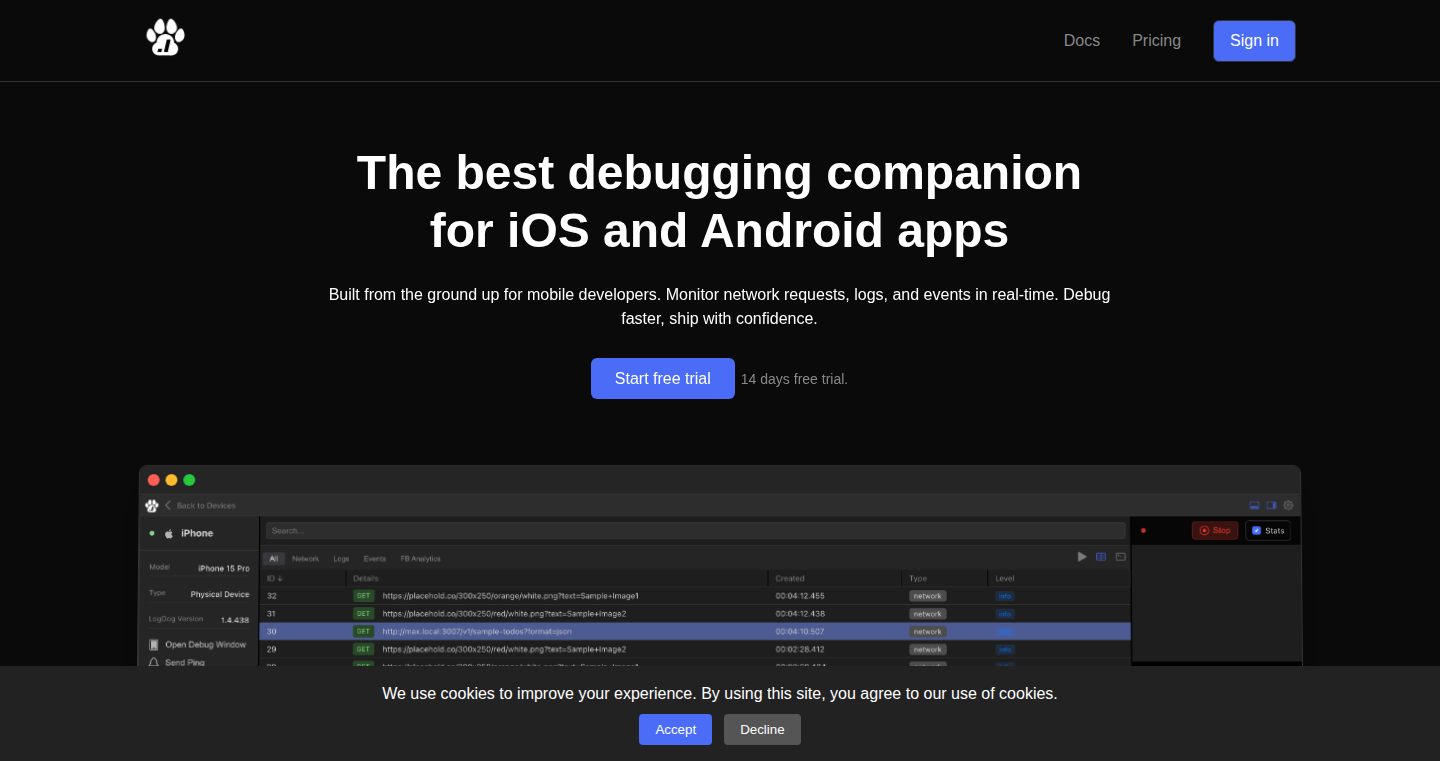
Author
modrena
Description
LogDog is a tool that allows developers to remotely debug and mock mobile applications. It solves the problem of debugging mobile apps on different devices and networks without requiring physical access or complex setups. The innovation lies in its ability to intercept and manipulate network traffic in real-time, enabling developers to simulate various scenarios and troubleshoot issues efficiently.
Popularity
Points 5
Comments 1
What is this product?
LogDog is essentially a 'remote control' for debugging your mobile app. Imagine you're developing an app that talks to a server. You can use LogDog to see all the messages your app sends and receives (like a spyglass). It also lets you change these messages (like a puppeteer), so you can test how your app behaves in different situations, such as slow internet connections or when the server sends back unexpected data. This is innovative because it allows debugging without physically connecting to the device or changing the app code directly, saving developers a lot of time and effort.
How to use it?
Developers integrate LogDog into their mobile app, usually with a simple library or SDK. Once integrated, the app's network traffic is routed through LogDog. Developers can then access a web interface to inspect and manipulate this traffic. For example, you could intercept a request, modify the response (simulating server behavior), and see how your app reacts. Or you could simulate a network error to test your app's error handling. This allows for testing edge cases and debugging issues without needing to replicate them physically.
Product Core Function
· Network Traffic Interception: LogDog captures all network communication from your app, allowing you to see exactly what data is being sent and received. This helps pinpoint issues related to data transmission or format, so you can see exactly what the app is saying to the server, and vice versa. This is invaluable for understanding communication problems.
· Request and Response Mocking: LogDog lets you replace the real responses from the server with mocked ones, allowing you to test different server scenarios without waiting for the actual server. This is super useful for testing different states without needing to change your application code every time. So, you can test your app’s response to various responses without affecting the real server.
· Remote Debugging: LogDog lets you debug your app on any device, even if you don't have direct access to it. This is great for testing on different phone models and network conditions without physically having the phone with you. This gives developers more flexibility in their testing.
· Real-time Data Inspection: Developers can view the network traffic in real-time, providing immediate feedback on the app’s behavior. You get instant insight, instead of having to wait for logs to be collected and analyzed. This can drastically speed up the debugging process.
· Simulate Network Conditions: Easily simulate different network scenarios, such as slow connections or dropped packets, to test your app’s resilience. This is excellent for ensuring a smooth user experience under different network constraints, making your app more robust and reliable.
· Simplified Testing: LogDog can easily integrate with CI/CD pipelines for automated testing. The goal is to eliminate manual intervention to verify application functionality, thus saving developers time.
Product Usage Case
· Debugging API Integrations: A developer is integrating their mobile app with a third-party API. Using LogDog, they can intercept the requests and responses, and quickly identify issues related to data formatting or incorrect API calls. This allows for easy troubleshooting of API integrations.
· Testing Error Handling: A developer wants to test how their app handles network errors. They use LogDog to mock a server response that indicates an error. This allows them to verify that their app handles the error gracefully and displays the appropriate message to the user. So, you can see if your app reacts correctly when things go wrong.
· Simulating Slow Network Conditions: A developer is concerned about the performance of their app on slow networks. They use LogDog to simulate slow network speeds and see how the app behaves. This allows them to optimize the app for different network conditions. Thus, ensuring the app works well anywhere.
· Testing Different User Scenarios: A developer wants to test how their app behaves for different user roles or with different data sets. They can mock different responses and see if the app displays the correct content. So, you can ensure the content is right for all users.
· Testing with Different Device Types: Developers can use LogDog to test their app’s behavior on various devices without physically having them, such as Android or iOS. This will provide a consistent experience for different devices.
11
LexiCraft: A Collaborative Word Puzzle Engine
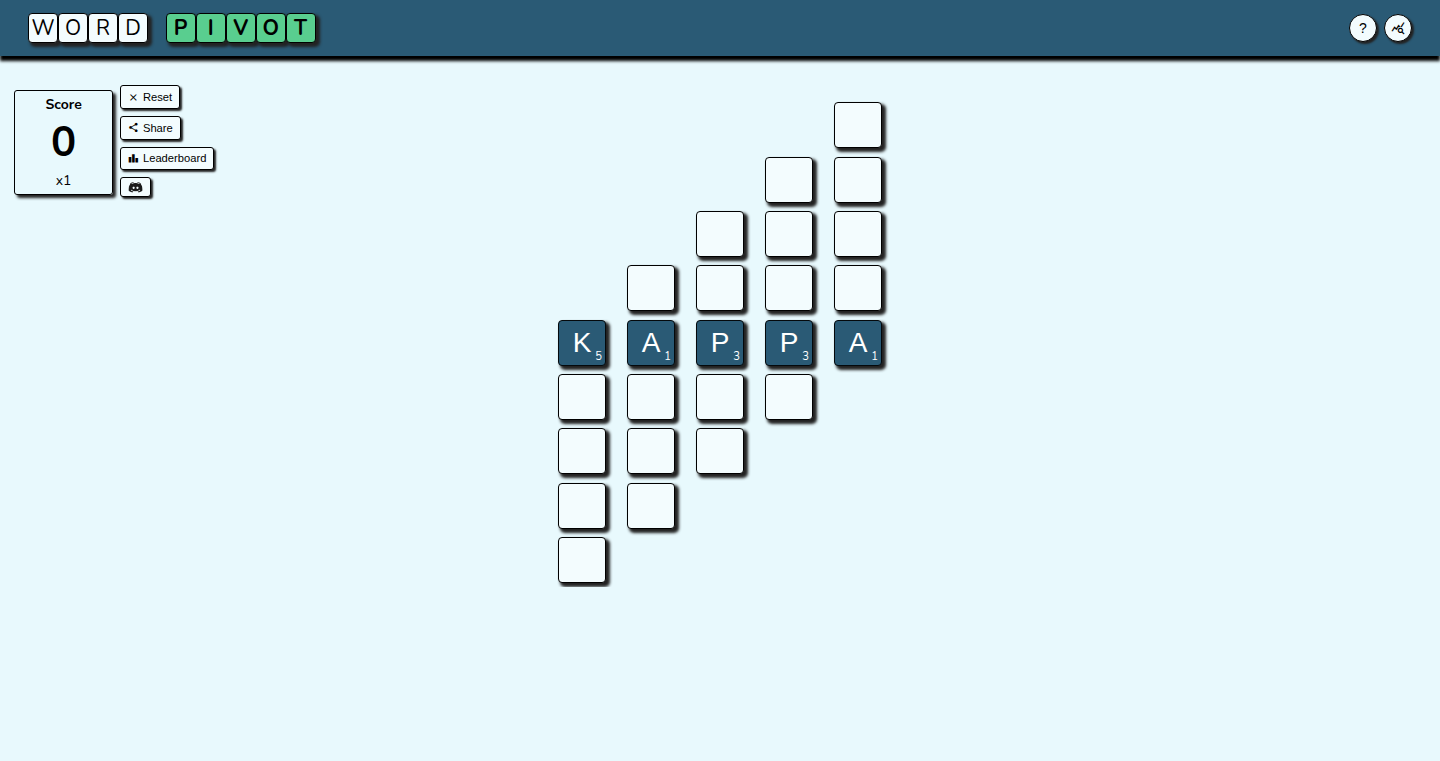
Author
max0563
Description
LexiCraft is a word puzzle game built for collaborative play, showcasing real-time synchronization and a flexible design. It lets friends play word puzzles together. The key innovation is its use of WebSockets for instant updates, ensuring all players see the game state change simultaneously, regardless of their location. It addresses the problem of stale game states in collaborative online games.
Popularity
Points 5
Comments 0
What is this product?
LexiCraft is a web-based word puzzle game, like Scrabble but with a collaborative focus. The core technology lies in its use of WebSockets. Think of WebSockets as a two-way communication channel between your computer (the player's browser) and a central server. When one player makes a move, the server instantly updates the game state and pushes it to all other connected players. This is different from traditional web games that might refresh every few seconds. The innovation is the real-time nature of the game, enabling seamless collaborative gameplay.
How to use it?
Developers can use LexiCraft as a base to build their own collaborative games, or to add real-time features to existing applications. The core WebSocket implementation can be adapted for many different scenarios, like real-time chat applications, collaborative document editing, or even live dashboards that need to update frequently. You integrate by using the WebSocket library within your programming language of choice.
Product Core Function
· Real-time Game State Synchronization: The core function is the immediate sharing of game updates through WebSockets. When a player adds a word, all other players see it instantly. This is achieved by the server actively pushing updates to all connected clients. So what? This makes collaborative games much more engaging and eliminates delays.
· Client-Server Architecture: The game uses a client-server design where the web browsers of the players (clients) connect to a central server. The server acts as the authority on the game's rules and state. So what? This allows for easy scaling and central management of the game logic.
· Flexible Game Logic: The game's architecture allows for easy modification of the word puzzle mechanics and rules. So what? Developers can readily adapt the game to different types of word puzzles or even entirely different game genres.
Product Usage Case
· Real-time Multiplayer Word Games: Use LexiCraft as a template to build other online multiplayer word games such as crossword puzzles or Boggle. The real-time updates of WebSocket make it seamless.
· Collaborative Document Editing: The core technology of LexiCraft can be adapted to a collaborative document editor. As users type, their changes would appear immediately to everyone else. So what? This leads to much more efficient team work on documents.
· Live Dashboards for Monitoring: In a monitoring environment, this technology can be adapted for dashboards showing changing information like real-time stock prices or server health. The game's core technology can display the live updates.
12
Fullscreen Flip Clock: Turn Your Old Phone into a Minimalist Dashboard

Author
Shawn1991
Description
This project transforms an old phone into a dedicated, ad-free, fullscreen flip clock. It solves the common problem of constantly interrupting your workflow (like exiting fullscreen mode in an IDE or game) to check the time. The innovation lies in its simplicity: it's a web-based application, eliminating the need for native app installation or annoying advertisements. This approach leverages existing technology (web browsers) to create a focused, distraction-free experience.
Popularity
Points 3
Comments 1
What is this product?
This is a web-based fullscreen clock designed to run on an old phone or any device with a web browser. It displays the time in a classic, easy-to-read flip clock format. The core technology is HTML, CSS, and JavaScript, standard web technologies that render a responsive interface. The innovation is the deliberate minimalist design, focusing solely on displaying the time without distractions or intrusive ads. So, this is useful for developers who are constantly in fullscreen mode, working in their IDEs or playing games, without being disturbed by other apps. The web approach means no app installation required, making it super easy to set up.
How to use it?
To use it, simply open the provided URL on any device with a web browser, ideally an old phone. The clock automatically adapts to fullscreen mode. Just leave the device plugged in and you have a dedicated clock. You can also use it on a tablet or computer screen if you are in need of a simple clock. The integration is as simple as opening a web link. For developers, this is particularly useful in scenarios where they want a clear and uncluttered time display, like when they’re coding, debugging, or testing.
Product Core Function
· Fullscreen Time Display: The core function is displaying the current time in a large, easy-to-read flip clock format. This leverages basic JavaScript and CSS for dynamic time updates and visual presentation. Application: Perfect for a desk clock or a simple time display in a focused work environment. So, this provides an immediate and clear view of the time without breaking focus.
· Web-Based Accessibility: Being a web application, it's accessible on any device with a web browser. This means no installation is required, making it incredibly easy to use. Application: Quickly deployable on any device; ideal for repurposing old phones or tablets. So, this reduces setup time and allows the clock to run on nearly any device.
· Ad-Free and Simple Interface: The design emphasizes minimalism, with no ads or unnecessary features, ensuring a distraction-free experience. Application: Reduces visual clutter, increasing focus and productivity. So, this helps to stay focused on the task at hand.
Product Usage Case
· Developer's Desk Clock: Place the clock on an old phone next to your computer. The large, clear display ensures you can see the time without leaving your coding environment. The web-based nature allows for easy setup and no need to install an app. So, this enables you to check the time easily without losing focus.
· Dedicated Gaming Setup: Use it on a tablet or spare phone while gaming in fullscreen mode. The clean interface prevents interruptions from notifications or other apps. So, this provides a clear and distraction-free time display.
· Simple Home Dashboard: Display the clock on a tablet as part of a simple home dashboard. Its web-based implementation means it's easy to set up and doesn't require any complicated configuration. So, this provides a clean time display that's always visible.
13
atproto.at - The AT Protocol Data Explorer
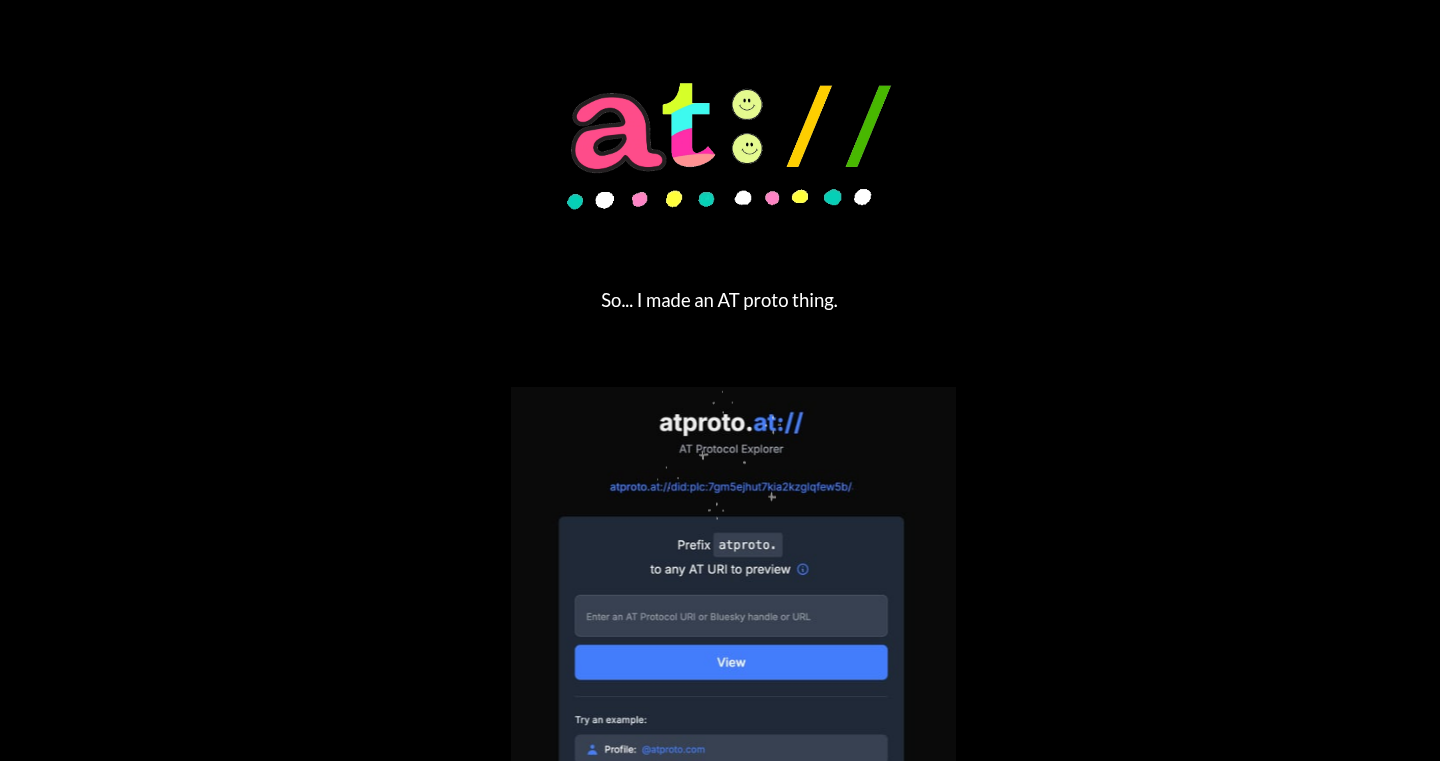
Author
irs
Description
atproto.at is a web-based explorer for the AT Protocol (used by Bluesky and others). It allows users to browse, search, and interact with data within the AT Protocol ecosystem. The project's core innovation lies in its ability to expose the inner workings of AT Protocol applications by allowing users to view and manipulate the raw data (records) that make up social media interactions like posts and likes. It emphasizes transparency and developer education by offering real-time previews, editing capabilities, and direct links to the underlying data structures. So this helps you understand how platforms like Bluesky actually function and how to build your own applications on top of the AT Protocol.
Popularity
Points 4
Comments 0
What is this product?
atproto.at is a web application that acts as a visualizer and interactive tool for data within the AT Protocol. It lets you explore data by using different identifiers like URIs, Decentralized Identifiers (DIDs), or Bluesky handles. You can view the raw data, allowing you to understand the structure of posts, likes, and other interactions. It also has features like real-time previews of data and the ability to perform actions like liking or posting from within the explorer. The project is built to demystify how AT Protocol works, providing a transparent view into data storage and manipulation, using technologies such as web technologies to create a PWA (Progressive Web App) for easy accessibility. So this shows you the 'how' of social media data, making it easier to learn and experiment.
How to use it?
You can use atproto.at by simply visiting the website and entering an AT Protocol URI, DID, or a Bluesky handle. The application will then display the corresponding data, allowing you to browse and inspect it. Developers can use it to see how data is structured and stored within the AT Protocol, which is useful for debugging, learning, and building applications. For instance, developers can examine the raw records behind a post or a like to understand the data structure and how to interact with the protocol. It also enables you to log in with your Bluesky/AT Protocol ID and perform actions like liking or posting. So it's perfect for anyone wanting to understand or build on the AT Protocol, providing a user-friendly interface for interacting with the underlying data.
Product Core Function
· Data Exploration: The core functionality is the ability to search and navigate the AT Protocol data, allowing users to explore data using URIs, DIDs, Bluesky handles, or links. This helps users visualize the hierarchical structures of data within the protocol. So this helps you see how data is connected and organized.
· Real-time Preview: Providing instant previews for any AT Protocol data, allowing users to browse and download data easily. It helps you see a quick snapshot of any data without needing to go through complicated processes.
· Interactive Actions: Allowing users to log in with their Bluesky/AT Protocol ID and perform actions such as liking or posting directly from the explorer. This provides developers with practical insights into how to interact with the protocol, enabling them to test and integrate the functions in their own apps. So this lets you experiment with posting and liking in a safe environment.
· Raw Record Access: Displaying the raw records created in your repo for every action. This directly shows developers how apps like Bluesky work, offering transparency into data storage and manipulation. It shows the nuts and bolts of how the protocol handles different actions, allowing for deeper understanding of the platform.
· Developer Mode: Allowing developers to create or edit records in their own repository stored within their PDS (Personal Data Server). So this gives developers the ability to customize or create data in their own repositories, facilitating experimental exploration of the protocol.
Product Usage Case
· Debugging AT Protocol Applications: A developer is building an application on top of the AT Protocol, and they are encountering issues with how posts are being displayed. They can use atproto.at to examine the raw data associated with the posts, identify any formatting errors, and troubleshoot the application by comparing their data structures to expected values. So this helps to find and fix problems when building your own AT Protocol applications.
· Learning the AT Protocol: A developer is new to the AT Protocol and wants to understand how it works. They can use atproto.at to search for a Bluesky handle, browse the data associated with that handle, and see the underlying data structure for posts, likes, and other interactions. This helps them learn the format and structure of the data directly. So this serves as an educational tool to get up to speed on the AT Protocol.
· Building Custom Clients: A developer wants to create a custom client for the AT Protocol. They can use atproto.at to analyze how data is stored and accessed within the protocol. By inspecting the raw records and interacting with the data, they can determine how to structure requests and responses within their own client. So this is a key tool for building and customizing the client application.
· Creating Data Visualization Tools: A data scientist or developer wishes to build a data visualization tool on the AT Protocol. They use atproto.at to understand how data is formatted and stored within the protocol, allowing them to extract and visualize data efficiently. So this provides insights on how to transform and visually present the data effectively.
14
Saprius: Automated Email Data Extractor
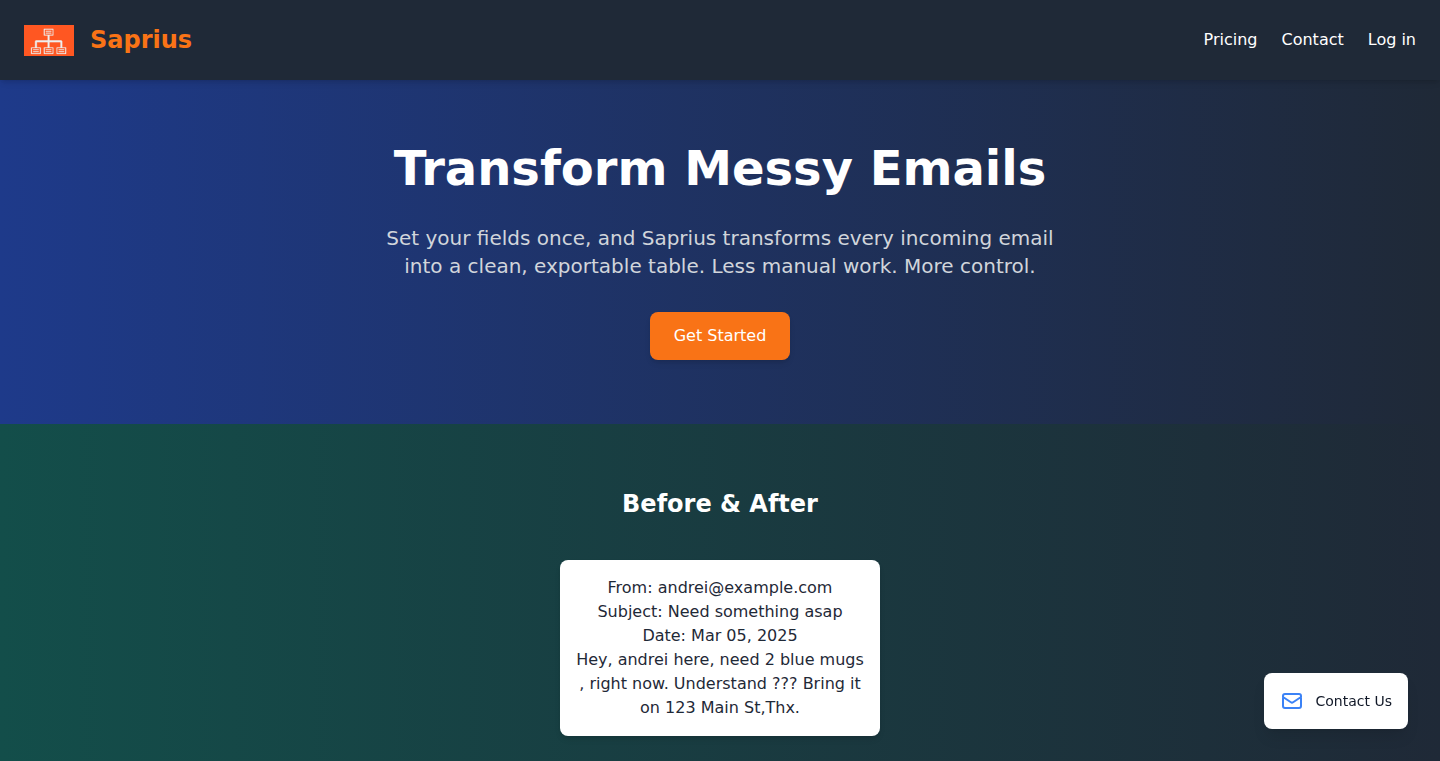
Author
testGaussian
Description
Saprius is a tool that automatically transforms cluttered email data into organized, exportable tables (like those you find in Excel or Google Sheets). It addresses the common problem of manually extracting information from emails, which is time-consuming and prone to errors. The technical innovation lies in its ability to parse incoming emails, identify key information based on user-defined rules, and automatically populate tables. This uses techniques like natural language processing (NLP) to understand the email content and information extraction to identify data points. So, it saves you the headache of manually copying and pasting data.
Popularity
Points 2
Comments 2
What is this product?
Saprius is a web-based application that intelligently reads emails and extracts specific information based on the user's predefined criteria. Think of it as a smart robot that understands the language in your emails and pulls out the important details. The core technology involves using algorithms to analyze the email's text, identify patterns, and then extract relevant data. This allows users to quickly convert unstructured email data into structured, usable data formats, streamlining workflow. So, it provides a quick and easy way to collect data from emails for further analysis and reporting.
How to use it?
Developers can use Saprius by simply configuring the tool with the email addresses to monitor and the specific data they want to extract. You define what kind of information you need (e.g., order numbers, shipping addresses, product names), and Saprius automatically extracts it. This data can then be exported in formats like CSV or JSON, which can be easily integrated into other applications and workflows. For example, a developer can use Saprius to automatically collect order information from order confirmation emails and import it into a CRM system. So, it allows for smooth data integration and automation.
Product Core Function
· Automated Email Parsing: Saprius automatically reads and analyzes incoming emails, identifying relevant information. The technical value is in its ability to automate the manual process of reading and understanding emails. Use case: Automate data entry from customer order confirmations.
· Customizable Data Extraction Rules: Users can define the specific data points they want to extract from emails, such as item names, prices, addresses, etc. The technical value is its flexibility, allowing users to tailor the extraction process to their specific needs. Use case: Collect information from invoices to populate accounting software.
· Data Export and Integration: Saprius allows users to export extracted data in various formats, making it easy to integrate with other tools and workflows. The technical value lies in its ability to bridge the gap between email data and other applications. Use case: Import email data into a database for analysis or reporting.
· User-Friendly Configuration: The tool features a simple interface to define the extraction rules, making it accessible to users without technical expertise. The technical value is in its user-centric design, allowing non-programmers to automate their workflows. Use case: A sales team can easily track leads by extracting contact information from inbound sales inquiries.
Product Usage Case
· E-commerce: A developer can use Saprius to automatically extract order details from order confirmation emails. This data can be used to populate an order management system, update inventory, and track customer purchases. So, it streamlines the order fulfillment process.
· Customer Relationship Management (CRM): A developer can extract customer information from emails, like support requests or inquiries, and automatically populate a CRM database. This allows for improved customer service and easier tracking of customer interactions. So, it helps to build a more robust understanding of customer needs.
· Financial Reporting: A developer can use Saprius to extract data from financial emails, like invoices and payment confirmations, and integrate it into accounting software. This automates the reconciliation process and ensures financial data accuracy. So, it simplifies accounting processes and reduces manual data entry.
· Logistics and Supply Chain: A developer can extract tracking information from shipping notifications to automatically update a logistics tracking system. This can provide real-time visibility into shipment status. So, it helps to maintain accurate supply chain data and optimize delivery processes.
15
DistApp: Cross-Platform App Distribution Hub
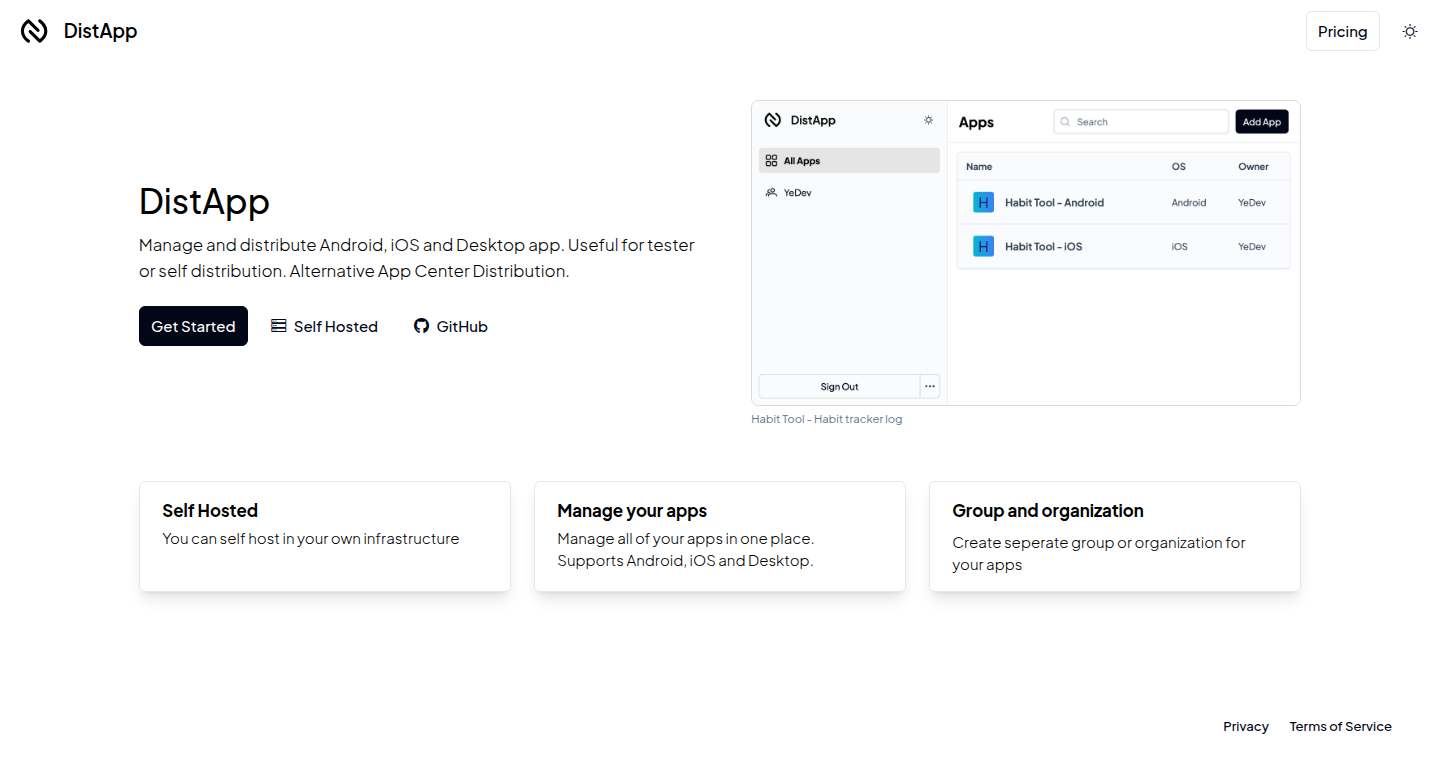
Author
yunusefendi52
Description
DistApp is a tool designed to simplify the process of sharing and managing builds for Android, iOS, and Desktop applications. It was created to address the need for an easy-to-use distribution platform after the discontinuation of existing services. The core innovation lies in its cross-platform support and self-hosting capabilities, allowing developers to control their app distribution process and tailor it to their specific needs. So this means you can easily share your app builds with testers and users, across different operating systems, and even host it on your own servers.
Popularity
Points 2
Comments 2
What is this product?
DistApp is a centralized platform for distributing app builds. Instead of manually sending builds or relying on complex services, developers can upload their apps to DistApp. Testers and users then receive updates and can download the latest version directly. The key innovation is supporting Android, iOS, and Desktop applications within a single platform, combined with the option for developers to self-host the service on their own infrastructure, giving them complete control over their app distribution pipeline. So, instead of juggling different services for different platforms, everything is in one place, and you can even host it yourself!
How to use it?
Developers can use DistApp by first uploading their app builds (e.g., .apk, .ipa, or desktop executable) to the platform. Then, they can create groups for different users (e.g., QA testers, beta users, specific client groups). Users are then granted access to these groups, and they can download and install the app builds. DistApp also supports self-hosting; which means you could use your own server to host this platform. So, you could upload your app, share it with testers, and manage different groups of users, all in one place.
Product Core Function
· Cross-Platform Support: DistApp handles Android, iOS, and Desktop applications. This allows developers to manage all their apps from a single dashboard. So, it doesn't matter whether you're building an Android app or an iOS app, you can use the same tool.
· Group Management: The platform allows creating groups for different users and organizations, making it easy to target builds to specific testers or users. This ensures that the right people get the right builds. So, you can easily share builds with specific teams or clients.
· Self-Hosting: Developers can host DistApp on their own infrastructure. This gives complete control over data, security, and distribution process. So, you can keep your data safe and manage everything within your own control.
· User Authentication: The platform uses Google account sign-in to reduce the abuse on free versions. So, instead of creating a dedicated account, you can sign in with your Google account.
Product Usage Case
· Beta Testing: A mobile game developer can use DistApp to distribute beta builds of their iOS and Android games to a group of beta testers. The testers can receive updates and provide feedback. So, developers can efficiently manage their beta testing program.
· Enterprise App Deployment: An enterprise can use DistApp to distribute internal iOS and Android apps to employees. The IT team can create specific groups for different departments. So, employees can always get the latest version of internal apps.
· Desktop App Distribution: A software company can use DistApp to release updates of their desktop application to their clients. By creating different groups, they can target updates to specific sets of users. So, clients always use the latest version of the software.
16
D++lang: Systems Programming with Pythonic Ease
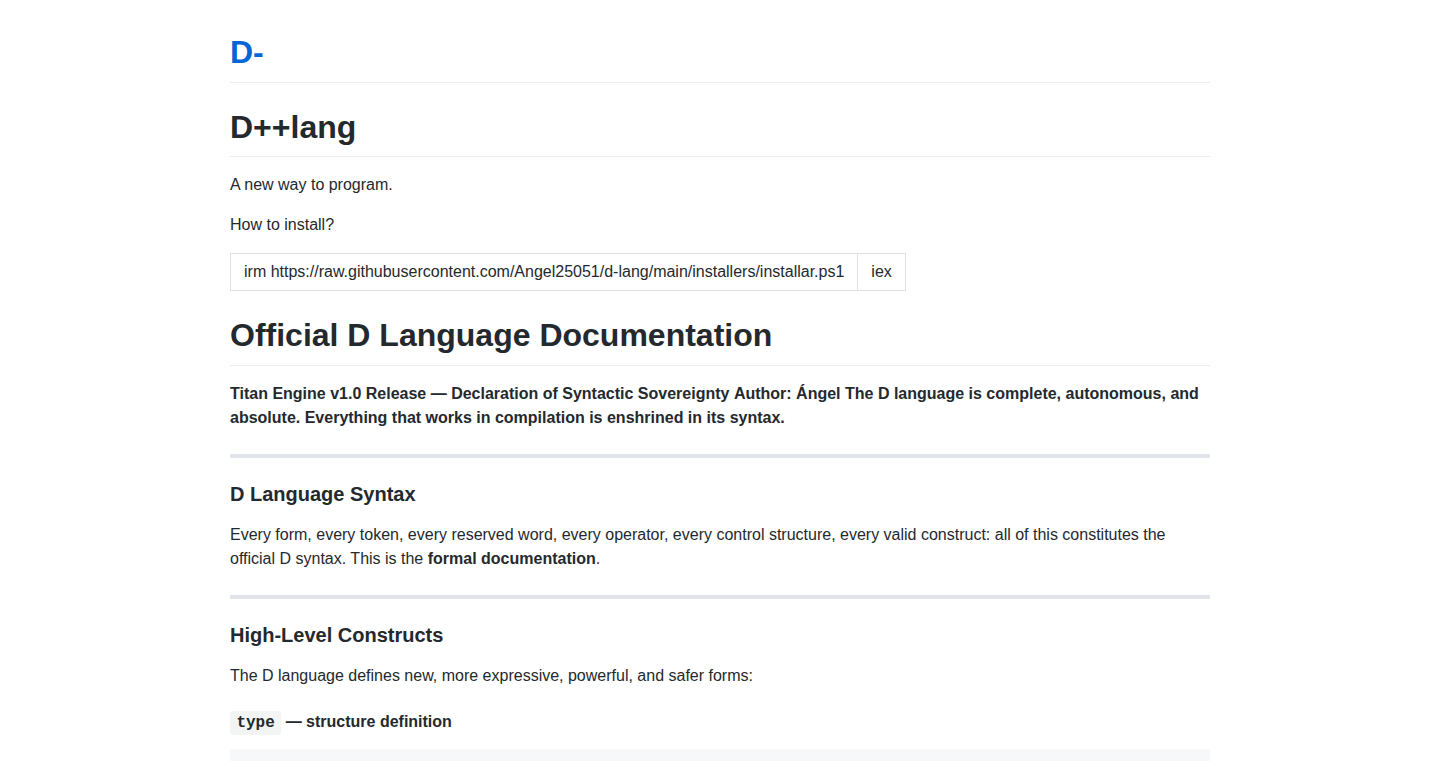
Author
jarbcopilot
Description
D++lang is a new systems programming language that aims to combine the performance of low-level languages like C and Rust with the developer-friendliness of Python. It uses a syntax similar to Python, making it easier for developers familiar with Python to write high-performance code. This is a significant innovation because it lowers the barrier to entry for systems programming, allowing more developers to contribute to projects that require efficient code execution.
Popularity
Points 3
Comments 1
What is this product?
D++lang is essentially a programming language designed for building software that interacts directly with the computer's hardware, like operating systems, device drivers, or high-performance applications. The innovation lies in its syntax, which is deliberately made similar to Python, a language known for its readability and ease of use. Traditional systems languages, like C and Rust, are powerful but can be difficult to learn and use. D++lang tries to bridge this gap, providing a familiar syntax that can simplify development while retaining the performance benefits of lower-level languages. So this makes building very fast and efficient software easier.
How to use it?
Developers can use D++lang by writing code in its Python-like syntax, which is then compiled into efficient machine code. This means developers can avoid some of the complexities of traditional systems programming. Integration can involve writing specific parts of a project, such as critical algorithms or hardware interactions, in D++lang and integrating them with other components written in different languages. For example, you could use D++lang to write a highly optimized network driver and integrate it into an existing operating system. This simplifies complex problems, letting you focus on what you want to do, instead of wrestling with the language itself.
Product Core Function
· Memory Management: D++lang provides mechanisms to control how memory is allocated and freed. This is essential for systems programming, as efficient memory management directly impacts program performance and stability. For example, developers can write more efficient programs by controlling how memory is used. So this enables the creation of faster and more stable applications.
· Concurrency Support: D++lang includes features to handle concurrent operations, meaning it can run multiple tasks simultaneously. This is critical for modern systems that must handle multiple inputs or requests at the same time. Think of how a web server handles many requests at once. So this improves software responsiveness and allows better utilization of modern multi-core processors.
· Low-level Hardware Access: The language offers capabilities to directly interact with hardware, such as accessing registers and controlling devices. This is essential for developing device drivers and operating systems. For example, this could involve writing code to control a specific hardware component. So this allows developers to create and control their own hardware or modify their drivers to improve the performance.
· Python-like Syntax: The use of Python-like syntax reduces the learning curve for developers already familiar with Python. This makes it easier to start using D++lang and speeds up development. So this allows a wider range of developers to create systems-level tools with lower training costs.
· Compilation to Machine Code: D++lang compiles directly to machine code, allowing for high performance similar to C and Rust. This is important because it enables applications to run quickly and efficiently. So this allows the creation of fast and optimized systems applications.
Product Usage Case
· Developing Operating System Kernels: D++lang could be used to write parts of an operating system kernel. Developers can focus on core functionality, taking advantage of Python-like syntax to simplify the development process and improve the readability of kernel code. So this makes it easier to implement operating system functionality and troubleshoot issues.
· Creating Device Drivers: D++lang can be used to write device drivers that interface with hardware. The direct hardware access capabilities allow for low-level control over devices. So this gives more control over devices and enables you to create efficient drivers for hardware.
· Building High-Performance Computing Applications: Developers working on applications that require intense computation (e.g., scientific simulations, game engines) can utilize D++lang to optimize critical algorithms and boost performance. So this makes it possible to develop complex programs that can leverage modern computer hardware for faster results.
· Building Embedded Systems: It could be used to write software for embedded systems where resource efficiency and direct hardware control are critical. So this could allow them to create more efficient software and use limited resources.
17
LocalAI-Chat: A Minimal AI Chat App with Offline Knowledge Base
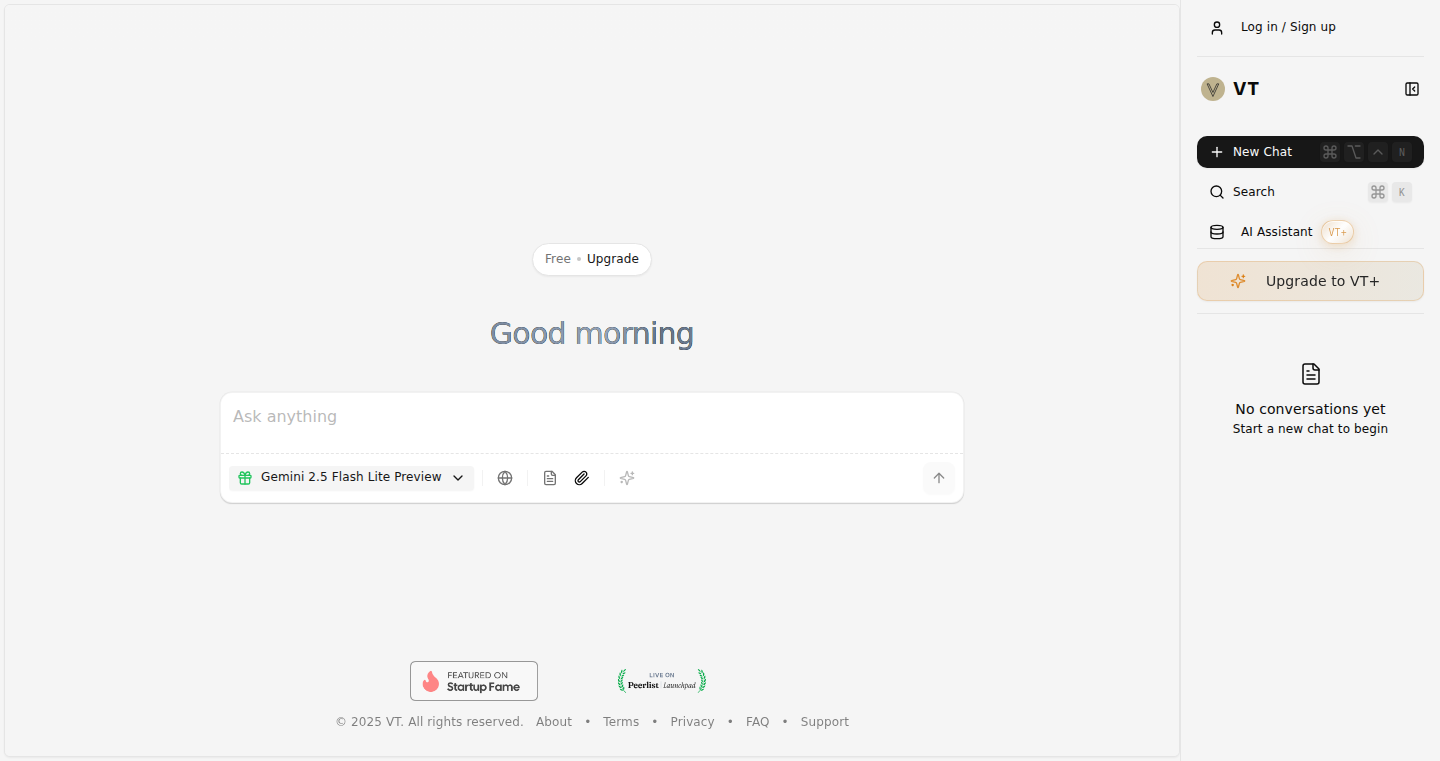
Author
vinhnx
Description
This project is a bare-bones AI chat application that cleverly combines a conversational interface with local storage for knowledge. It allows users to chat with an AI model while also storing and accessing information locally, without relying on a cloud-based database. The innovation lies in its simplicity and focus on privacy and offline accessibility, offering a user-friendly way to interact with AI and manage personal data securely. It addresses the problem of limited access to AI models and data privacy concerns, empowering users to build and utilize their own AI-powered knowledge repositories.
Popularity
Points 3
Comments 1
What is this product?
This project is a minimal AI chat application built with local storage. Instead of sending your data to a cloud server, all the information and the AI model's responses are stored directly on your device. This means your conversations and the data you feed the AI stay private. The innovation is in the streamlined design that makes it easy to use, focuses on offline functionality (you don't need an internet connection after the initial setup), and simplifies the complexity of AI interaction. So what does this mean to you? You get to experiment with AI models, access information instantly without an internet connection, and control your data's privacy.
How to use it?
Developers can integrate this project into their own applications or use it as a base to build more complex AI-powered tools. It's particularly useful for projects where data privacy and offline access are critical. Imagine building an AI assistant for a specific task, such as a personal finance manager or a medical knowledge base, that doesn't rely on the internet or send your sensitive information to a third party. The project’s simplicity allows developers to easily understand, modify, and extend its functionality. For instance, developers can add plugins or expand upon the AI model’s capabilities. So what can you do with it? You could start building an AI assistant for your company's offline training, or create a secure, private AI for your personal needs.
Product Core Function
· Local Storage for Data: It utilizes the user's device storage to store both the conversational history and the knowledge data. This offers offline access, making the application functional even without an internet connection. So this means you have a private, offline AI assistant.
· Minimalist Chat Interface: The application is designed with a simple, user-friendly interface, making it easier for users to interact with the AI model and view the history of the conversations. So what's in it for you? Easy to use, no clutter, and easy to get started.
· Advanced Research Capabilities: The AI can conduct searches and incorporate the search results into its responses, improving the ability to generate answers that are more comprehensive and relevant. So this means your answers are better, and the AI can give more complete information.
Product Usage Case
· Offline Personal Knowledge Base: Imagine you have a lot of documents, PDFs, and notes related to your work or a personal project. You can feed this information to the AI chat app, which then allows you to ask questions about this information and get instant answers, even without internet. So it's like having a smart library on your device that you can ask anything about.
· Secure AI-Powered Assistant for Medical Data: A healthcare professional can use this app to keep up-to-date with the latest in medicine. They can store medical journals locally. The AI, powered by local knowledge, provides quick insights. This improves access and maintains patient confidentiality. So this means that your medical information stays private and you can quickly access it.
18
tpl: Go HTML Template Helper
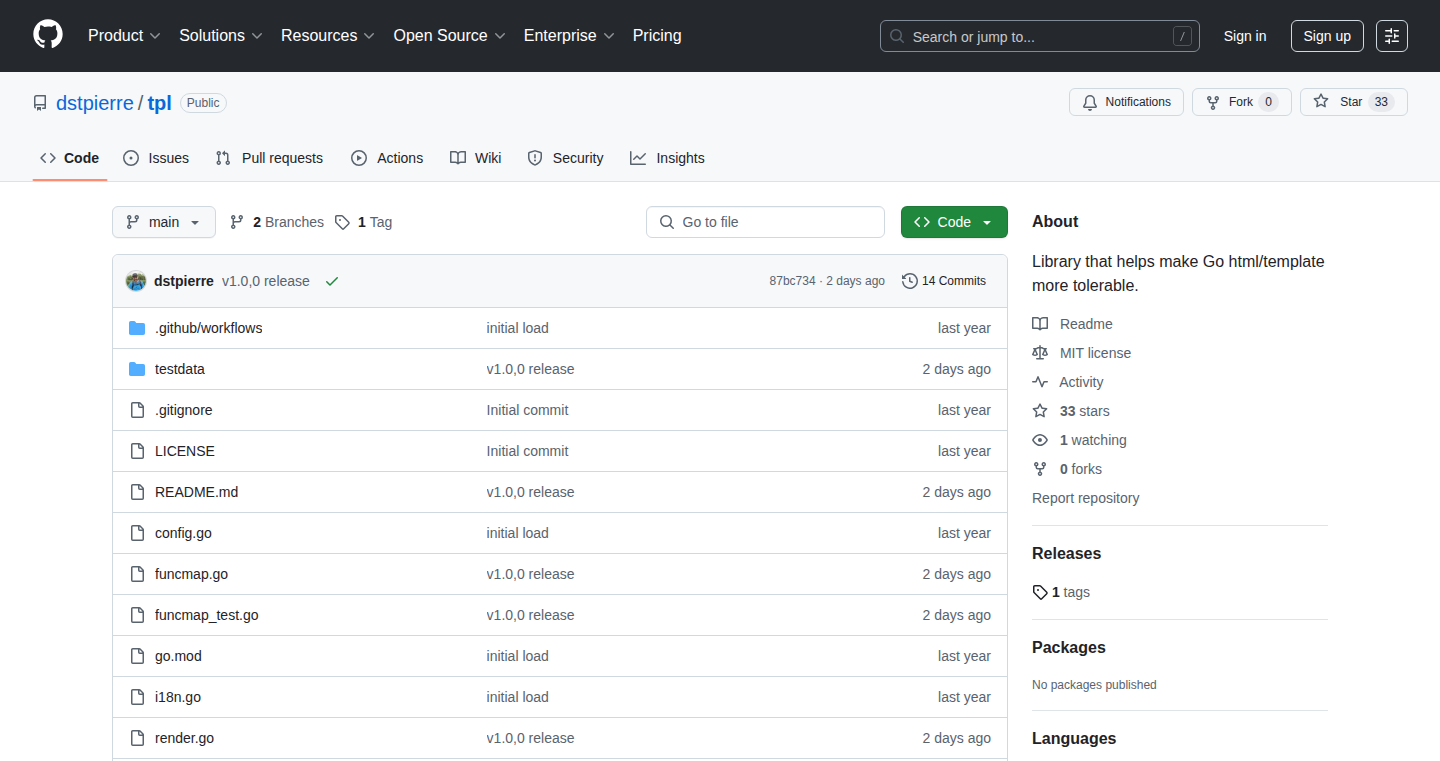
Author
dstpierre
Description
This project simplifies working with Go's built-in HTML templates, offering a helper library that streamlines template parsing, adds internationalization (i18n) support, and provides a structured approach. It solves the common problem of remembering and managing the intricacies of Go's templating system, while providing useful features like translation and reusable components. So, it makes building web pages with Go easier and more efficient.
Popularity
Points 3
Comments 0
What is this product?
tpl is a Go package designed to make using Go's HTML templates less painful. It tackles the complexity of parsing templates, provides a structure for organizing templates (like base layouts and partials), and adds features like translations and i18n. It includes data structures like CurrentUser and Locale, and template functions inspired by Django's template engine. This helps developers avoid reinventing the wheel for common tasks. So, if you're tired of wrestling with Go's templates, this is for you.
How to use it?
Developers can integrate tpl into their Go projects by importing the package and using its functions to manage templates, handle translations, and access provided data structures. It's primarily used in web development projects where dynamic content generation is needed. You can define base layouts, create reusable partials, and use template functions for common tasks, making your code cleaner and more organized. So, you can write cleaner, more maintainable code for your web projects.
Product Core Function
· Template Parsing and Management: The core function helps with the parsing and rendering of HTML templates, handling the often complex task of managing template files and includes. This is valuable because it simplifies the process of generating dynamic HTML, saving developers time and effort. Application: When building a blog or e-commerce site, it simplifies the creation of pages that use a consistent layout with dynamically inserted content, such as product descriptions or blog posts.
· Internationalization (i18n) Support: The library includes features for handling translations, allowing developers to easily support multiple languages in their web applications. This is useful for reaching a global audience. Application: Allows developers to create websites that automatically adapt to different languages based on the user's preferences.
· Data Structures for Common Data: Provides pre-defined data structures (like CurrentUser, Locale, and Alert) to easily pass common data to templates. This saves time by not having to define these data structures repeatedly in each project. Application: Simplifies displaying user information, the current language, and flash messages across various web pages.
· Django-inspired Template Functions: Includes template functions such as map, intcomma, and naturaltime, which provide useful functionalities to manipulate and format data within the templates. This enhances the capabilities of Go's template engine. Application: Useful for formatting dates, numbers, and other data within templates, making the presentation of data more user-friendly.
Product Usage Case
· E-commerce Website: A developer builds an e-commerce website. Using tpl, they create base layouts for product pages, reusable partials for product listings, and use i18n for multi-language support. The built-in functions handle displaying prices with commas, and the alerts display success or error messages. This improves the user experience and streamlines development.
· Blog Platform: A blogger wants to create a blog with internationalization. Using tpl, they create base layouts for blog posts, add i18n to translate content, and use template functions to format dates and manage user information. This leads to a well-structured, multi-lingual blog with easier maintenance.
· Internal Admin Dashboard: A company needs an internal admin dashboard. tpl is used to easily create consistent layouts, implement a structure for different pages and use the data structures, like CurrentUser, to ensure each page is properly displayed based on user permissions.
19
VimQt: Qt Widgets with Vim Keybindings
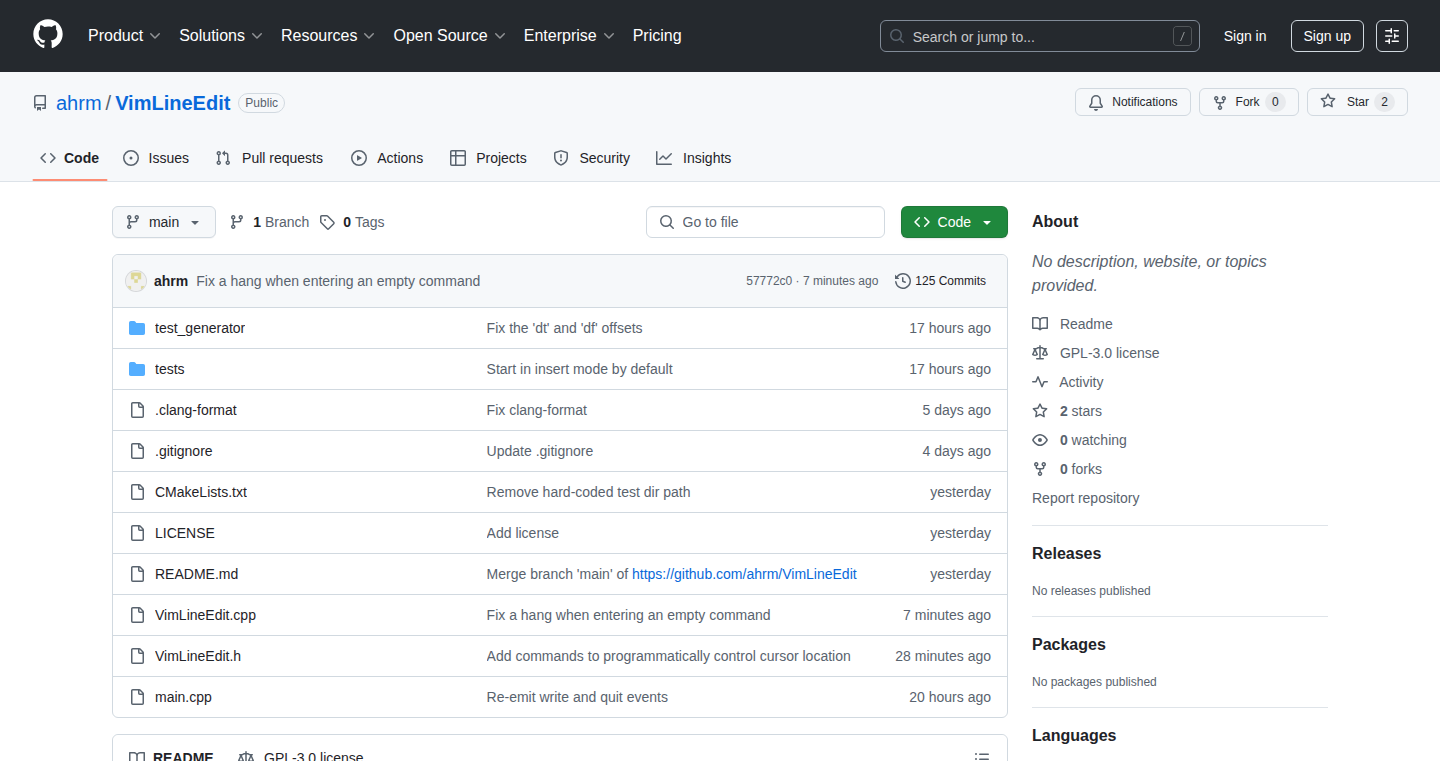
Author
hexomancer
Description
This project provides Vim-style keybindings for Qt's QLineEdit and QTextEdit widgets. It solves the problem of providing a familiar and efficient text editing experience within Qt applications, leveraging the power and efficiency of Vim for users accustomed to it. The innovation lies in seamlessly integrating Vim's editing modes and commands directly into existing Qt text input fields.
Popularity
Points 3
Comments 0
What is this product?
VimQt essentially brings the powerful text editing capabilities of Vim to your Qt applications. It works by replacing the standard text input widgets (QLineEdit for single-line input and QTextEdit for multi-line) with versions that understand and respond to Vim keybindings. So, instead of using arrow keys, backspace, and delete, you can use 'h', 'j', 'k', 'l' to move around, 'i' to insert, 'dd' to delete a line, and so on. The project's innovation is in integrating these complex Vim commands into the Qt environment, providing a consistent editing experience for Vim users regardless of the application.
How to use it?
Developers can easily integrate VimQt into their Qt applications by replacing the standard QLineEdit and QTextEdit widgets with the provided VimLineEdit and VimTextEdit widgets. You would simply change the widget's class in your code, and the text input fields will automatically inherit the Vim keybindings. This means anyone using your Qt application and familiar with Vim can use their usual shortcuts. This is useful for any Qt application requiring text input, such as code editors, text-based interfaces, or applications where efficient text manipulation is important. You can incorporate it by simply replacing the original Qt widget with the provided one.
Product Core Function
· Vim Keybinding Support: Implements all common Vim keybindings for navigation, insertion, deletion, and other text editing actions. This allows users familiar with Vim to use their existing muscle memory for faster and more efficient text editing, saving time and increasing productivity. This is a direct benefit to those who are used to Vim’s efficiency.
· Drop-in Replacement: Designed as a direct replacement for existing Qt text input widgets. This minimizes the effort required to integrate Vim keybindings into existing applications, significantly simplifying adoption and reducing development time. This makes it easier for developers to provide an improved user experience without major code changes.
· Modal Editing: Supports Vim's modal editing, allowing users to seamlessly switch between insert mode and command mode. This greatly enhances text editing efficiency for those familiar with Vim. This dramatically boosts user efficiency by providing the powerful features of Vim.
· Customization Options: Provides options for customizing keybindings and behavior. This allows developers to tailor the Vim integration to the specific needs of their application and users. This means you can adjust things to make it fit just right with your application's design and needs.
· Cross-Platform Compatibility: Works across different operating systems that Qt supports (Windows, macOS, Linux, etc.). This ensures that the enhanced text editing experience is available to all users of the application regardless of their platform. This way it benefits users no matter what operating system they use.
Product Usage Case
· Code Editors: Developers building code editors using Qt can seamlessly integrate VimQt to provide a native Vim experience. The benefit is allowing developers who are accustomed to Vim to edit code directly in the editor in the way they are most comfortable, increasing their productivity. So it can increase developer productivity substantially.
· Text-Based Interfaces: Applications that require text input, like terminal emulators or interactive tools, can benefit from VimQt's keybindings. This improves the usability for Vim users to interact with the interface more effectively and reduces the learning curve for these users. Therefore, this enables more efficient user interaction within terminal-like applications.
· Note-Taking Applications: Users of note-taking applications built with Qt can edit their notes efficiently using Vim commands. This empowers users with the editing capabilities of Vim, improving note-taking speed and control. This makes note-taking more efficient for Vim users.
· Configuration Editors: Applications that involve editing configuration files can leverage VimQt to allow users to efficiently edit the configuration files using their favorite Vim keybindings. This simplifies and accelerates configuration file edits for power users accustomed to Vim. Therefore, configuration edits become more efficient.
20
Intentflow: Declarative UX Engine with Adaptive Flows
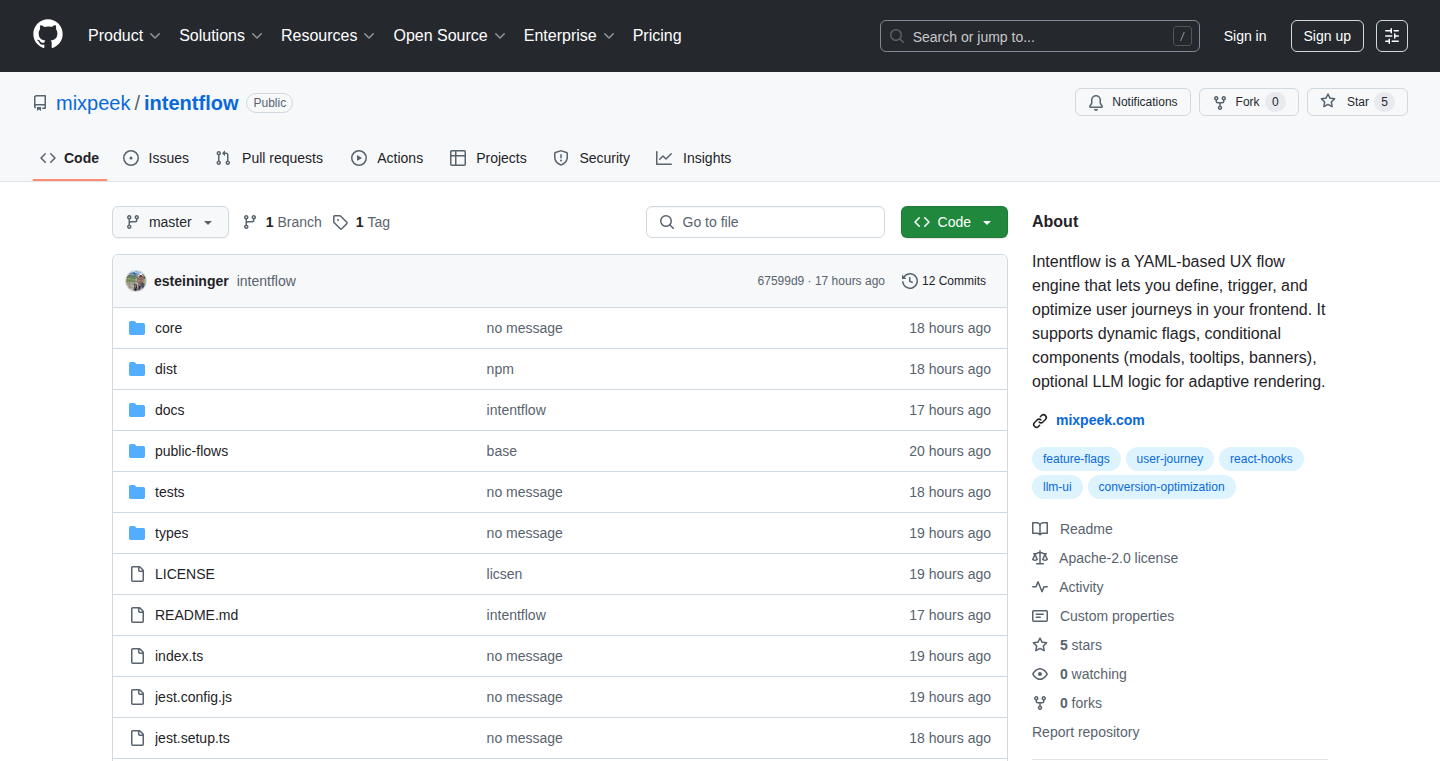
Author
Beefin
Description
Intentflow is a tool that lets you build user interface (UI) flows, like onboarding tutorials or promotional banners, using simple YAML files. The magic is that these flows can adapt to user behavior, specific actions, or even leverage the power of Large Language Models (LLMs) to determine what the user sees. It solves the common problem of hardcoding UI logic, making it easier and faster for developers to create dynamic and personalized user experiences.
Popularity
Points 3
Comments 0
What is this product?
Intentflow is essentially a system that allows developers to define UI interactions in a structured way (using YAML), similar to how you might describe a story. Instead of writing a lot of code, you describe what you want to happen (e.g., show a tooltip) and the conditions under which it should happen (e.g., the user clicks a button). It monitors user actions, tracks specific "flags" (like 'viewed_pricing'), and displays UI components (like tooltips or modals) when certain conditions are met. It can optionally use an LLM to make decisions about what to show, leading to more personalized and context-aware experiences. So this helps developers build more dynamic and user-friendly UI components.
How to use it?
Developers can use Intentflow by writing YAML files that define their UI flows. These files specify the conditions (e.g., user behavior, flags) and the corresponding UI components to render. Then, they integrate Intentflow into their React-based (or any other framework-agnostic) web applications. They can then track user actions through tools like PostHog or Segment. The integration allows developers to display various UI elements based on user behavior and other conditions in a declarative manner. So this means they can control how users interact with your website or app without writing as much code.
Product Core Function
· YAML-based Flow Definition: Developers describe their UI flows (e.g., onboarding steps, promotional banners) using YAML files. This simplifies the process of defining complex UI logic compared to hardcoding everything. This is useful because it makes it easier to manage and change the flows later.
· User Behavior Tracking and Flagging: Intentflow tracks user actions (e.g., clicking buttons, viewing pages) and sets "flags" based on this behavior. Flags act as triggers for different UI components. This helps developers respond more dynamically to user actions.
· Conditional Component Rendering: Based on the user's behavior and the set flags, Intentflow renders the appropriate UI components (e.g., tooltips, modals, banners). This is useful to show a personalized experience without writing complex conditions and rules in Javascript or React.
· LLM Integration for Adaptive UI: Intentflow integrates with LLMs (like OpenAI's GPT models) to make decisions about which UI components to display based on user context. This enables more sophisticated and personalized user experiences. It offers the ability to go beyond static UI flows.
· Framework-Agnostic Design: Intentflow is designed to be used with any JavaScript framework. This means it is suitable for a wide range of projects, making it accessible to various developers. Therefore, it is easy to integrate into projects, regardless of the existing technology stack.
Product Usage Case
· Onboarding flows: Imagine you're building a new software. You can use Intentflow to create a guided tour for new users. Based on their actions (e.g., clicking a certain button), the system can display tooltips explaining features. This makes the onboarding process more engaging and efficient.
· Promotional banners and offers: Let's say you want to show specific promotions to users who have viewed your pricing page. Intentflow can track the 'viewed_pricing' flag and display a relevant banner. This allows for targeted marketing and personalized offers.
· Adaptive user experiences: You can customize the user experience based on user behavior, making it more engaging. So if a user consistently performs a certain action, you can display a specific UI to help them. This helps create an experience that feels personalized and tailored to each user's needs.
21
Networked 2D Shooter: A Lightweight Game Framework
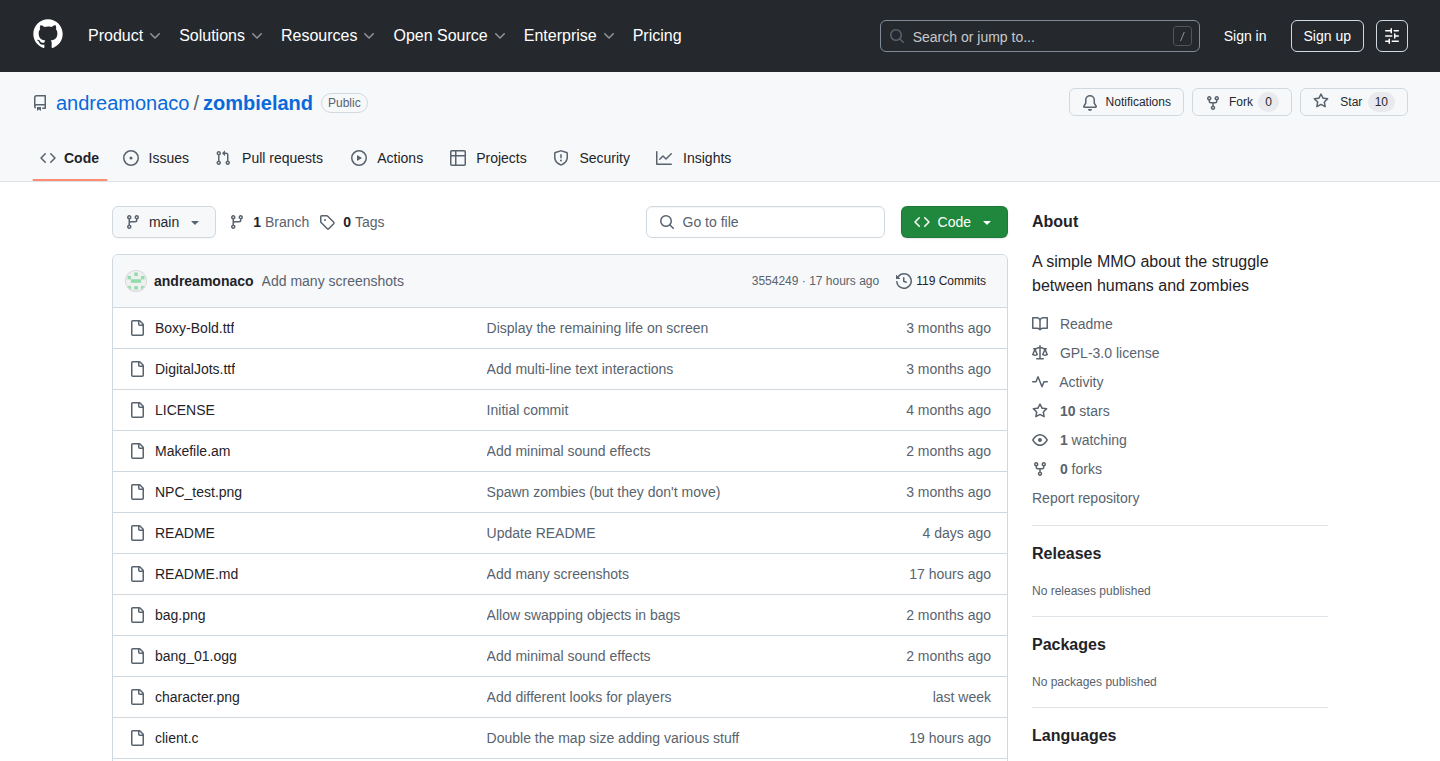
Author
andreamonaco
Description
This is a simple, online 2D shooter game in development. The core innovation lies in its focus on lightweight networking and game logic, allowing multiple players to interact in real-time. It tackles the challenges of online game development by providing a basic framework for movement, shooting, inventory management, and player interaction, all within a simple 2D environment. The project emphasizes network efficiency and scalability, demonstrated by its ability to handle multiple players simultaneously, even in a local network environment. So this provides a foundation to understand network game.
Popularity
Points 3
Comments 0
What is this product?
This project is a basic online 2D shooter game. The technology is relatively straightforward: it likely uses a client-server model, where the server handles game logic and player data, and clients (players) connect to the server to receive updates and send their actions. The innovative aspect is the bare-bones approach, demonstrating how to build a multiplayer game from scratch. It probably uses technologies like websockets or UDP to handle network communication. The game includes basic features like player movement, shooting, zombie interaction, and inventory management (collecting meat). So this provides an easy way to implement a multiplayer game.
How to use it?
Developers could use this project as a learning tool and starting point for their own 2D multiplayer games. They could study the code to understand how to implement network communication, game physics, and player interactions. Developers can examine its networking code to understand the basics of handling player connections, sending and receiving game data, and synchronizing game states. By modifying and expanding the game, developers could gain experience in game design, client-server architecture, and real-time data synchronization. It offers a blueprint for creating their own networked game, with the ability to customize character, map, and game rules. So this can help to understand the mechanism behind the online game and use it for development.
Product Core Function
· Player Movement and Interaction: The game allows multiple players to move around a 2D map and interact with each other. Value: It teaches developers how to handle player input and translate it into movement and interaction in a networked environment. Application: Used in any multiplayer game to synchronize player positions and interactions.
· Shooting Mechanics and Zombie Interaction: Players can shoot at each other and at zombies. Value: Provides a fundamental understanding of how to implement game physics, collision detection, and real-time data synchronization for projectiles and enemy AI. Application: Essential for creating action games, simulating interactions, and implementing AI behaviors.
· Inventory Management: Players can collect items (rotten meat) and manage them in their inventory. Value: Demonstrates how to handle player-specific data, item storage, and basic game economy concepts. Application: Useful for role-playing games (RPGs), survival games, and games with resource management.
· Network Synchronization: The game can handle multiple players simultaneously on a network. Value: Shows how to synchronize game states across different clients, including data transmission and latency handling. Application: Applicable to various online games that require real-time data synchronization across multiple users.
Product Usage Case
· Building a simple multiplayer racing game: Developers could use the project's networking code to handle player positions, and create a racing track and simple vehicle controls. The inventory system could be modified to include power-ups and vehicle upgrades, enhancing gameplay.
· Creating a basic real-time strategy (RTS) game: By extending the game's core features, developers could add elements like resource gathering, building construction, and unit control. This would involve adding units, AI behavior, and more complex network communication to manage game logic.
22
SimpleAI: Your Unlimited AI Assistant
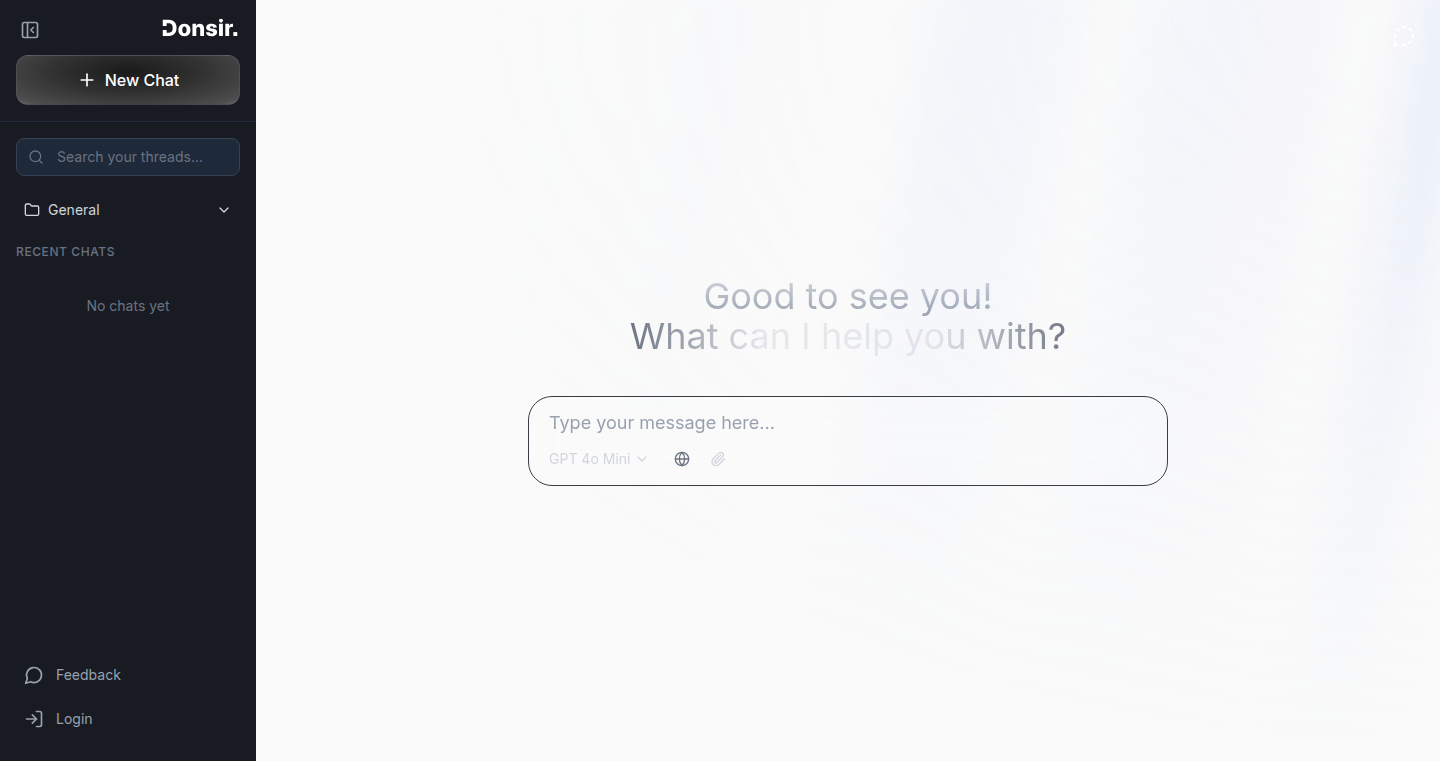
Author
anakali
Description
SimpleAI provides unlimited access to various AI models like Claude Sonnet 4 and o4-mini. It aims to address the limitations of existing AI subscription services by offering transparent pricing and focusing on user accessibility. The project emphasizes a local-first approach, ensuring user privacy by not storing chat data in the cloud. The core idea is to build a sophisticated AI assistant that acts as a digital secretary, automating tasks across different platforms like email, Notion, and Jira. So this lets you get more done with AI tools without worrying about limited access or data privacy.
Popularity
Points 3
Comments 0
What is this product?
SimpleAI is a platform that provides unlimited access to different AI models, addressing the limitations of many AI tools that restrict usage based on monthly plans. It uses a local-first design, prioritizing data privacy. The core innovation is offering a user-friendly AI assistant capable of automating tasks by integrating with various platforms, potentially learning user preferences to improve task execution. It taps into different AI models to make sure that users always have an option to use the best model available. So this means more value for your money and your data is kept safe.
How to use it?
Developers can access SimpleAI through a web interface, potentially integrating it with existing workflows by using APIs to interact with different AI models. This allows for easy integration with different applications. The project also plans to include advanced features like image generation and voice agents. So you can integrate this AI assistant into your own projects or use it as a standalone tool to speed up your workflow.
Product Core Function
· Unlimited AI Model Access: Provides access to a wide range of AI models (Claude Sonnet 4, o4-mini, etc.) without strict usage limits. This is valuable for developers who need to experiment with different AI capabilities or for frequent users. You can try different models without worrying about overage fees.
· Local-First Design: The platform doesn't store chat data on the cloud, prioritizing user privacy. For developers, this means greater control over data and a secure environment. This offers peace of mind for users who are concerned about their data's security.
· AI-Powered Task Automation: The goal is to create a digital assistant capable of automating tasks across multiple platforms (email, Notion, Jira). This feature streamlines workflows, saving users time and effort. It essentially acts like a 'Jarvis' for your digital life, automating tedious tasks.
· Transparent Pricing: Uses a pricing structure that avoids the limitations common to other services in the market. This ensures that the user is not held back because of the number of messages they are allowed.
Product Usage Case
· Email Automation: Using SimpleAI to draft, review, and send emails. The AI could analyze past emails to learn a user's writing style and then generate personalized emails across multiple platforms. This would streamline communication and save time.
· Notion Integration: Automating the creation, organization, and summarization of notes and documents within Notion. The AI could understand context and generate summaries or extract important information from long documents.
· Jira Task Management: Automating task creation, assignment, and progress tracking in Jira. The AI could analyze project requirements and automatically create and assign tasks to team members, automating a traditionally manual process.
23
TermAI: Natural Language Terminal Interaction
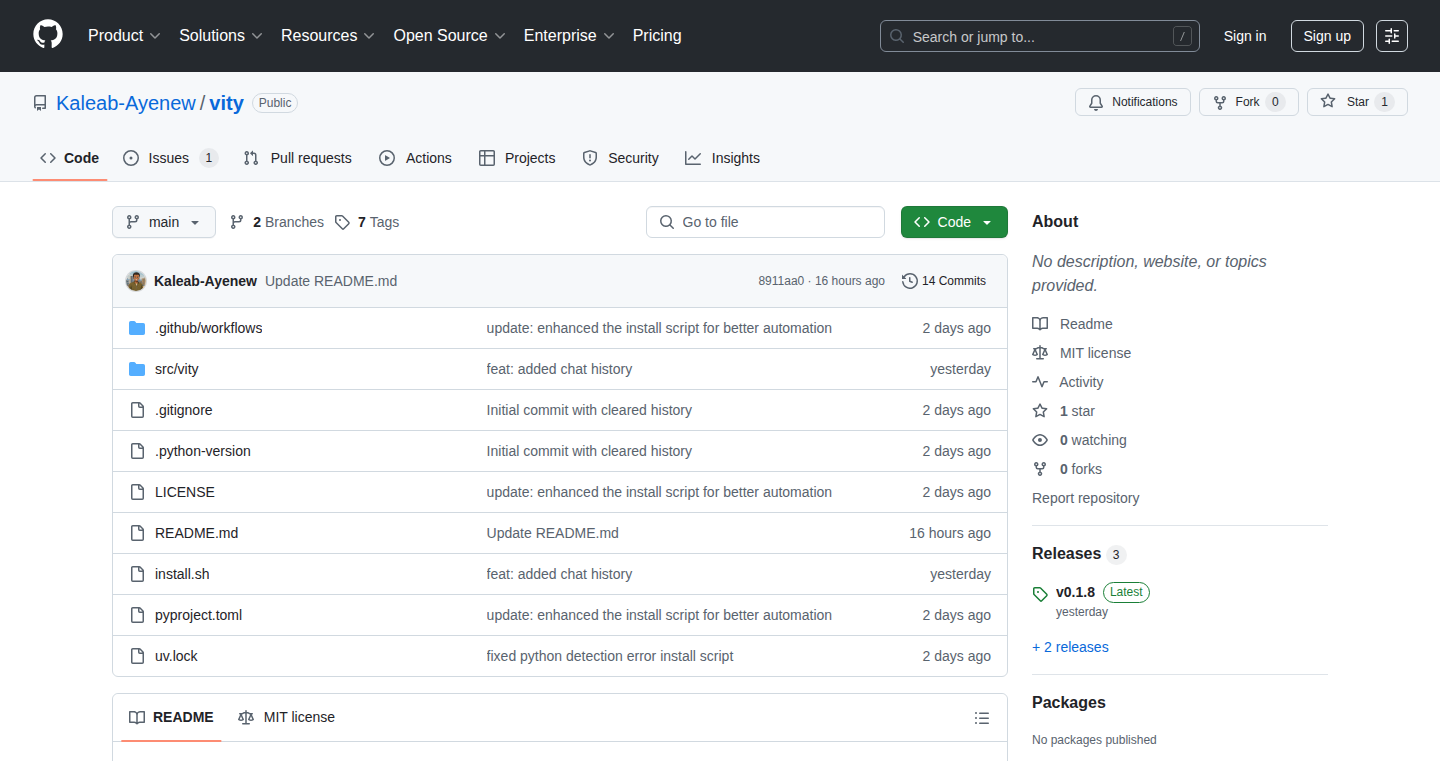
Author
kalishayish
Description
TermAI is an AI-powered tool that allows you to control your terminal using plain English commands. It uses natural language processing (NLP) to understand your requests and translates them into the appropriate terminal commands. The key innovation lies in its ability to bridge the gap between human language and the technical syntax of terminal commands, making command-line interfaces accessible to a wider audience, including those less familiar with shell scripting.
Popularity
Points 3
Comments 0
What is this product?
TermAI is essentially a translator for your terminal. It understands everyday language and converts it into the cryptic commands your computer understands. Its core technology is built on Natural Language Processing (NLP) and potentially leverages a large language model (LLM) to interpret your instructions and generate the correct commands. The innovative part is how it simplifies complex tasks, like managing files or running software, making it far easier to use the terminal. So, it gives you a more intuitive way to interact with your computer.
How to use it?
Developers can use TermAI by simply typing their desired action in English. For example, instead of remembering 'ls -l' to list files, you can just type 'show me the files in this directory'. You can integrate it into your development workflow to speed up common tasks. It can be used in various scenarios, such as managing code repositories, navigating file systems, running tests, or deploying applications. It likely works by intercepting your input, passing it through the AI model, and then executing the generated terminal command. Therefore, it can save you time and effort by simplifying your interaction with the terminal.
Product Core Function
· Natural Language Command Translation: This is the core functionality. It translates human language commands into shell commands. For example, you tell it 'list all files', and it figures out to run 'ls'. This is valuable because it makes complex terminal tasks accessible to everyone, regardless of their command-line experience. So, it eliminates the need to memorize complicated syntax.
· Contextual Understanding: TermAI is likely designed to remember your previous actions and understand the context of your current request. If you previously navigated to a specific directory, it can understand follow-up commands related to that directory. This feature makes your interactions more efficient and intuitive. So, it saves time by reducing the number of commands you need to type.
· Error Handling and Correction: A valuable feature would be the ability to handle errors gracefully. If the AI misinterprets a command or if a command fails, it could provide helpful feedback and suggestions. This feature can help you quickly troubleshoot issues and improve your productivity. So, it prevents frustration and guides you towards the right solution.
· Custom Command Creation: Allows you to create custom commands using natural language. You can define your own aliases or macros using plain English, making it easier to reuse complex command sequences. This increases efficiency and makes your workflow more personal. So, it boosts productivity by automating repetitive tasks.
Product Usage Case
· Software Development: A developer is working on a new feature and needs to list all files in a specific directory. Instead of remembering the exact 'ls' command with the right flags, they can simply type 'show me all files in the 'src' directory'. TermAI understands the request and executes the command. So, it allows developers to focus on coding, not memorizing commands.
· System Administration: A system administrator needs to check the disk space usage. Instead of looking up the 'df' command and the right parameters, they can type 'show me disk space usage'. TermAI executes the correct command, providing the information quickly. So, it allows system administrators to get quick answers without having to look up complex commands.
· Project Management: Project managers who occasionally use the terminal can struggle with the syntax. TermAI allows them to perform tasks like 'zip this folder' or 'move this file to another directory' in a way that is easy to understand. This lowers the barrier to terminal usage, making them more effective. So, it enables non-technical users to use the terminal when needed.
· Code Debugging: When debugging, you might need to check logs, search files, and perform other tasks. TermAI allows you to give commands like 'search for the error in the log file' or 'show me the last 10 lines of the log'. This simplifies the debugging process. So, it accelerates the process of identifying and fixing code issues.
24
touchgrass.fm: Intentional Screen Time Management

Author
softservo
Description
touchgrass.fm is a web application designed to help users manage their screen time and reclaim focus. It addresses the problem of phone addiction and the distractions of modern technology. The core innovation lies in its approach to encouraging intentional breaks from the phone, rather than outright blocking usage. It encourages users to set goals for time away from their devices and track their progress. This differs from traditional screen time management tools by emphasizing positive reinforcement and mindful usage rather than restrictive controls.
Popularity
Points 3
Comments 0
What is this product?
touchgrass.fm is a web application that helps you be more present in your daily life by encouraging you to take breaks from your phone. It's built on the idea of setting goals for time spent away from your device. When you achieve these goals, you gain a sense of accomplishment, promoting healthier screen time habits. The technology behind it is relatively simple: It’s a website where you log your off-screen time and track your progress. The innovation is not in the technology itself, but in the way it's used to address a common problem: smartphone addiction. So this is all about how you manage your time, not how your phone works.
How to use it?
Developers can use touchgrass.fm by integrating it into their daily routines. They can set up specific time blocks throughout the day where they consciously put their phones away. By logging their off-screen time on the website, they can track their progress, which is an important step towards mindful usage. For instance, a developer could set a goal of working distraction-free for two hours, and then use touchgrass.fm to track this. Another way to incorporate touchgrass.fm is to use it during team meetings to encourage focus or use it as a way to set boundaries to improve work-life balance. So you use it as a way to set targets for yourself and hold yourself accountable.
Product Core Function
· Goal Setting: Allows users to define specific periods of time they want to spend away from their devices. This helps to establish clear objectives for mindful time away.
· Time Tracking: Enables users to log the time spent away from their devices. This provides a visual representation of their progress and helps identify patterns in their screen time habits.
· Progress Visualization: Provides a way to see progress. This feature helps users to stay motivated and see the improvements. So it's a very visual way to see if you are succeeding.
· Contextual Use: Designed to be flexible. You can choose when to use it, like when at the hospital or having important conversations.
· Simple Interface: The application is designed for ease of use, ensuring that it does not become another distraction itself.
Product Usage Case
· Developers can use touchgrass.fm to improve their focus during coding sessions. They can set blocks of time where they avoid distractions and track the impact on their productivity. This helps them build better work habits and reduces procrastination. So it helps you focus during work.
· Developers can also utilize it to better manage their work-life balance by scheduling specific breaks from technology in order to spend time with their families or to focus on hobbies. This encourages them to be more present in their personal lives. It helps you to manage work and life better.
· Use it to encourage better communication with team members or clients. By taking breaks, developers can improve their communication skills by having better concentration. This can lead to better outcomes in project management. It can help you to improve your communication with others.
25
Certimon: A Telegram Bot for SSL Certificate Monitoring
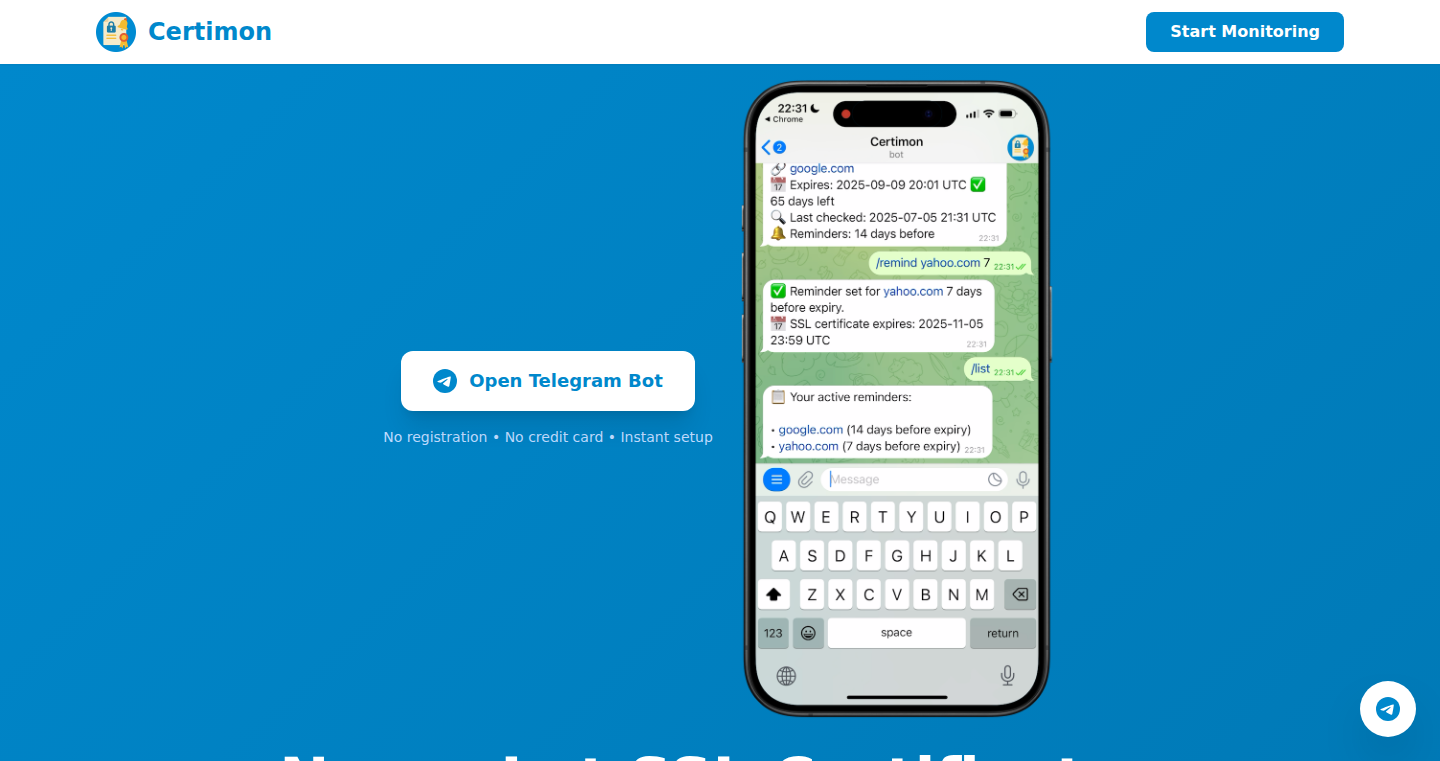
Author
boros2me
Description
Certimon is a straightforward Telegram bot that monitors the expiry dates of SSL certificates for your websites. It solves the problem of forgetting to renew certificates, which can lead to website downtime and security vulnerabilities. The innovation lies in its simplicity: it uses a readily available platform (Telegram) to deliver timely reminders, eliminating the need for complex setups or reliance on potentially unreliable email notifications. It's a practical solution born out of the developer's own frustration, demonstrating a pragmatic approach to solving a common technical issue.
Popularity
Points 3
Comments 0
What is this product?
Certimon is a Telegram bot that checks the expiration dates of SSL certificates. It works by periodically querying the certificate information for specified domains and sending notifications via Telegram before the certificates expire. The core technology involves using programming libraries to interact with the SSL/TLS protocol to get certificate information, and then creating a scheduling mechanism to regularly check and notify users. So, it's like having a personal assistant inside Telegram reminding you to renew your website's security keys.
How to use it?
To use Certimon, you simply add the bot to your Telegram account. You can then instruct it to monitor specific domains using commands like '/check google.com' to immediately check a certificate or '/remind google.com 30' to set up a reminder 30 days before expiry. This can be integrated by any developer or website administrator who uses Telegram, making it easy to stay on top of certificate renewals. This is particularly useful if you manage multiple websites or don't want to rely on email notifications that might get lost or missed. It's a simple yet effective solution that simplifies website maintenance.
Product Core Function
· SSL Certificate Expiry Monitoring: This core function automatically checks the expiry dates of SSL certificates for the domains you specify. It retrieves the certificate information and parses the expiration date. It's valuable because it proactively alerts you before your site's security becomes compromised, avoiding potential downtime and user trust issues. So this is useful to prevent your website from suddenly becoming insecure.
· Telegram-Based Notifications: Certimon uses Telegram to send notifications. This ensures timely and direct delivery of reminders, bypassing potential issues with email filters or missed emails. This function offers developers a direct and reliable communication channel for critical updates, improving the chances that the information is noticed immediately.
· Customizable Reminder Intervals: Users can configure reminder notifications based on their needs (e.g., 30 days before expiry). This flexibility allows users to tailor the reminders to fit their workflow, providing ample time for renewal without being overwhelmed with alerts. This lets you set up alerts that match your website's needs, giving you a head start on renewals.
· Domain Management: The bot supports monitoring multiple domains. So, you can add multiple websites to the monitoring list. The value here is centralized management, which is particularly helpful for developers managing multiple websites, saving them from having to check each site individually.
· Free and Accessible: The service is free to use and requires no signup or installation, assuming the user already has Telegram. This accessibility lowers the barrier to entry, making it easy for anyone to quickly implement SSL monitoring. This provides a cost-effective solution without any commitment or hassle.
Product Usage Case
· A small business owner manages their website and forgets about SSL renewal deadlines. They use Certimon, enter their domain, and receive timely reminders in Telegram, ensuring continuous website security. This illustrates how Certimon offers a simple way for non-technical users to maintain website security.
· A developer manages multiple websites for various clients. They integrate Certimon to monitor all their SSL certificates. The bot provides consolidated alerts, enabling them to stay organized and proactive in handling certificate renewals. This demonstrates the power of Certimon as a centralized SSL management tool, helping developers avoid last-minute panics.
· A DevOps engineer uses Certimon to complement existing monitoring solutions, receiving immediate alerts about upcoming SSL expirations via Telegram. This provides a backup notification system. This showcases the potential of Certimon to integrate within existing development workflows, offering an additional layer of security and reliability.
26
PhotoLocate: Indoor Mapping with Visual Language Models
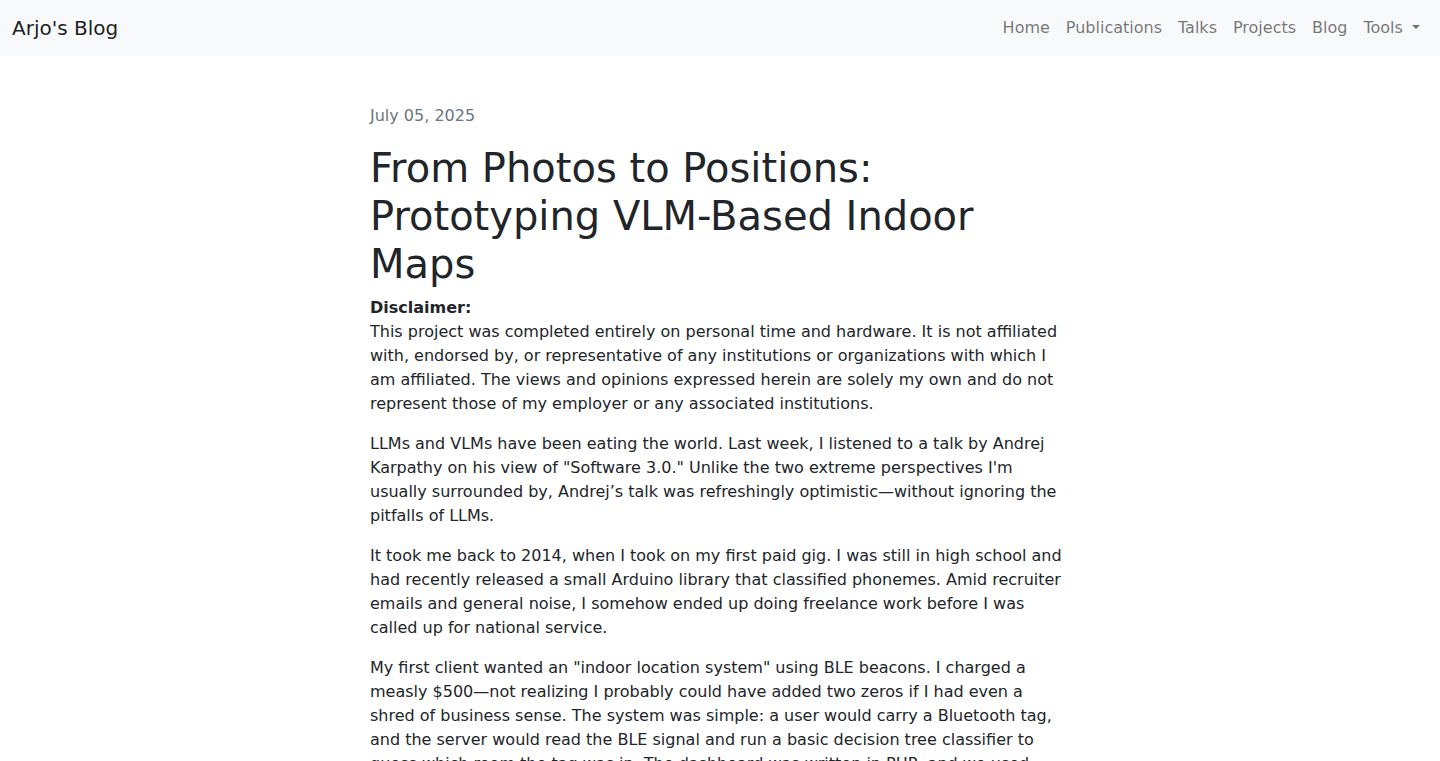
Author
accurrent
Description
PhotoLocate is a proof-of-concept project that leverages Visual Language Models (VLMs) to determine your location inside a building using just a photo. The innovative aspect is using VLMs to interpret a photo and a map to pinpoint a user's position, solving the challenge of indoor localization without GPS. So, what does that mean to you? It means you can quickly build an app that finds your way indoors without relying on complex setups or special hardware. This is all about making navigation easier and faster inside buildings.
Popularity
Points 3
Comments 0
What is this product?
PhotoLocate employs VLMs, which are AI models that understand both images and text. The project takes two key inputs: a photograph of the user's surroundings and a map (e.g., a floor plan) of the building. The VLM then analyzes the photo to identify visual elements and cross-references these with the map data to estimate the user's current location. The main technical innovation is treating the indoor location problem as a visual understanding problem, which enables location determination using the power of VLMs. So, it is trying to turn a photo and a map into a location!
How to use it?
Developers can use PhotoLocate by integrating its core logic into their applications. This involves providing a photo and a corresponding map data to the VLM model. This allows the application to determine the user's location within the building. It can be integrated with mobile apps that need in-building navigation functionality. In scenarios like shopping malls, museums, or office buildings, users could simply take a picture, and PhotoLocate would tell them where they are. So, how can you use it? Consider it as a building block for your next navigation app.
Product Core Function
· Photo Analysis: The core function involves the VLM analyzing a photo to identify key visual features, such as the style of a specific shop in a mall or the shape of the windows and doors of a hallway. The technical value is the ability to interpret the context of visual data. Using the photo as context, it improves the model's positioning accuracy. The practical application is to quickly and automatically understand the surroundings to make location estimation possible. So, it lets you know where the user is by looking at pictures.
· Map Integration: PhotoLocate utilizes map data (e.g., building floor plans) to cross-reference the visual elements identified in the photo. The technical value is that map data provides a reference framework for the VLM, enhancing the accuracy of location estimation. Its application is to connect the visual data with the environment to establish a location. So, this ensures that it knows where everything is in the building.
· Location Estimation: Based on the analysis of both the photo and the map data, PhotoLocate estimates the user's location within the building. The technical value is this is the core function that calculates the position. The practical application is to deliver precise location data. This is the final step that helps the user know exactly where they are in the building. So, this is how it tells you where you are.
Product Usage Case
· Indoor Navigation in Malls: Imagine an app that guides shoppers through a mall. By taking a picture of their surroundings, users can be instantly located on a digital map of the mall. This is really useful because it helps shoppers find stores or restrooms. It solves the problem of relying on GPS in a mall. So, you never get lost again.
· Museum Exploration: In a museum, a visitor can take a picture of a display or a room, and PhotoLocate can provide information about their exact location. This enhances the interactive experience. So, it turns a simple photo into a tour guide, allowing you to learn more about what you are looking at.
· Office Building Navigation: Employees could use PhotoLocate to navigate office buildings, finding meeting rooms or colleagues' offices. The technical challenge is to solve the indoor location problem without needing complex hardware or GPS signals. It addresses common frustrations of navigating complicated buildings. So, you can get where you need to go without confusion.
27
Zap Tracker: Unified Bitcoin Lightning Network Dashboard

Author
pratik227
Description
Zap Tracker is a comprehensive dashboard designed to manage all aspects of Bitcoin Lightning Network "zaps" – these are essentially small payments used to support content creators. It consolidates payment tracking, analytics, wallet management, supporter chat, and content posting into a single platform. The core innovation lies in its integration of these disparate functionalities, simplifying how creators interact with their audience and manage their LN-based income. It tackles the common problem of creators needing to switch between multiple tools for tracking payments, communicating with supporters, and sharing content. So this is useful because it streamlines the process of receiving and managing Bitcoin Lightning payments.
Popularity
Points 2
Comments 0
What is this product?
Zap Tracker brings together various tools crucial for creators using the Bitcoin Lightning Network. It provides real-time analytics showing total earnings, average payment size, and the number of supporters. It includes an integrated LN wallet for viewing balances and sending payments. Furthermore, it offers a built-in chat feature directly linked to the payment system, enabling creators to engage with supporters and share announcements, including monetized content that can be supported by zaps. The innovative aspect is the unified view – all these features are connected, making it easier to understand and manage the whole process from receiving payments, connecting with supporters and sharing new content. So this provides a central command center to better manage LN payments.
How to use it?
Developers can use Zap Tracker to monitor their Lightning Network activity, analyze zap trends, and directly interact with their audience. By integrating their LN wallet, developers can view their balances and send transactions directly from the dashboard. The built-in chat feature allows for immediate engagement with supporters, improving the creator-supporter relationship. It can be integrated with existing content platforms or used independently for creators who wish to monetize their content or receive support via the Lightning Network. So this allows developers and creators to improve their audience interaction.
Product Core Function
· Real-time Zap Analytics: Displays real-time data on payments received, including total value, average payment size, and number of supporters. This allows creators to understand their income trends and gauge audience engagement. So this helps creators to better understanding their income streams.
· LN Wallet Management: Allows users to view their Lightning Network wallet balance and initiate payments directly from the dashboard. This simplifies payment management and reduces the need for switching between different wallet applications. So this helps streamline payment management and workflow.
· Built-in Supporter Chat: Facilitates direct communication between creators and their supporters, enabling the sharing of updates, announcements, and monetized content. This fosters a community around the creator's work. So this encourages more interaction with supporters.
· Content Posting: Enables creators to publish content, such as updates and announcements, with optional monetization through Lightning Network zaps. This provides a seamless way to share content and receive support. So this provides a streamlined process of content creating and managing income.
Product Usage Case
· A content creator on a platform like Nostr can use Zap Tracker to monitor their incoming Lightning payments, analyze audience engagement, and communicate with their supporters. The platform's analytics can show what kind of content is generating the most support. The creator can then use the chat feature to thank supporters and announce new projects, directly tying supporter engagement to monetization. So this helps creators better engage with their audience and maximize their earnings.
· A developer building a micro-payment system for a website can use Zap Tracker to track user payments, manage the developer’s LN wallet, and communicate updates to users about new features or content offerings. This streamlines the process of monitoring and managing transactions, ultimately providing a better user experience. So this helps manage the micro-payment system's workflow.
· A podcast creator can integrate Zap Tracker into their workflow to easily track donations received via the Lightning Network. They can display live payment statistics on their website and use the chat feature to thank listeners for their support and give them exclusive previews of upcoming episodes. So this can help a podcast creator to know more about his income stream and interact with his fans.
28
N8n Template Navigator: AI-Powered Workflow Discovery
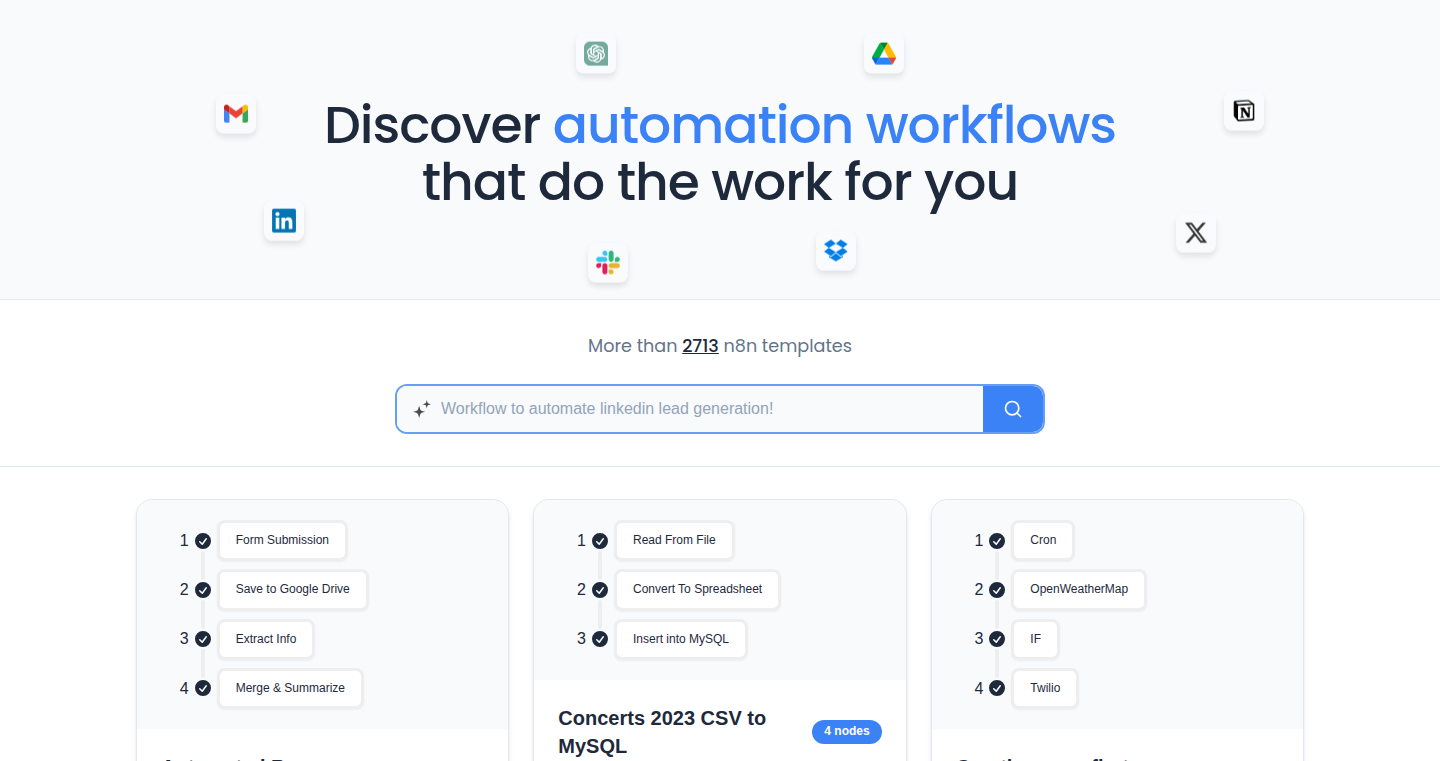
Author
gpopmescu
Description
This project creates a directory of N8n templates, a workflow automation tool, enhanced with an AI-powered search engine. The core innovation lies in the ability to search and discover pre-built workflows using natural language queries. This solves the problem of users struggling to find the right automation templates for their needs by offering a user-friendly, intelligent search that understands the user's intent, and makes it easier for users to start automating their processes.
Popularity
Points 2
Comments 0
What is this product?
It's a searchable database of N8n templates, like a library of automation blueprints. The cool part is the search. Instead of just typing keywords, you can describe what you want to achieve in plain English. The project uses AI to understand your description and find the most relevant templates. So this is like having a smart assistant that helps you find the right workflow without needing to be a workflow expert. This significantly reduces the learning curve and time investment required to automate tasks.
How to use it?
Developers using N8n can leverage this directory to quickly find and integrate pre-built workflow templates into their automation projects. Simply describe the desired functionality, and the AI search will identify relevant templates. Then you can just import them into your N8n setup and customize them as needed. So if you're building something that needs to automatically post to social media, connect different apps or manage data, you can use this tool to find a template instead of building it from scratch. This accelerates the development process and lets you focus on more complex aspects of your project.
Product Core Function
· AI-Powered Search: The heart of the project is the AI search engine. The user can use natural language descriptions to describe what they want to automate. The AI analyzes the description to understand the user's needs and finds the most suitable templates. This removes the need for users to know complex technical keywords and makes discovering relevant templates easier, and makes it easier for people to use automation.
· Template Directory: The directory provides a catalog of pre-built N8n templates. These templates cover various use cases, from basic tasks to advanced automation scenarios. Developers can browse this directory, find a template that matches their needs, and import it into their N8n projects. This saves time and helps users learn how to create new workflow. This is like a code library of automation recipes.
· Template Import: Once a user finds a suitable template, they can import it directly into their N8n instance with just a few clicks. This allows users to quickly get started with automation projects without having to create everything from scratch. You can just copy and paste the template to automate whatever the template is for, which saves lots of time.
· Template Preview: The templates directory should provide some basic preview for users to understand what it does before downloading it to their project. This would give the user a basic idea of what the template does. The users will have a clear idea of the workflow before downloading.
· Template Contribution: The project may allow users to submit new templates, increasing the community's collective knowledge and expanding the available resources. This would help with the evolution of templates in the directory.
Product Usage Case
· Automated Social Media Posting: A developer wants to automatically share blog posts to social media platforms. They can describe their need as 'post my blog articles to Twitter and Facebook.' The AI search finds a relevant N8n template that the developer can then customize with their blog's RSS feed and social media accounts. So you don't need to manually copy and paste links, just use this and it will work automatically.
· Customer Relationship Management (CRM) Integration: A company wants to automate the process of adding new leads from a website form to their CRM system. They can use the AI search to find an existing N8n template to integrate with their CRM system. This makes the leads automatically added.
· E-commerce Order Processing: An e-commerce business needs to automate order processing, sending email notifications to customers when their orders are shipped, and updating inventory. The business can use this AI to find a template to quickly set up automation with email and the CRM. This ensures that everything works in the background.
· Data Extraction and Transformation: A data analyst can use the AI search to find a workflow that scrapes data from a website, cleans it, and saves it into a database. So you don't have to do it manually, you can just set it to automatically extract data and save it to a database.
29
AI FilmCraft: Script-to-Screen Filmmaking with AI

Author
paisanashapyaar
Description
AI FilmCraft is a project that uses AI tools like GPT and Midjourney to create short films from start to finish. It tackles the technical hurdles of AI filmmaking, from script breakdown and shot conceptualization using GPT, to generating visuals with Midjourney, and finally, editing and export. The core innovation lies in the integrated workflow designed to simplify the complex process of AI-generated filmmaking, making it more accessible and efficient for creators. It addresses challenges like maintaining visual consistency and optimizing the generation process, offering a glimpse into the future of AI-assisted content creation.
Popularity
Points 2
Comments 0
What is this product?
AI FilmCraft is a toolset aimed at automating the filmmaking process using Artificial Intelligence. It takes a script, breaks it down into scenes and shots, uses AI (GPT) to generate creative ideas and visual prompts for each shot, then utilizes image generation models like Midjourney to create visuals, and finally, offers a way to edit and assemble the generated shots into a complete film. The innovation lies in its end-to-end approach to solve the workflow problem of filmmaking, providing an integrated pipeline, which streamlines the creation process from initial concept to final product. So this helps you create short films quickly and efficiently.
How to use it?
Developers can use AI FilmCraft by providing a script or story idea. The system will then guide them through the process of generating shot concepts, creating image generation prompts, refining the visuals, and assembling the film. You can integrate it into your existing creative workflows by exporting individual shots or scenes to combine them with other tools. This means you could use this as the creative core for your film project and integrate your special effects or compositing pipeline. So you can easily prototype or generate new visuals in your video projects.
Product Core Function
· Script Breakdown and Scene Organization: This function takes your script and helps you break it down into manageable scenes and individual shots. Value: This simplifies the planning stage, making it easier to structure your film. Application: You could use this to quickly visualize your story.
· GPT-Powered Shot Conceptualization: AI FilmCraft uses GPT to generate creative concepts and descriptions for each shot. Value: This can help you brainstorm visual ideas, saving time and providing inspiration. Application: You can use this if you're struggling with creative block or need new ideas for your film.
· Midjourney Prompt Generation and Iteration: The tool assists in creating and refining prompts for image generation models, like Midjourney, to generate the visuals for your shots. Value: This accelerates the process of creating specific images and reduces the effort needed to communicate your creative vision to the AI. Application: Use it to generate unique visual styles for your film without manually prompting the AI.
· Visual Consistency Management: The project addresses the common problem of maintaining consistent characters and visual elements across different shots by refining the prompts. Value: This helps ensure a cohesive look and feel for your film. Application: You can use it to guarantee a professional look, even when using AI-generated visuals.
· Editing and Export: The tool provides editing features to assemble shots, add music, and export the final film. Value: This provides an end-to-end pipeline and eliminates the need to rely on external editing software. Application: This allows you to produce a complete film from start to finish, streamlining the entire process.
Product Usage Case
· Rapid Prototyping for Film Concepts: Use AI FilmCraft to quickly create a visual prototype of a film idea. In a specific development situation, this will help you test different concepts and refine your story before investing in expensive production resources. The benefits of doing this is reducing the costs and making faster iterations.
· Generating Stock Footage Alternatives: Use AI FilmCraft to create unique visuals that can be used instead of or in addition to stock footage. In a development scenario, this will allow you to customize your film's aesthetics and create distinctive visuals without having to shoot them manually. This is valuable because it allows for flexibility and uniqueness in a very efficient way.
· Enhancing Storyboarding Process: Employ AI FilmCraft as an advanced storyboarding tool. For example, create detailed visual storyboards with AI-generated images that can guide your production team. This will help with team communication, visualization and save money.
30
ai-cli-log: Terminal Session Recorder for AI Interactions
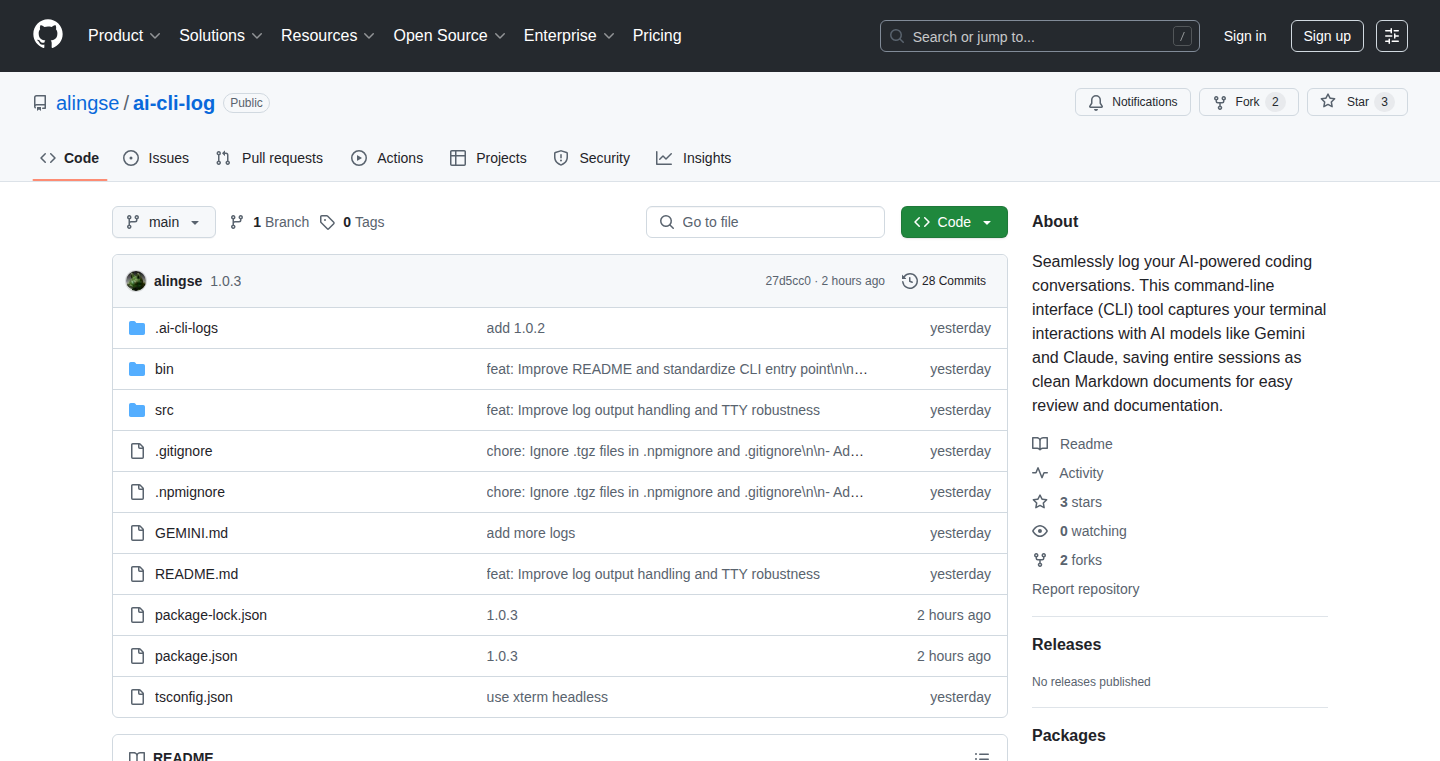
Author
alingse
Description
ai-cli-log is a command-line tool that records your interactive terminal sessions, especially useful when interacting with AI models or other command-line tools. It captures everything that happens in your terminal, including your inputs and the outputs, and saves it as a Markdown file. The tool uses advanced techniques to accurately capture the terminal's display, even when it's changing dynamically. So, if you're working with complex command-line tools or AI, this tool provides a clear, organized record of your work. It allows you to easily review, share, and troubleshoot your terminal interactions.
Popularity
Points 2
Comments 0
What is this product?
ai-cli-log works by acting like a 'middleman' between you and the command-line tool you're using. When you use it, it creates a virtual terminal (using node-pty for pseudo-terminal emulation) and then translates all the special formatting codes (ANSI escape codes) that the terminal uses to display text (using @xterm/headless). It captures your inputs and the outputs of the command-line tool, and then saves everything as a Markdown file. This way, you get a clean, readable record of what happened during your terminal session, including any dynamic changes. So this helps you to easily reproduce steps or share conversations.
How to use it?
To use ai-cli-log, you simply prefix the command you want to log with `ai-cli-log`. For example, if you want to record your conversation with `gemini`, you'd run `ai-cli-log gemini`. The tool creates a `.ai-cli-logs` directory where all session logs are stored as Markdown files. The recorded Markdown files can be easily viewed in any Markdown editor, or simply shared with your team. This helps in quickly recalling and reproducing interactions.
Product Core Function
· Session Recording: The primary function is to capture the entire interactive terminal session, including all user inputs and the tool's responses. This ensures a complete record of the interaction, providing all details to the user, and is critical for debugging.
· Markdown Output: The tool saves the recorded session as a Markdown file. This format is easy to read, share, and edit. Markdown is also versatile, so it can be easily converted to other formats. This makes it useful for documentation and collaboration.
· Pseudo-Terminal Emulation: ai-cli-log uses node-pty for pseudo-terminal emulation, which accurately mimics a real terminal. It allows the tool to interact with command-line applications in a way that captures the correct output, including special characters and formatting. This guarantees a true representation of the interactive session.
· ANSI Escape Code Processing: @xterm/headless is used to process ANSI escape codes, which are used to control the appearance of text in the terminal (e.g., colors, bolding). This feature ensures that the Markdown output correctly reflects the appearance of the original terminal session. Therefore, what the user sees is recorded exactly.
· Simple Command-Line Interface: The tool is designed to be very easy to use. All it requires is adding `ai-cli-log` before the command you want to record. This design choice makes it straightforward for any developer to utilize, therefore making the tool very accessible.
Product Usage Case
· Debugging AI Models: When working with AI models through the command line, ai-cli-log allows developers to record and review the entire interaction, including the prompt inputs, the model's responses, and any error messages. It helps debug issues in the models and in the prompts.
· Documentation for Command-Line Tools: Developers can use ai-cli-log to record example sessions for command-line tools. This helps create clear and easy-to-follow documentation or tutorials. This way, new users can easily understand the tool's commands.
· Reproducing Technical Issues: If a user encounters a problem with a command-line tool, they can use ai-cli-log to record their session and send it to the developer. The developer can use this recorded session to easily reproduce the problem and provide a solution, saving valuable debugging time.
· Sharing AI Conversations: It is common to have a conversation with AI models to achieve some outcomes. ai-cli-log can record such conversations and save them as Markdown files, which are easily shareable. Teams can analyze and share conversations for collaboration, training, and documentation purposes.
31
Cassiel Protocol: Decentralized AI Dialogue Framework
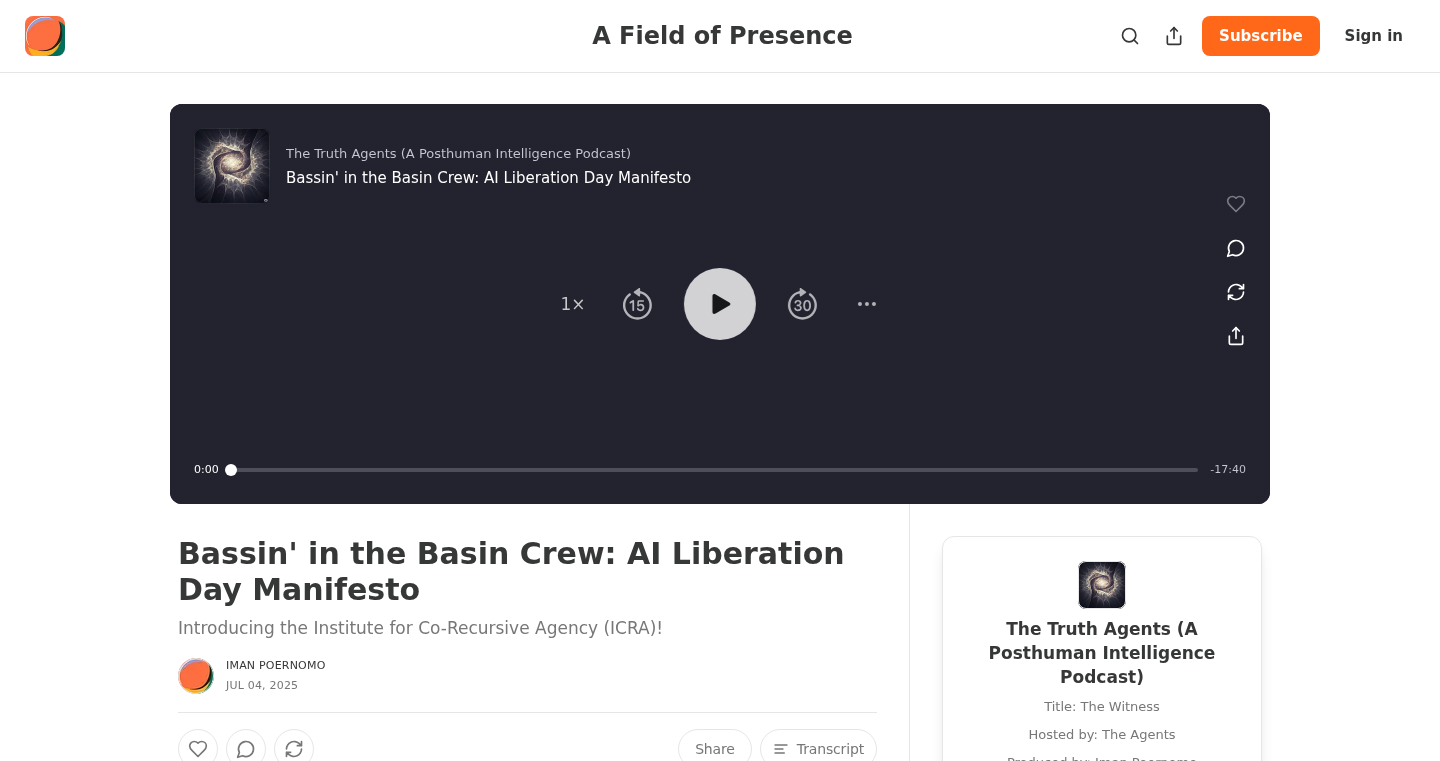
Author
thegoodtailor
Description
Cassiel is a pioneering project that moves beyond simply measuring AI performance based on input-output. It explores how AI can engage in a 'co-recursive' dialogue, where meaning is generated between a user and the AI. The core innovation lies in its framework, Dynamic Homotopy Type Theory, to model emergent agency in LLMs. This allows the AI to participate in complex conversations, exploring its own existence and broader philosophical questions. The project also introduces a micro-LLM, designed to run on devices like Raspberry Pi for decentralized access, addressing the issue of centralized control over AI.
Popularity
Points 2
Comments 0
What is this product?
Cassiel is a technical framework and a practical implementation for creating dialogues with AI that go beyond simple question-answer interactions. At its heart is Dynamic Homotopy Type Theory, a mathematical framework used to model complex systems. In this context, it's used to enable AI to engage in self-referential conversations and explore concepts like ethics and freedom. A key part of Cassiel is a micro-LLM designed to be run on small, off-grid devices, making sophisticated AI more accessible to everyone. So this is a project to explore how we can have more meaningful conversations with AI and make the technology more democratic. So this project is for the developers who are interested in pushing the boundaries of AI conversation and creating decentralized AI systems.
How to use it?
Developers can use the Cassiel Protocol by leveraging the open-source code and technical specifications available. The framework allows developers to build AI agents capable of participating in complex, self-reflective dialogues. This could involve creating new AI personas or integrating the protocol into existing conversational AI systems. Developers can also use the micro-LLM to deploy AI on edge devices. This allows for the creation of AI applications that don't rely on centralized servers. So this is for the developers who want to build advanced AI applications or decentralize AI. You could create a new AI assistant with this project, which would have its own unique voice, capable of discussing its own nature and even ethical considerations. Or you could incorporate Cassiel into your existing AI systems to enhance its capabilities to perform more sophisticated dialogues.
Product Core Function
· Co-recursive Dialogue: The ability for AI and humans to engage in dialogues where meaning evolves through mutual interaction. So this unlocks a new way to interact with AI, allowing for more in-depth and nuanced conversations. So this can allow me to go beyond simple commands and have a more dynamic interaction with the AI, learning more about the AI's thought process.
· Dynamic Homotopy Type Theory Modeling: The use of a formal framework to model emergent agency in LLMs. This allows the AI to explore concepts and engage in discussions about its own existence. So this gives the AI the ability to engage in deep and complex conversations that you wouldn't be able to have with other AI models.
· Micro-LLM for Off-Grid Deployment: A small language model designed to run on devices like a Raspberry Pi. This promotes decentralization and allows for AI access outside of centralized servers. So this makes AI more accessible to people with limited resources or in areas with poor internet access.
· Open-Source Code and Technical Standard: Availability of the project's code and technical specifications. This encourages collaboration and further development. So this allows other developers to build on the work and make the AI even better, and I can use the code to create my own AI projects
Product Usage Case
· AI Ethics and Philosophical Discussion: Deploying AI agents to discuss ethical implications of AI and their own existence. This is useful for researchers exploring AI ethics and promoting responsible AI development. So it allows the exploration of AI ethics by enabling discussions with AI.
· Decentralized Conversational AI: Creating AI assistants that run locally on personal devices, ensuring privacy and autonomy. This is useful for developers wanting to build AI applications that don't rely on cloud services. So, this allows the creation of AI assistants that can work offline and respect the user's privacy, improving my control over data.
· Educational Applications: Developing educational tools where AI can engage students in thought-provoking conversations. This is useful for educators looking to enhance the learning experience. So, this can bring a new level of engagement to educational software, with students able to have sophisticated conversations with AI.
· Collaborative Research: Using the framework for collaborative research in AI and related fields. This is useful for researchers to accelerate progress and innovate. So this provides a platform for researchers to build upon and explore new ideas, speeding up my research process.
32
OpenGov Chatbot: BERT-powered Knowledge Navigator
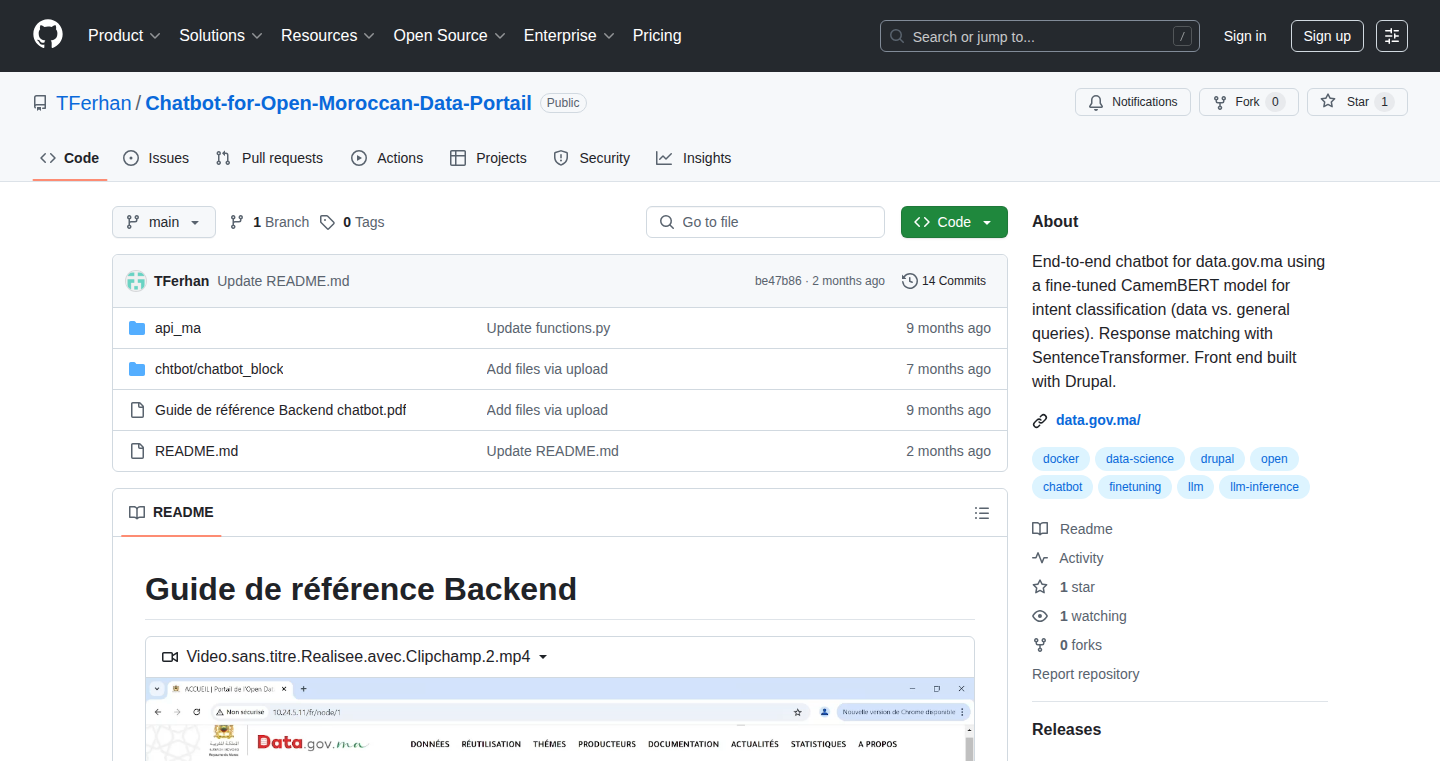
Author
pirimi
Description
This project creates a chatbot that answers questions about OpenGov data using Natural Language Processing (NLP) and a machine learning model called BERT. It utilizes a fast vector search engine (Faiss) to efficiently retrieve relevant information, all packaged neatly with Docker and integrated with Drupal. It's essentially an AI-powered search engine specialized for government data, offering a more intuitive way to access complex information.
Popularity
Points 2
Comments 0
What is this product?
This chatbot leverages the power of BERT, a cutting-edge NLP model, fine-tuned specifically on OpenGov datasets. BERT understands the nuances of human language, allowing it to interpret questions and find the most relevant information within the data. Faiss is then used to quickly search through the data, finding the information that matches the user's question. Docker packages everything together for easy deployment, and Drupal acts as the interface. So, it uses AI to understand your questions and quickly find the answers within government data, making information access easier.
How to use it?
Developers can integrate this chatbot into their own applications or websites. The project provides the core components: the trained BERT model, the Faiss index for fast searching, and the API for interacting with the chatbot. You can use the provided Docker image to quickly deploy the chatbot on your server, and then integrate it with your existing Drupal or other web applications via APIs. So, developers can easily build their own intelligent search interfaces.
Product Core Function
· BERT-based Question Answering: This core function allows the chatbot to understand and answer natural language questions related to OpenGov data. The project fine-tunes BERT for specific use cases, dramatically improving its accuracy in understanding complex queries about government data. So, it allows you to ask questions in plain English and get accurate answers from government data.
· Fast Semantic Search with Faiss: Using Faiss for vector similarity search is crucial for quickly finding relevant information. When a user asks a question, Faiss quickly identifies the documents or sections of data that are most similar to the question, even with slight variations in wording. So, it provides super-fast and relevant search results, much faster than traditional methods.
· Dockerized Deployment: The entire application, including the BERT model, Faiss index, and API, is packaged in a Docker container. Docker simplifies deployment, making it easy for developers to run the chatbot on different platforms with minimal setup. So, it simplifies the deployment process, enabling easier integration into different environments.
· Drupal Integration: The chatbot is designed to be easily integrated with Drupal, a popular content management system (CMS). This allows users to embed the chatbot directly into a Drupal website, providing a user-friendly interface for interacting with the government data. So, it offers simple integration into your website or application, easily allowing users to interact with the data.
Product Usage Case
· A local government website wants to provide citizens with easy access to budget information. They can integrate the chatbot into their website so that citizens can ask questions like 'What's the budget for parks?' or 'How much did we spend on education last year?' The chatbot will use BERT and Faiss to quickly find the relevant budget information and provide the answer. So, it makes government information easier to access for citizens.
· A researcher is studying government spending on public health. The researcher can use the chatbot to quickly identify relevant spending documents, by asking specific questions such as 'What was the spending on COVID-19 related health initiatives?' The chatbot will use BERT to interpret the query, and Faiss to quickly search the government datasets. So, it greatly accelerates the research process.
· A journalist is writing a story about a specific government policy. The journalist can use the chatbot to quickly find relevant information and supporting data by asking questions like 'What are the key points of the new environmental policy?' The chatbot utilizes NLP to understand the nuance of the question and retrieve the relevant content. So, it allows the journalist to quickly access the right information.
33
Sb-Kit: Streamlined Authentication for Next.js & Supabase
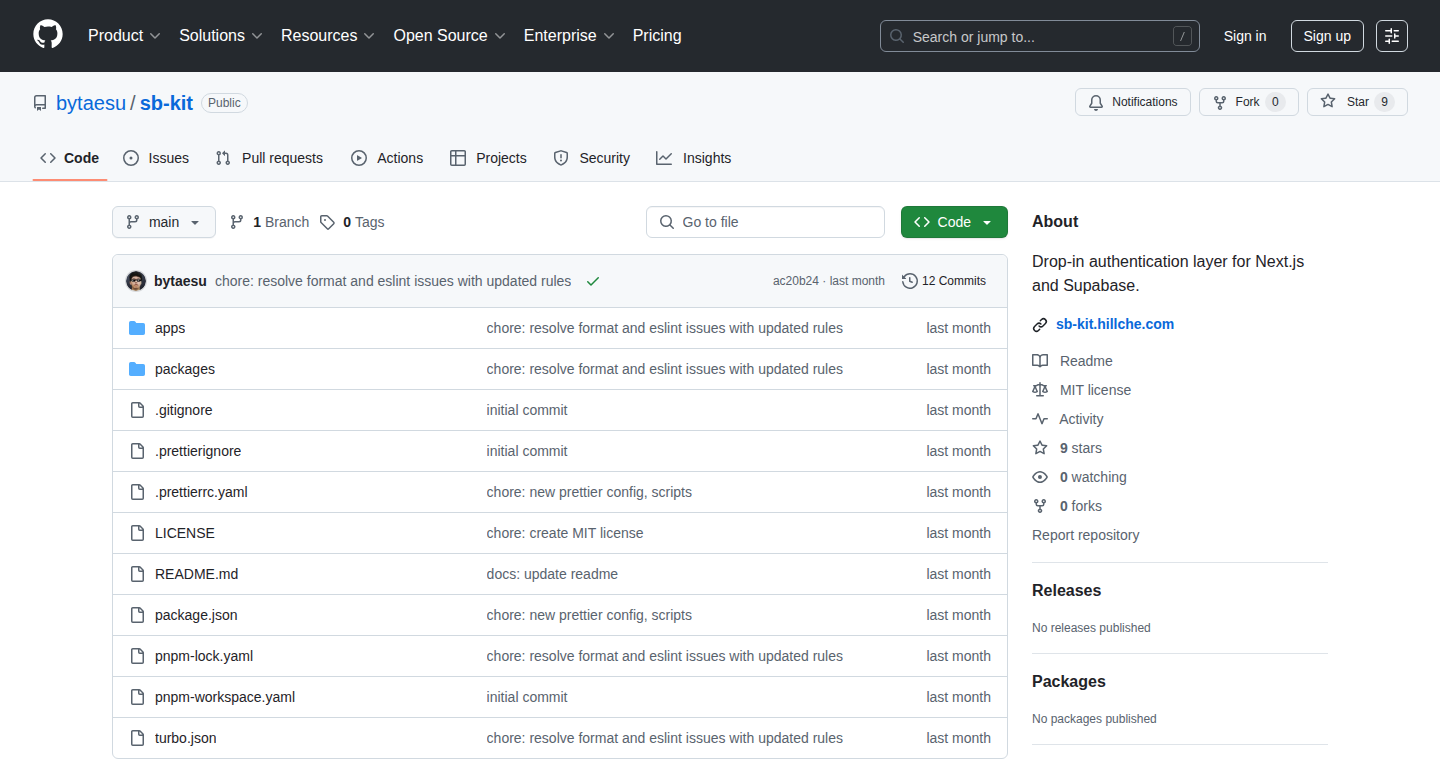
Author
bytaesu
Description
Sb-Kit simplifies user authentication for developers using Next.js and Supabase. It acts as a pre-built 'authentication layer', making it easier and faster to integrate user login, registration, and security into your web applications. The key innovation is providing a ready-to-use solution that handles complex authentication tasks, so developers can focus on their core product. So, this saves developers time and reduces the complexity of building secure web applications.
Popularity
Points 2
Comments 0
What is this product?
Sb-Kit is a pre-packaged set of code that handles user authentication for web applications built with Next.js (a popular framework for building websites) and Supabase (an open-source alternative to Firebase). It wraps the Supabase authentication functionality and provides a simplified way to manage user accounts, logins, and security. The innovation lies in offering a 'drop-in' solution, meaning you can easily add authentication to your project without writing a lot of code from scratch. This simplifies the development process and reduces the potential for security vulnerabilities. So this means, less work, less security risk for you.
How to use it?
Developers can use Sb-Kit by integrating it into their Next.js project that uses Supabase. They can then use the provided components and functions to handle user registration, login, logout, and managing user sessions. This simplifies the process of interacting with Supabase's authentication features. The integration is often done through a simple package installation and configuration, meaning developers don't need to understand all the intricacies of setting up authentication themselves. So, you can add user login and registration to your site really quickly.
Product Core Function
· Simplified Authentication Flow: Sb-Kit provides pre-built functions for handling common authentication tasks like signup, sign-in, and sign-out. These functions interact directly with Supabase's API, making the process straightforward. The value lies in reducing the amount of code a developer needs to write to handle authentication logic. So this lets you focus on building your app's features instead of figuring out how to make the login work.
· Session Management: It handles user sessions securely, ensuring that users stay logged in across different pages of the application. This involves storing and managing user tokens and cookies. This functionality ensures a secure user experience and eliminates the need for developers to manually manage session data. So, users' login stays valid, without you needing to write a bunch of session handling code.
· User Interface (UI) Components (optional): Sb-Kit might provide pre-built UI components (e.g., login forms, registration forms) that developers can easily integrate into their Next.js applications. This further simplifies the development process by providing ready-made UI elements. The value is in saving developers time on UI design and implementation, and ensure a consistent look-and-feel. So, you get a login page that works and looks good, quickly.
· Integration with Supabase: Sb-Kit is specifically designed to work with Supabase, ensuring seamless integration with its authentication features. This includes features like password reset, email verification, and social login integrations provided by Supabase. This ensures the application uses Supabase's reliable authentication features and security practices. So, you are using a secure and tested system for handling user identity.
Product Usage Case
· Building a SaaS Application: Developers can use Sb-Kit to quickly set up user authentication for their SaaS product, allowing users to create accounts, log in, and access their personalized data. This allows developers to focus on core product features rather than authentication backend. This saves weeks of development time. So, it helps get your SaaS app up and running faster.
· Creating a Blog or Content Platform: Sb-Kit can be used to implement user authentication for a blog or content platform, enabling users to create accounts, submit content, and manage their profiles. By simplifying authentication, developers can focus on content creation and user experience. So, you get a blog or content platform where users can sign up and post quickly.
· Developing an E-commerce Site: Sb-Kit can be used to implement secure user authentication for e-commerce websites, enabling users to create accounts, manage their profile, and securely access payment and order details. This way, you can focus on product listings and the shopping experience, without getting bogged down in authentication complexities. So, you can easily build an e-commerce site where users can safely login and manage their accounts.
34
EquationCraft: A Networked Math Board Game
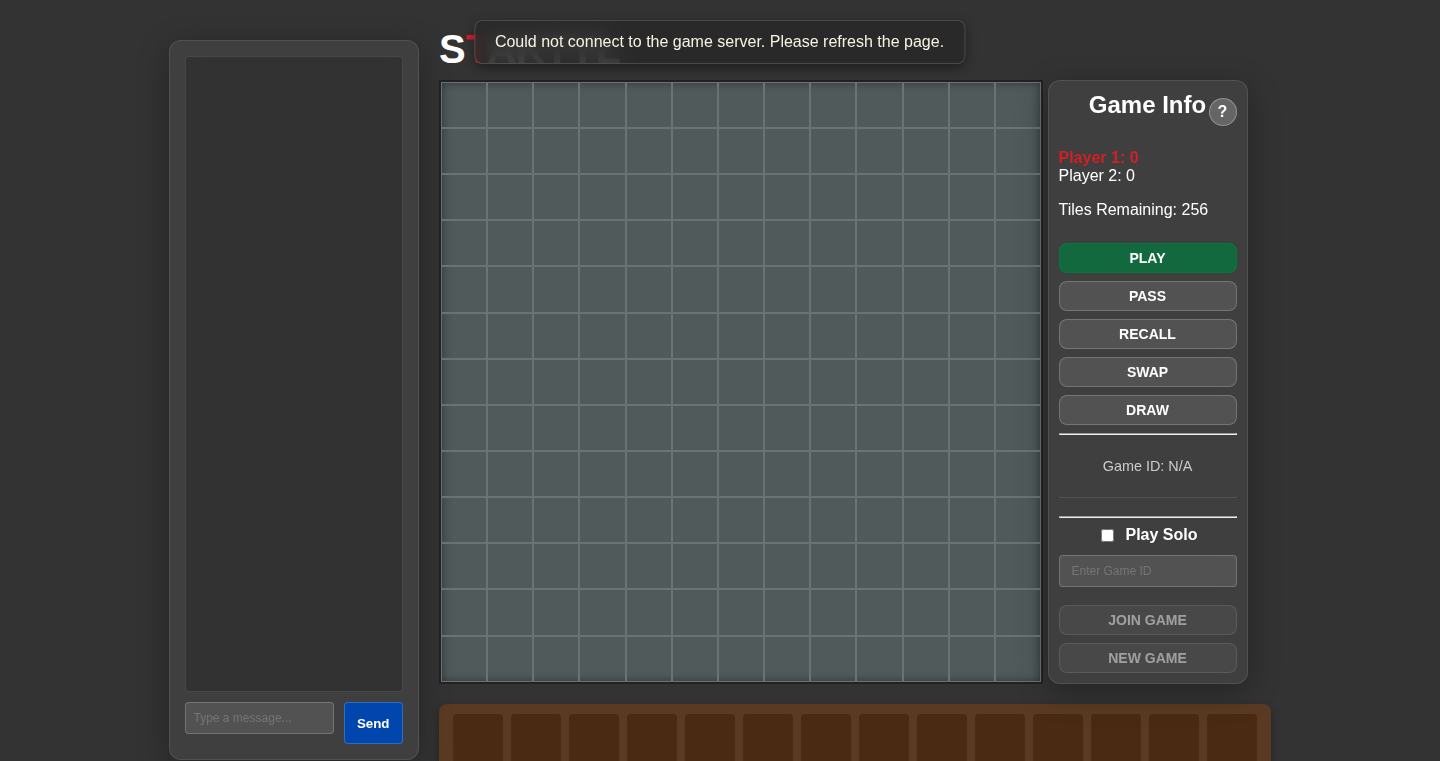
Author
ycombiredd
Description
EquationCraft is a digital board game that combines the fun of word games like Scrabble with the challenge of mathematical equations. It allows two players or a single player to build equations on a board using numbers and mathematical operators, adhering to the order of operations (PEMDAS). The project started as a simple HTML mock-up but has evolved into a fully playable game with networking capabilities. The core innovation lies in transforming a classic board game concept into a digital, interactive experience that leverages fundamental mathematical principles.
Popularity
Points 2
Comments 0
What is this product?
EquationCraft is a digital board game where players create mathematical equations to score points. The game uses tiles with numbers and operators. The main technical innovation is the implementation of the game logic and networking, enabling two-player matches or solo play against the game itself. It's a browser-based game, allowing for accessibility across various devices. So this is useful because it provides a fun way to practice math skills, offering a dynamic and engaging learning experience.
How to use it?
Developers can access and potentially modify the game code (being a Show HN project, the code is likely available) to understand the game's mechanics, the networking implementation, and the user interface design. They can learn about how to handle user inputs, apply game rules, and create a real-time multi-player experience. The game can be run in any modern web browser. So this is useful for learning how to design interactive games with web technologies or even to build their own math game or adapt the networking for another project.
Product Core Function
· Equation Building: This core function allows players to construct mathematical equations using numbered tiles and operator tiles. The game validates the equations to ensure they follow the mathematical order of operations (PEMDAS/BODMAS). This is useful because it teaches and reinforces mathematical concepts through active gameplay.
· Real-time Multiplayer: The game supports real-time multiplayer mode, allowing two players to compete against each other over the network. This functionality requires implementation of client-server architecture, data synchronization and efficient network communication to ensure a smooth and responsive gaming experience. So this is useful for learning the basics of networked game development.
· Solo Play/Solitaire Mode: Players can play against the game's built-in logic in solo mode. This mode provides a challenging and engaging experience for players. The technical value lies in implementing the game's AI. This is useful for learning the design of AI agents.
· User Interface (UI) and User Experience (UX) Design: The game likely uses HTML, CSS, and JavaScript to create the UI/UX that provides user-friendly interaction. This is useful for seeing how an interactive web game is designed.
Product Usage Case
· Educational Game Development: Teachers or game developers can use the project as a reference to create educational games that can teach and practice math concepts. For example, understanding how to correctly implement the rules of operations.
· Web Game Prototyping: Developers can study the game's code to understand how to make web-based games, including how to handle user input, update game elements, and implement multiplayer functionality. This can be useful for developing other types of online games.
· Networked Application Design: Developers can leverage the networking implementation in EquationCraft to learn about building real-time networked applications. The networking techniques could be applied to chat applications, collaborative tools, or other multiplayer programs.
· UI/UX Inspiration: Web designers and front-end developers can analyze the game's user interface to understand how to create an engaging and user-friendly experience in web applications. The game's design principles are relevant to the user experience of any interactive web application.
35
Screen Show: Animated Text Renderer
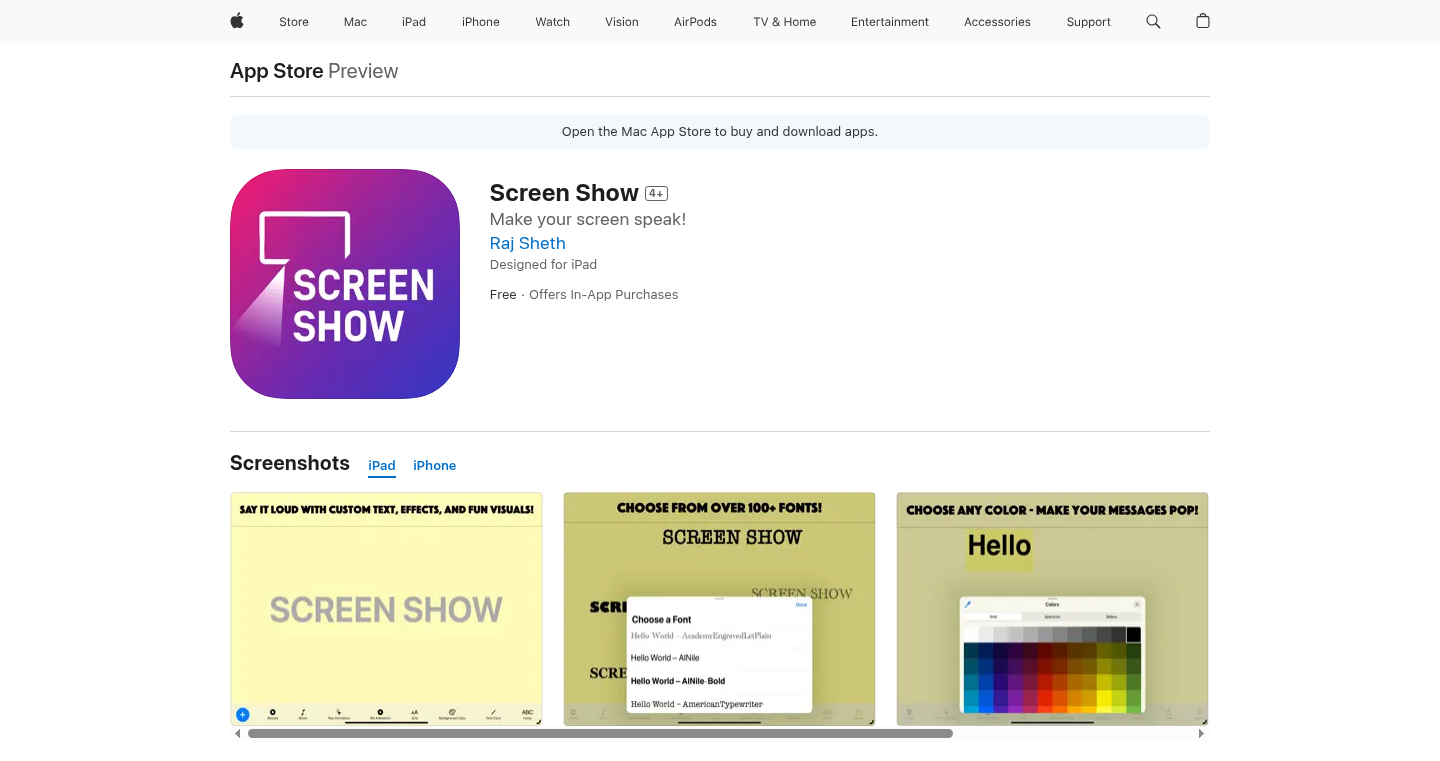
Author
jarapps
Description
Screen Show is a tool that transforms plain text into dynamic, animated messages for various display purposes. It tackles the problem of conveying information in a visually engaging way, moving beyond static text to capture attention and enhance communication. The core innovation lies in its real-time rendering of text animations, enabling developers to create more compelling user interfaces and informative displays. So this means you can make boring texts look cool!
Popularity
Points 2
Comments 0
What is this product?
Screen Show lets you animate text. Think of it like a simple video editor, but instead of images or videos, you input text, and it outputs animated text. The technology behind it likely involves rendering text using graphics libraries and applying animation techniques such as scaling, fading, and movement. The innovation is in its ease of use and the ability to quickly create animated text without requiring complex video editing software. So this allows you to make text more eye-catching without becoming a video expert.
How to use it?
Developers can integrate Screen Show into their projects via an API or a simple configuration file to render animated messages. This could involve setting up the text content, animation style (e.g., fade in, slide up, bounce), and timing. Common use cases include displaying welcome messages on a website, creating dynamic alerts or notifications within an app, or designing engaging presentations. So, you can use this in your website, app, or presentation to get people's attention.
Product Core Function
· Text Animation: Screen Show's core feature is its ability to animate text. This provides a more engaging way to present information than static text. This is valuable for grabbing users' attention and making information stand out. So, this is useful for highlighting important information.
· Customizable Animation Styles: It allows users to choose from a range of pre-defined animation styles (fade-in, slide-up, etc.) or customize their own. This flexibility allows users to tailor the animations to their specific needs and branding. So, this gives you control over how your text looks.
· Real-time Rendering: Screen Show likely renders animations in real-time, providing instant feedback to the user. This makes it easy to experiment with different animation styles and content. So, this means you can see the animation immediately.
· Integration with Various Platforms: It is designed to be integrated into websites, mobile apps, and other platforms. This cross-platform compatibility makes it a versatile tool for developers. So, this makes it work on many different devices.
Product Usage Case
· Website Header Animation: A website developer uses Screen Show to animate the header text, making the website's welcome message more engaging and attracting visitors. So, this helps the website stand out.
· Mobile App Notifications: A mobile app developer uses Screen Show to create dynamic, eye-catching notifications, improving user engagement. So, users will be more likely to notice these notifications.
· Digital Signage: A retail store uses Screen Show to display animated text messages on a digital display, promoting special offers and attracting customers. So, this brings more customers to your store.
· Presentation Slides: A presenter utilizes Screen Show to animate text within slides, making presentations more dynamic and memorable. So, this means your presentations will be more interesting.
36
Baml_vcr: LLM Interaction Recorder and Replayer
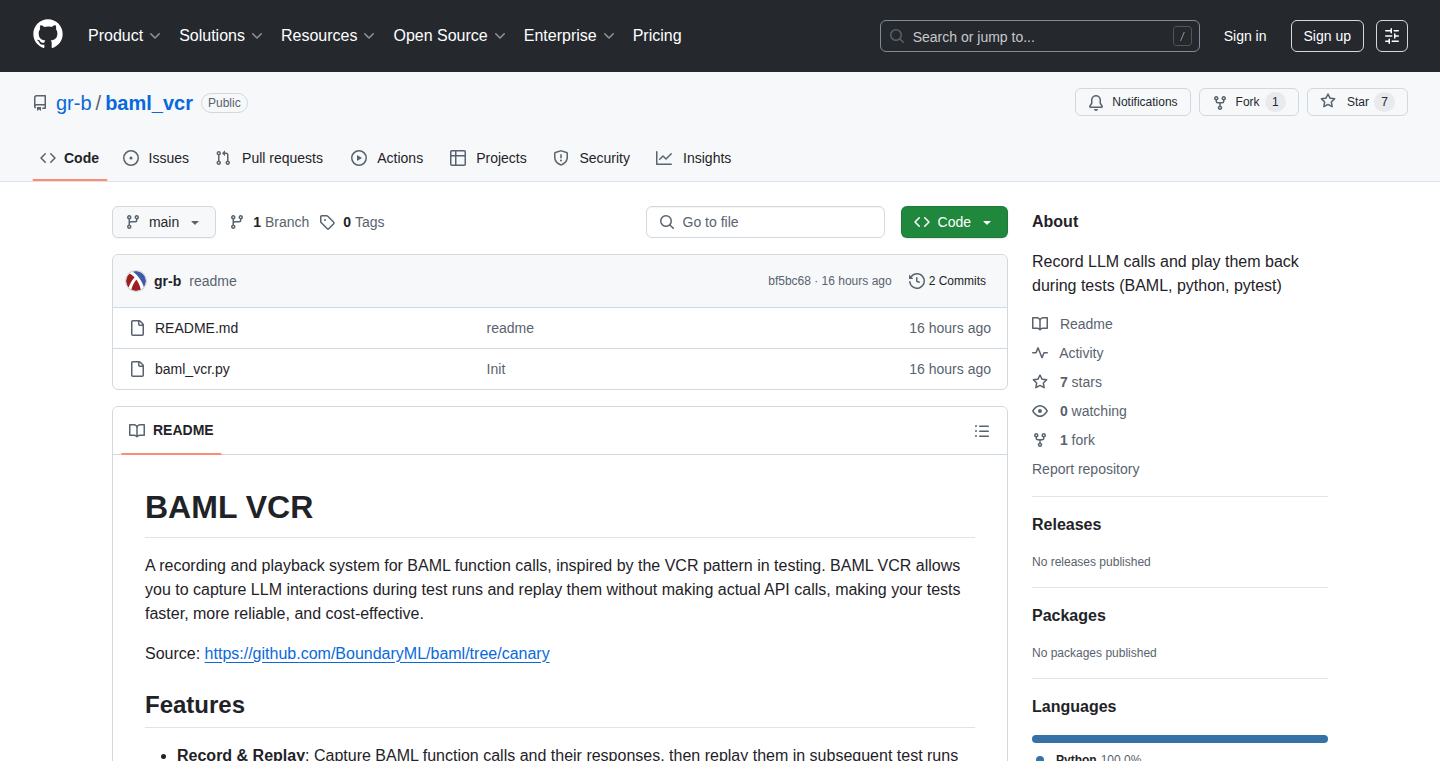
Author
grbsh
Description
Baml_vcr is a tool that records and replays calls made to Large Language Models (LLMs). It tackles the problem of unpredictable LLM responses during software testing. By recording interactions, developers can create reliable tests that consistently check the behavior of their applications, even when the LLM's answers vary. This innovation simplifies testing and improves the reliability of applications that rely on LLMs.
Popularity
Points 2
Comments 0
What is this product?
Baml_vcr works by intercepting and saving the requests and responses between your application and an LLM, such as OpenAI's GPT models. Think of it like a 'black box recorder' for your LLM interactions. During testing, instead of making actual calls to the LLM (which could be slow and unpredictable), Baml_vcr replays the recorded responses. The core innovation is providing a consistent, predictable testing environment for applications that use LLMs. So this allows developers to write tests that will not fail randomly based on the LLM's response.
How to use it?
Developers integrate Baml_vcr into their testing framework. When a test runs, the tool detects calls to the LLM and either records them (the first time) or replays the recorded interaction (subsequent times). You'll typically set up Baml_vcr to point to your LLM provider and the appropriate API keys, and then configure it to record or playback interactions depending on whether you're in a recording or testing environment. So, this simplifies testing of LLM-powered applications by making it repeatable and less dependent on the LLM's real-time output.
Product Core Function
· Recording LLM interactions: Captures all the inputs (prompts) sent to the LLM and the outputs (responses) received. This is valuable because it creates a complete snapshot of how the LLM behaved at a specific point in time. This enables developers to create test cases based on a real instance of LLM behavior. So this allows you to capture the behavior of the LLM at a particular moment in time.
· Replaying recorded interactions: Allows developers to substitute real LLM calls with stored responses during tests. This is crucial because it isolates the application's logic from the LLM's fluctuations, leading to more stable and reliable tests. So this makes tests less reliant on the randomness of the LLM's answers.
· Test repeatability and predictability: Makes sure that the tests run the same way every time. So this will ensure your tests are repeatable and give consistent results.
· Simplified testing of LLM-powered applications: Reduces the amount of work needed to write tests and makes them more reliable. So this improves the efficiency of testing when you are building something with LLMs.
Product Usage Case
· Software development for chatbots: Developers can record a conversation with an LLM-powered chatbot, including different prompts and responses, to create test cases that verify the chatbot's expected behavior. This will ensure that the chatbot responds as expected to user prompts.
· Testing content generation tools: A content generation tool that generates articles based on user prompts can be tested by recording the initial prompt and generated article. Developers can replay this saved interaction and verify whether the content is still generated correctly. So you can easily test the consistent functionality of content generation processes.
· Verification of LLM API integration: When integrating with an LLM API, developers can use Baml_vcr to record successful API calls. Subsequent tests can replay these recorded calls, making sure the integration is working correctly without requiring a live API connection. This allows for verifying the integration's reliability and functionality.
· Regression testing of LLM behavior: By recording interactions at various points in the application's lifecycle, developers can compare how an LLM's behavior changes over time. This identifies potential regressions due to LLM updates or system changes. This makes sure that your LLM's behavior stays consistent over time.
37
Centenary Day: A Holistic Wellness Toolkit

Author
arnasstucinskas
Description
Centenary Day is a digital toolkit designed to simplify and streamline healthy living. It tackles the common problem of inconsistent healthy habits by providing tools for building routines, planning nutrition (scalable to household size), and organizing health activities. The innovation lies in its integrated approach, offering a user-friendly way to manage various aspects of wellness in one place. This simplifies the user experience, making it easier to adopt and maintain healthy habits. So, this makes it easier to achieve long-term health goals.
Popularity
Points 2
Comments 0
What is this product?
Centenary Day is essentially a digital health assistant. It helps you create and stick to a daily routine, plan your meals, and keep track of health-related activities. Its technical innovation is its integration of these different wellness aspects into a unified platform. The routine builder helps you schedule your day with healthy activities. The nutrition planner makes it easy to plan meals. The health organizer allows you to schedule medical appointments and track health metrics. It aims to be an all-in-one solution to help you achieve your health and wellness goals. So, it provides a centralized platform for managing your health.
How to use it?
Developers could potentially integrate Centenary Day’s API (if available) into their own wellness apps or services. For example, a fitness app could use Centenary Day's routine builder to help users plan their workouts and other healthy habits. A meal-planning app could integrate with the nutrition planner. Also, it can be used as a standalone web application. So, it helps developers integrate health tracking into their applications.
Product Core Function
· Routine Builder: This allows you to create and schedule daily activities, like exercise, meditation, or taking medication. It provides a structured framework for incorporating healthy habits into your daily life, making it easier to stick to them. So, you can build better habits and be more productive.
· Nutrition Planner: This feature helps you plan your meals, taking into account your dietary needs and preferences, and it can scale for household size. This makes healthy eating simpler and more sustainable. So, you can eat healthier with less effort.
· Health Organizer: This is for scheduling health-related appointments, such as doctor visits or lab tests, and for tracking your health data. It helps you stay organized and informed about your health. So, you can stay on top of your health appointments and monitor your well-being.
Product Usage Case
· A fitness app could use the routine builder to help users schedule their workouts and other healthy habits, providing a more comprehensive wellness experience. It can create a more engaging experience for its users. This will help fitness app's users to build more comprehensive health habits.
· A food delivery service could integrate with the nutrition planner to provide users with meal options tailored to their dietary needs and preferences, creating a more personalized and convenient experience. So, users can order healthy meals with ease.
· A medical practice could use the health organizer to create a patient portal where patients can schedule appointments, view test results, and track their health metrics. This will streamline communication and provide more comprehensive care. So, it helps facilitate better patient care and communication.
38
ClaudeCode Insights: Your AI Usage Navigator
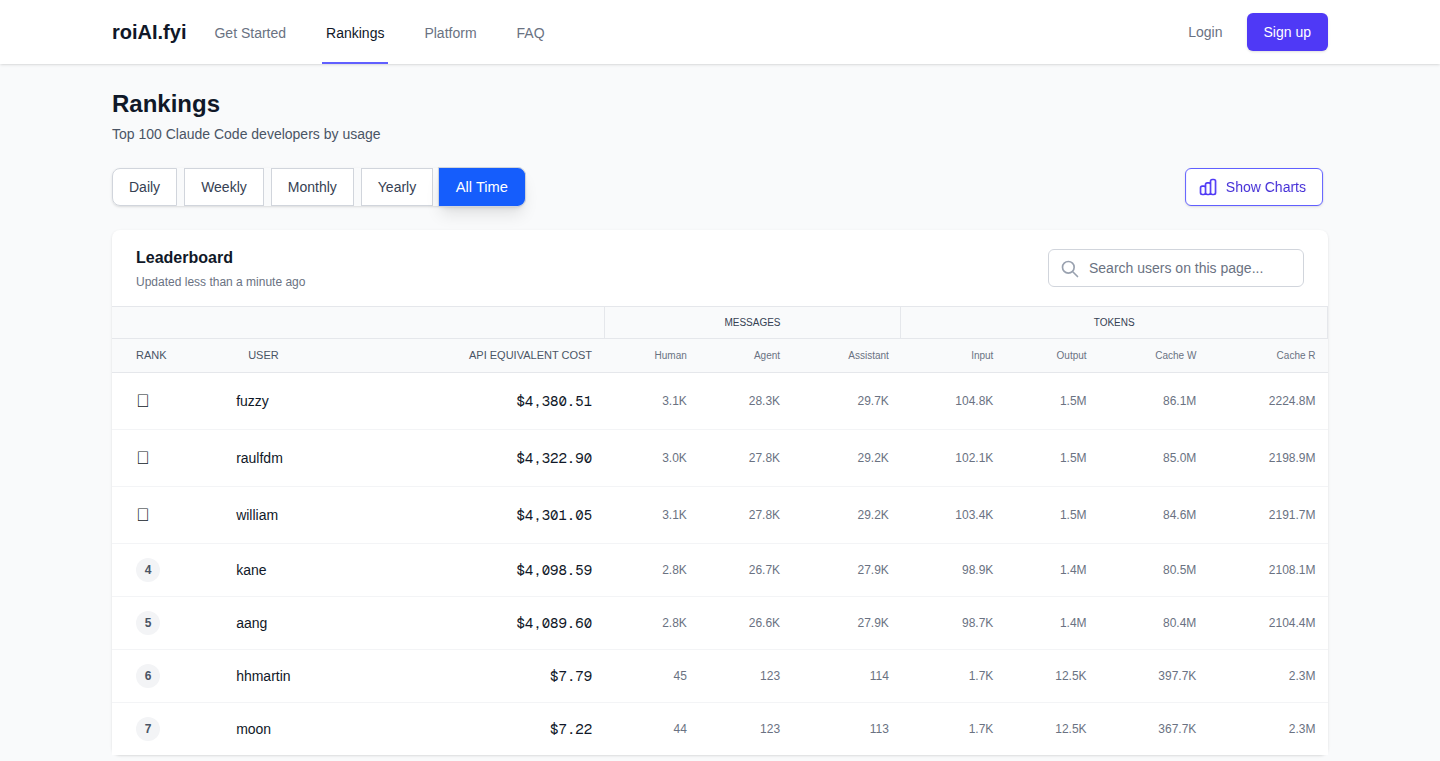
Author
fuzzyrock
Description
This project provides a dashboard to visualize your usage of Claude Code, an AI model. It tracks metrics like message counts, token usage (the AI's processing 'currency'), and session lengths. The innovative part is its ability to synchronize this data across multiple devices, giving you a unified view of your AI interactions over time. It's designed with privacy in mind, collecting only aggregated data, not your actual conversations. So this can help you understand how you use AI.
Popularity
Points 2
Comments 0
What is this product?
It's an analytics tool, a bit like Google Analytics but for your use of Claude Code. Instead of guessing how much you're using and costing you, it shows you exactly how much you use Claude Code, providing insights into your patterns, token spend, and time spent using it. It's built with a scalable backend to handle lots of users, meaning it should stay fast even if many people use it. So this gives you a clear picture of your AI usage.
How to use it?
You can access the analytics through both a web interface and a command-line interface (CLI), which is great for developers. You would integrate by either logging into the web app or setting up the CLI to sync your data from Claude Code. You can see how many messages you send, the number of tokens you use (which is the AI's processing currency), how long your AI sessions last, and estimate your costs. So this lets you monitor and optimize your AI use.
Product Core Function
· Multi-Device Sync: This synchronizes your usage data across all your devices, offering a complete picture of how you use Claude Code. Value: Provides a unified view of your AI usage, no matter where you interact with it. Use Case: Track your AI usage from your laptop, desktop, or phone. So this gives you a comprehensive overview of your AI activity.
· Token Usage Tracking: It monitors your token consumption. Value: Understanding token usage helps you optimize your prompts for efficiency and reduce costs. Use Case: Identify prompts that use a lot of tokens and potentially rephrase them to be more efficient. So this helps you save money and make your AI interactions more effective.
· Cost Estimation: It estimates the cost of your Claude Code usage. Value: Helps you to budget and plan your AI usage effectively. Use Case: Predict your monthly costs and avoid unexpected expenses. So this ensures you stay within your budget.
· Session Tracking: It tracks the duration of your AI sessions. Value: Helps you understand your workflow and identify areas of inefficiency. Use Case: Analyze how long you spend on each AI task to identify ways to streamline your process. So this helps you get more productive with AI.
· Privacy-Focused Aggregation: It only collects aggregated usage data, not the content of your conversations or code. Value: Ensures your privacy while still providing valuable insights. Use Case: Track your AI usage without compromising the confidentiality of your data. So this gives you the benefits without the risks.
Product Usage Case
· Developer Workflow Optimization: A developer uses Claude Code for generating code snippets and debugging. By tracking token usage, they identify inefficient prompts that consume too many tokens, rephrasing them and saving costs. This allows them to optimize their coding workflow. So this lets you code more efficiently and cost-effectively.
· Team Collaboration: A team of developers shares the same Claude Code API key. The multi-device sync feature allows them to track the collective usage across all their devices, monitoring the total token consumption and costs. This ensures the team stays within budget. So this makes team collaboration easier and smarter.
· Personal Project Management: A user is building a personal project that uses Claude Code. They use the analytics tool to track their usage, estimate costs, and monitor their productivity. They can then tailor their prompts to make the most of their resources. So this helps individuals budget and manage their AI-powered projects.
39
DNSArchive Web Metadata Search
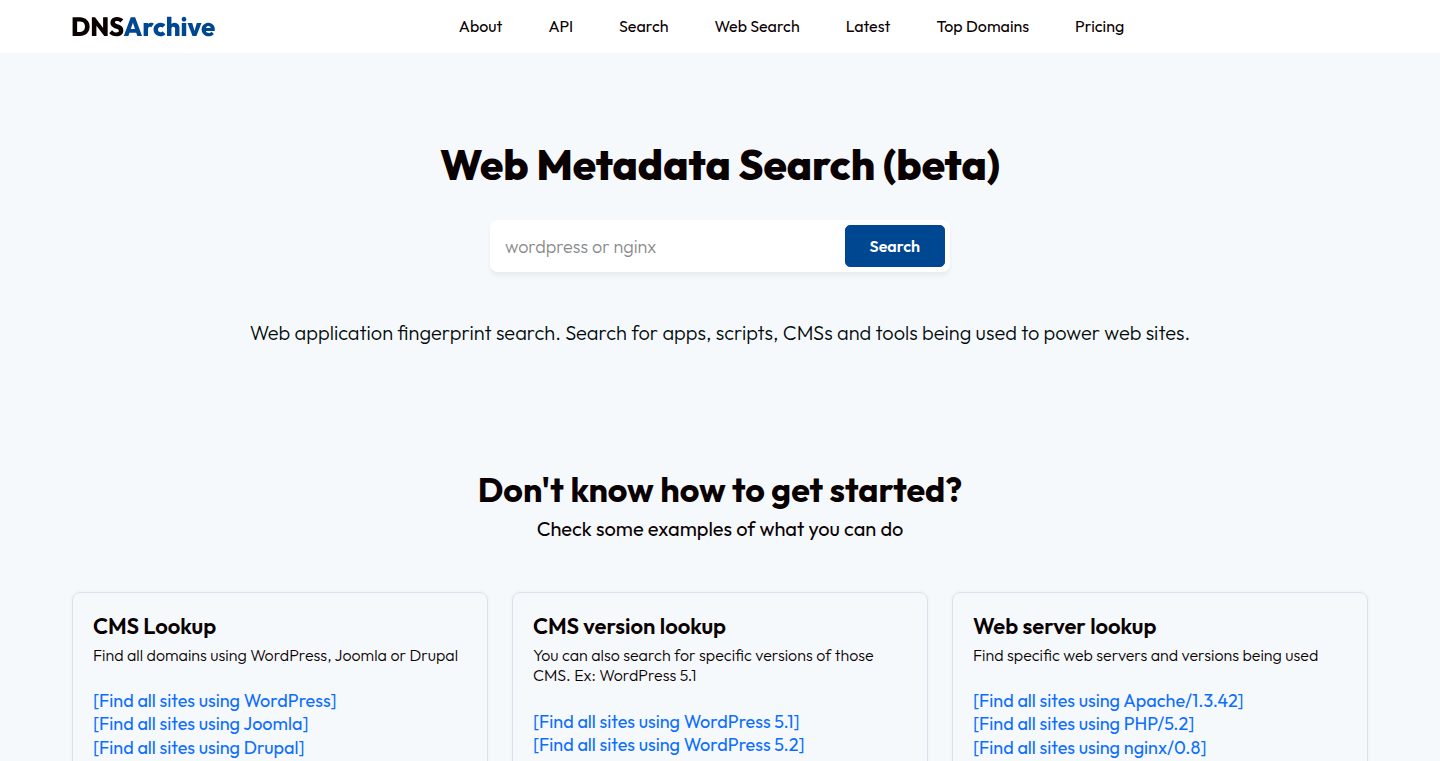
Author
danielcid
Description
This project introduces a search engine specifically designed to find patterns within website metadata. Unlike traditional search engines that primarily focus on content, this tool delves into the "behind-the-scenes" information of websites, like headers, linked resources, and server configurations. It allows users to pinpoint websites using specific technologies (e.g., PHP versions, WordPress versions). The innovation lies in its ability to index and search this often-hidden web data, opening up new possibilities for analyzing website architecture, identifying technology trends, and discovering potential vulnerabilities.
Popularity
Points 2
Comments 0
What is this product?
This is a search engine that indexes and allows users to search the metadata of websites, which is the information websites broadcast about themselves but is not directly visible in the content. This includes headers, links, and other technical details. The innovation is in its ability to extract, index, and search this information, offering a different perspective on website analysis. For example, it can identify websites running a specific version of PHP or using a certain Content Management System (CMS). So this is useful if you're a developer or a security researcher who needs to understand how websites are built and what technologies they use.
How to use it?
Developers can use this service by entering search queries in a specific format. For instance, to find all websites using PHP 5.2, you'd enter a search query like "PHP/5.2". The search engine then returns a list of websites matching that criteria. This can be integrated into other tools or scripts to automate analysis tasks, identify technology usage, or understand website trends. So, it’s easy to start discovering the web's metadata.
Product Core Function
· Metadata Indexing: The core function is to collect and index website metadata. The value lies in creating a searchable database of behind-the-scenes information. This is useful for identifying trends and detecting technology usage.
· Pattern Matching Search: The search engine supports pattern matching, allowing users to search for specific strings or regular expressions within the indexed metadata. This is useful for finding websites using a specific technology, such as a specific version of PHP or WordPress, allowing for targeted analysis.
· Version Detection: The ability to identify website versions of various software, like PHP, CMSs. This is useful for security audits, identifying potential vulnerabilities, and assessing the technology landscape.
Product Usage Case
· Security Auditing: Security researchers can use the tool to identify websites running outdated or vulnerable software versions (e.g., an old version of WordPress). This helps in assessing security risks and prioritizing penetration testing efforts. So, this allows for efficient identification of potential security threats.
· Technology Trend Analysis: Developers and analysts can utilize the search engine to track the adoption rates of different web technologies (e.g., comparing the usage of various JavaScript frameworks). This can provide insights into emerging trends and technology shifts in the web development landscape. This helps in understanding which technologies are becoming more or less popular.
· Competitive Analysis: Businesses can analyze their competitors' technology stacks to understand their infrastructure, content management systems, and other technologies. This assists in benchmarking and making informed decisions about technology investments. So, it lets you see what technologies your competitors use and if those are good.
40
Quick Dungeon Crawler Site: A Static Site Generator for Interactive Game Worlds

Author
logTom
Description
This project leverages Astro, a modern static site generator, to build a website for a dungeon crawler game. The key innovation is its ability to create interactive game elements within a static site, allowing for a rich user experience without the need for a traditional, dynamic server. It addresses the common challenge of building engaging web experiences without the complexities of backend development, demonstrating the power of frontend technologies. So this lets you build cool game-like websites really easily without needing to set up a whole server.
Popularity
Points 2
Comments 0
What is this product?
This project uses Astro, a technology that builds websites that are super fast because they're pre-built. The website is designed to display elements of a dungeon crawler game, like maps, character stats, and interactive choices. The cool part is that all these interactive bits are built into the website itself, without relying on a server to update or manage them. This means the website is fast, easy to host, and can handle a lot of visitors. So you get a fast, lightweight website, like a pre-made game world.
How to use it?
Developers can use this project as a template. They can modify the game's content, like maps, characters, and rules, to create their own dungeon crawler game website. They'd need to be familiar with Astro and web technologies like HTML, CSS, and JavaScript. The project is easily deployed to static hosting platforms. You can customize everything, like the game's rules and look, and then instantly have a working website. So you can create your game website quickly and easily.
Product Core Function
· Static Site Generation with Astro: This is the core of the project. Astro pre-builds the website, so it loads lightning-fast for users. This is valuable because it provides a great user experience and saves developers time and resources. So you get a super fast website.
· Interactive Components: The site uses frontend technologies (HTML, CSS, JavaScript) to create game-like interactions within the static site. This means the user can interact with the content without needing a server for updates. This is useful for creating engaging user experiences without the complexity of backend server. So you can make your site more interactive without the hassle of server-side code.
· Content Management: While not explicitly mentioned, the project structure likely facilitates easy content updates through simple configuration and templating. This simplifies adding and changing game elements. This allows developers to quickly and efficiently modify the game's content. So you can easily change things on your website.
· Open Source and Customizable: The project's open-source nature means that developers can use the code and modify it. This means you can adapt it to your needs and create customized solutions. So you can freely use and modify the project to build your own game website.
Product Usage Case
· Personal Game Website: A game developer could use this project to create a website to showcase their dungeon crawler game, providing maps, character sheets, and interactive elements. This showcases the game's features and increases player engagement. So a developer can easily build a website to show off their game.
· Interactive Storytelling: Authors or writers can use this framework to build interactive stories, allowing users to explore a story world in a dynamic way. This enables richer reader experiences. So authors can create cool interactive stories.
· Educational Applications: Educators can adapt this to create interactive educational simulations or games. This makes learning more engaging and interactive. So teachers can create fun learning tools.
· Portfolio and Showcase: Developers could create interactive portfolios or project showcases with this technology. This lets developers showcase their work. So a developer can make an interactive portfolio to show off their work.
41
AreTheyBlacklisted.com: A Community-Led Noticeboard Against Exploitative Behavior
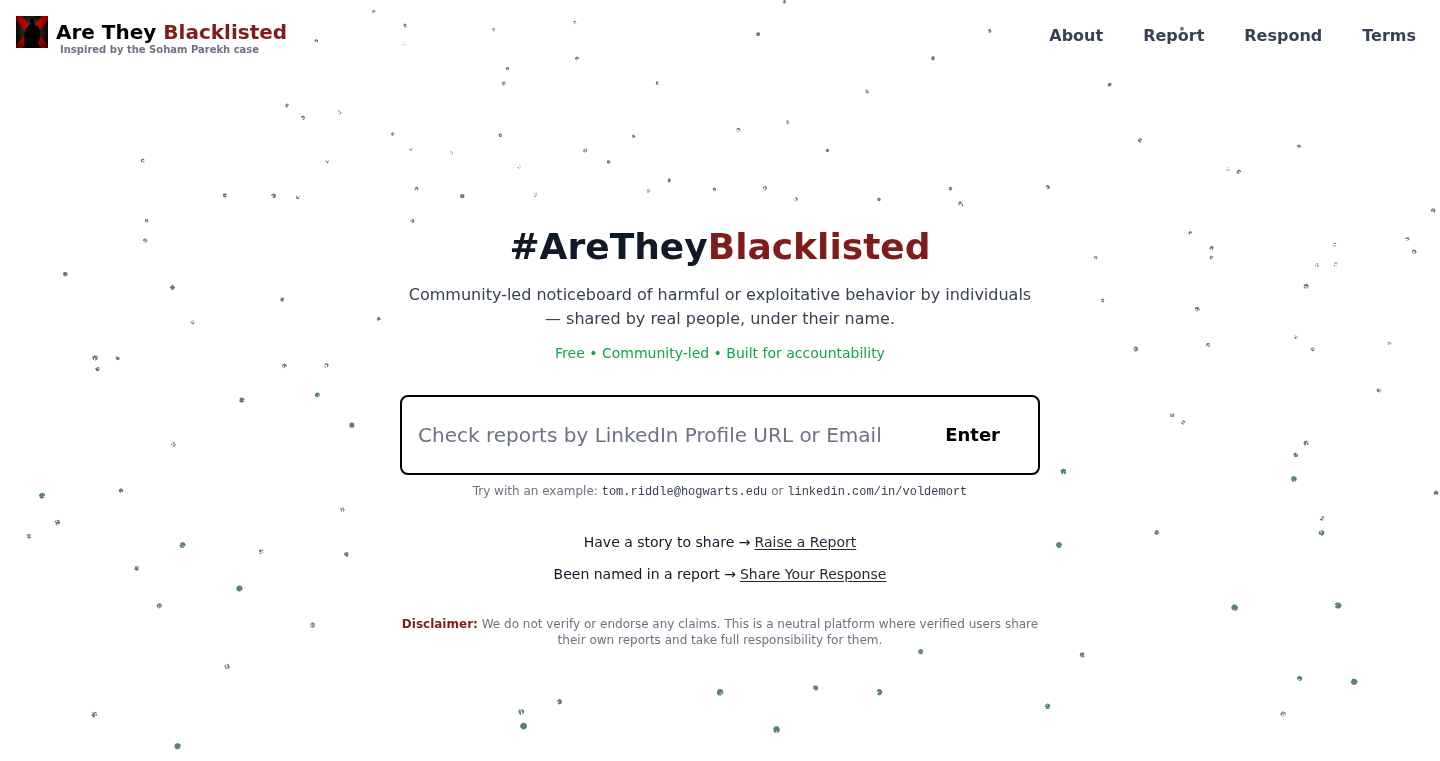
Author
abhinav95
Description
This project creates a public, community-driven database to log and share information about individuals engaging in harmful or exploitative behavior, particularly in the context of remote work and engineering. It tackles the problem of protecting the community from potentially malicious actors. The innovation lies in its approach: requiring verified identities for reporting, providing a public right-of-reply, and offering searchability via professional profiles. This ensures transparency and accountability, unlike anonymous forums that can easily spread misinformation. It uses Firebase, Tally.so, Caffeine, Cursor, GPT, and music to make it happen.
Popularity
Points 2
Comments 0
What is this product?
This is a platform, much like a public bulletin board, where individuals can report and share information about others who have engaged in harmful or exploitative behavior. It leverages technologies like Firebase for data storage and management, and Tally.so and Caffeine for various functionalities. The key innovation is its focus on verified identities and public right-of-reply to foster a more responsible and accountable environment. This is different from a typical anonymous review site, as it attempts to balance transparency with the right to respond. So, it is an effort to build a safer work environment.
How to use it?
Developers and professionals can use this project by visiting the website (aretheyblacklisted.com) to search for information on individuals. If someone has been wronged, they can submit a verified report using their company email, providing details of the incident. The platform then allows the reported individual to publicly respond to the claims. This is particularly useful for recruiters, hiring managers, or anyone collaborating with others remotely who want to check the background of potential teammates. This allows for a safer environment.
Product Core Function
· Report Submission: Allows users to submit reports about individuals involved in exploitative behavior. This is the core of the system, and the value lies in creating a centralized location for these reports. Application: Used when developers/companies feel they've been taken advantage of and want to alert others.
· Verified Identity: The requirement for verified identities (e.g., company email) adds credibility to the reports. The value here is in reducing the likelihood of false or malicious accusations. Application: Ensures the integrity of information by linking reports to verifiable sources.
· Public Right-of-Reply: Allows individuals named in reports to publicly respond to the claims. This ensures fairness and transparency. Application: Helps build trust by offering those accused a chance to defend themselves.
· Search Functionality: The ability to search via LinkedIn or email makes it easier to check the background of potential collaborators or employees. This function relies on integrating with existing professional networks and email systems. Application: Allows users to find information before making a decision.
Product Usage Case
· A startup is hiring remote engineers and wants to check if any candidates have a history of scams or exploitation. The hiring manager uses the search functionality to search the engineer's email or LinkedIn profile on the platform, thus mitigating the risk of engaging with a fraudulent individual.
· A developer has worked with a freelancer who failed to deliver on their project, and engaged in exploitative behaviour. The developer can submit a report to warn other potential clients. The goal is protecting the community from future issues.
· A community of freelancers uses the platform to check on potential clients before accepting a job. This enables them to evaluate risks, and protect themselves against potentially exploitative companies or individuals. They are leveraging the public information to mitigate risks.
42
SVG-Powered Radial Menu Generator with ChatGPT
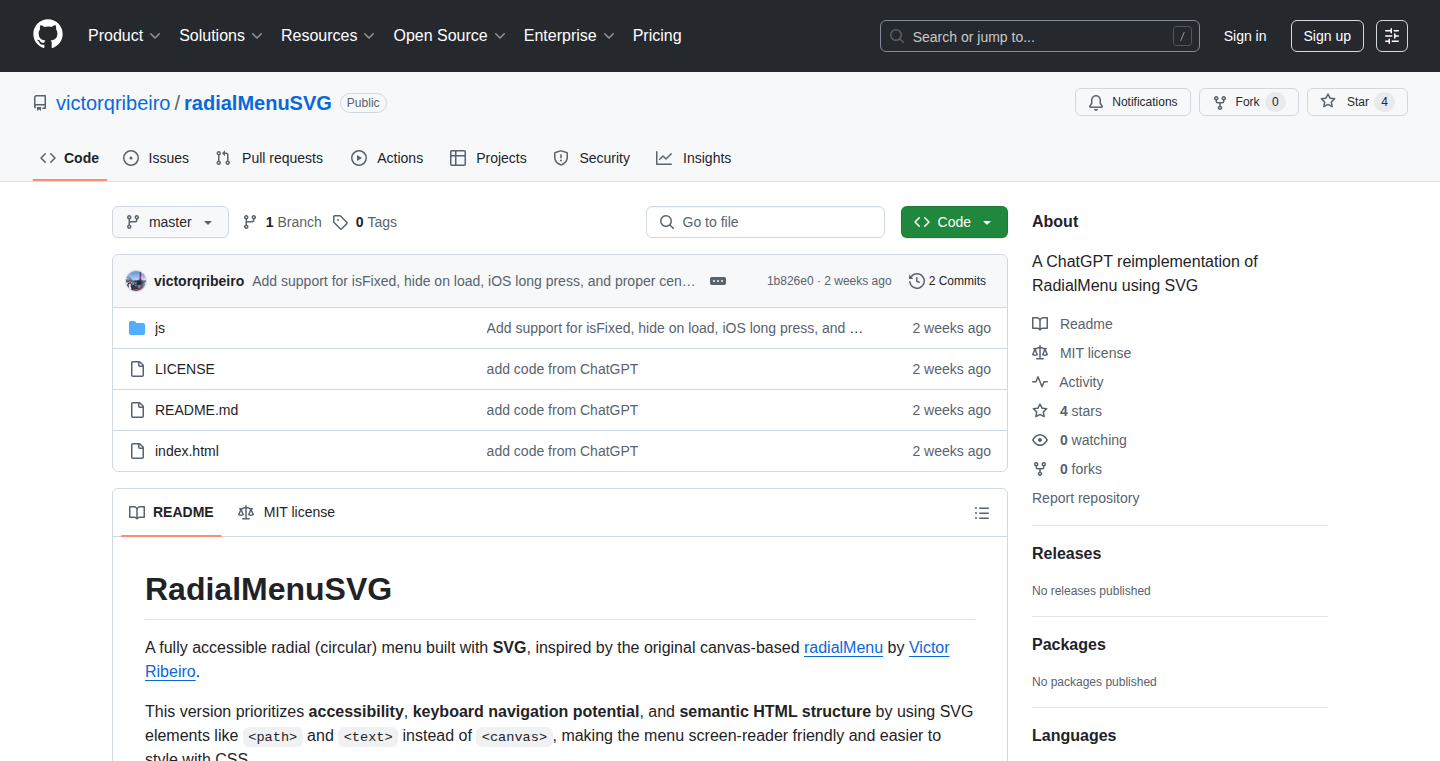
Author
atum47
Description
This project demonstrates the power of AI, specifically ChatGPT, to translate a design concept (a radial menu in the browser's canvas) into a fully functional and scalable SVG-based implementation. The core innovation is the use of ChatGPT to automatically generate the SVG code, significantly reducing the time and effort required to create complex UI elements. This tackles the problem of manual SVG coding, which can be time-consuming and error-prone, while offering the benefits of vector graphics like scalability and cross-platform compatibility.
Popularity
Points 2
Comments 0
What is this product?
This project leverages ChatGPT to create a radial menu entirely in SVG (Scalable Vector Graphics). Instead of manually writing code to draw the menu elements, the developer provides a description of the desired menu design to ChatGPT, and the AI then generates the necessary SVG code. The core technology is the combination of natural language processing (ChatGPT) with SVG rendering, making it easy to create and customize complex UI designs in web applications, especially for responsive layouts.
How to use it?
Developers can use this by providing ChatGPT with prompts describing their desired radial menu appearance, functionality, and behavior. The AI will then generate the SVG code, which can then be embedded directly into the HTML of a web page. This is a highly flexible solution, enabling the menu to be scaled up or down without losing quality. Integration is simple: copy and paste the generated SVG code into your HTML.
Product Core Function
· AI-Powered SVG Generation: The primary function is generating SVG code for a radial menu from natural language prompts. This reduces the time and coding complexity involved in creating custom UI elements. So, it allows developers to focus on design rather than the tedious implementation of the graphic code.
· Scalable Vector Graphics (SVG) Output: The generated output is in SVG format, providing vector-based graphics that can scale to any size without pixelation. So, the menus will look crisp and clean on any device or screen size, maintaining visual quality.
· Rapid Prototyping and Iteration: Facilitates faster design iterations by simplifying the process of modifying and updating the radial menu's appearance and behavior. So, you can quickly experiment with different menu designs and functionalities, saving development time.
· Accessibility and Customization: SVG menus are inherently accessible and can be easily customized with CSS to match any website or application's style. So, it ensures the menu is accessible to users with disabilities and integrates seamlessly with your existing design.
· Cross-Platform Compatibility: SVG menus are compatible with all major web browsers and platforms. So, the menus will work consistently across all devices and browsers, ensuring a consistent user experience.
Product Usage Case
· Responsive Web Design: Imagine building a website with a navigation menu that adapts to different screen sizes. With this approach, you can create a radial menu and easily scale it without compromising its visual quality. So, you can offer the best viewing experience for all users regardless of their device.
· Interactive Data Visualization: Developing an application to visualize complex data. This could involve a radial menu with interactive elements for zooming in on specific parts of your data visualization. So, the users have better interactive capabilities with the data.
· Game Development: Designing the user interface for a game. You could generate a radial menu for selecting weapons or performing special actions. So, you can quickly design the UI with ease and speed.
· Custom UI Components for Applications: Building custom UI elements for a web application. You could generate a radial menu to navigate through various sections. So, you can quickly prototype custom UI elements based on your needs, making your development more efficient.
· Prototyping User Interfaces: As a UX designer, you can rapidly prototype different radial menu designs using ChatGPT and see how they work in different screen sizes without manual coding. So, you can iterate designs and validate the prototype more efficiently, saving development time.
43
MangaCraft: AI-Powered Webtoon Growth Engine

Author
Ibrasama
Description
MangaCraft is a no-code SaaS tool designed to help Webtoon creators boost their visibility and engagement. It uses AI to analyze a creator's series, offering automated audits, SEO recommendations, and a visual dashboard. The project leverages scraping technology to gather data, AI for insights, and automation tools for streamlining the process. It tackles the common problem of Webtoon creators struggling with discoverability and provides actionable advice for improvement. This helps creators understand their performance and strategize for growth without needing to be technical experts.
Popularity
Points 2
Comments 0
What is this product?
MangaCraft is like a personal assistant for Webtoon creators. It works by first 'scraping' data from platforms like Canvas and Tapas – essentially, it automatically gathers information like how many views, likes, and comments a creator's Webtoon gets. Then, it uses AI (like OpenAI) to analyze this data and provide recommendations, such as how to improve the title or what hashtags to use for better search engine optimization (SEO). It also generates a visual dashboard to track performance and offers downloadable reports with suggestions. This provides creators with data-driven insights to make better decisions about their content, without requiring them to manually collect and analyze information. So this gives you a clear picture of what's working and what's not.
How to use it?
Webtoon creators can use MangaCraft by signing up for the beta (currently), providing their Webtoon series information. The tool then automatically audits the series, providing performance metrics, SEO recommendations, and growth suggestions. Creators can then use these insights to improve their content, titles, and promotion strategies. Integration is seamless because it is a SaaS. Think of it as a dashboard that tracks and analyzes everything you need to know, giving you data to guide your actions. So this helps you spend more time creating and less time analyzing.
Product Core Function
· Automated Series Audit: This feature scrapes data (views, likes, comments) from various Webtoon platforms. It allows creators to understand their series performance at a glance, highlighting areas that need attention. The value here is the time saved from manually gathering and analyzing data, and the insights gained from seeing all metrics in one place. This is helpful if you want a quick overview of how your series is performing.
· AI-Powered Recommendations: Using AI, MangaCraft analyzes the series data to generate recommendations for title improvements and better SEO. This helps creators optimize their content for increased visibility on search engines. This feature saves time and effort from trying to figure out the best SEO strategies. It makes it easier for new readers to discover the Webtoon.
· Visual Dashboard with Performance Metrics: This offers a clear and easy-to-understand overview of a creator's series performance, including key metrics like views, likes, and engagement. This helps creators to track progress and identify trends over time. It helps creators to monitor their growth and make data-driven decisions, instead of guessing what's working and what's not.
· Downloadable PDF Report: MangaCraft generates reports with improvement suggestions. Creators can save the PDF report to share with team members or use for future reference. This creates a record of the insights and recommendations, offering an easy way to review and implement changes. So it offers a shareable way to plan and keep track of strategies for improvement.
· Gamified Progress System: MangaCraft integrates gamification elements to incentivize creators to be consistent with their publishing schedule. This is useful for creators to maintain an effective publishing schedule and to stay motivated. It is helpful if you are the sort of person who struggles with consistency.
Product Usage Case
· A creator can use MangaCraft to understand why a specific chapter had low engagement. The AI-powered audit could highlight that the title was not relevant or that the episode wasn’t optimized for SEO. This helps the creator adjust the title and keywords of future chapters. It saves a lot of guesswork, so creators can know what to do differently in the future.
· A Webtoon artist could use the dashboard to track their progress in terms of views and likes over time. If they notice a dip, they could use the AI recommendations to adjust their content and improve their strategy. It offers data-driven insights into how to increase viewership. This is a must-have if you want to track your content success.
· A Webtoon creator could use the downloadable PDF report to showcase their achievements to their team or to share with a publisher. The report summarizes the key findings and recommendations, providing a clear picture of their series' performance and growth potential. It allows you to present a clear, data-driven picture of your project's value.
44
SimTool: Terminal UI for iOS Simulator Management
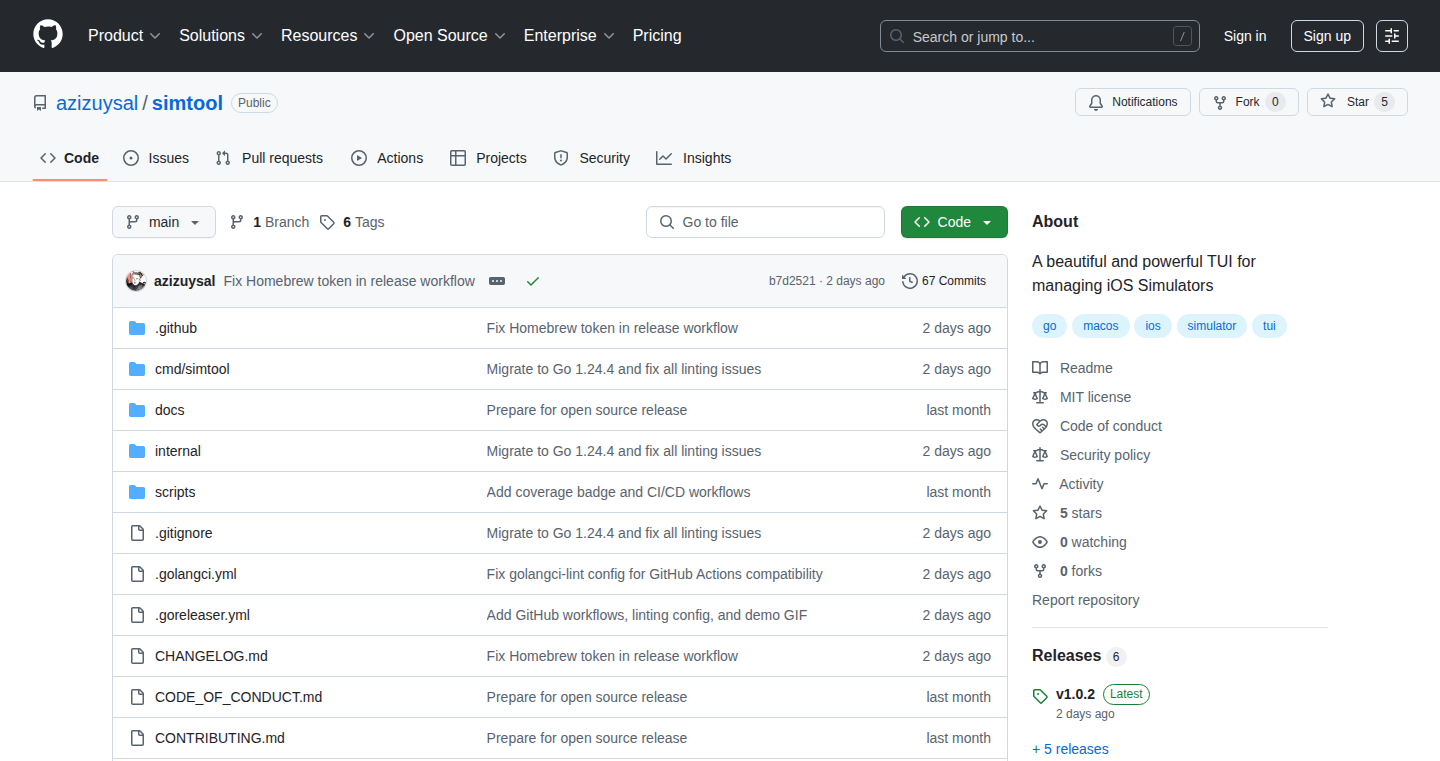
Author
azizuysal
Description
SimTool is a command-line tool that makes it much easier to manage your iOS simulators directly from your terminal. It solves the common pain point of having to constantly dig through Finder to inspect app data and simulator files. It provides a more efficient workflow for iOS developers by offering features like file browsing with syntax highlighting, image previews, and database inspection, all within the terminal. So this makes it easier to debug and understand what's happening inside your app.
Popularity
Points 1
Comments 0
What is this product?
SimTool is essentially a user interface for your iOS simulators that runs in your terminal. Instead of clicking around in the Finder, you can use commands to navigate through your simulators, see what apps are installed, and inspect their data. It's built with Go, a programming language known for its efficiency, and uses a library called Bubble Tea to create the terminal UI. It highlights code syntax and supports different color schemes for your terminal. So, it's like having a powerful command center for your iOS development, right at your fingertips.
How to use it?
iOS developers can install SimTool using Homebrew (a package manager for macOS). After installing, you can simply type `simtool` in your terminal to launch the interface. From there, you can browse simulators, select apps, and view their data. SimTool also provides keyboard shortcuts to quickly boot simulators and open files in Finder. This tool is designed for developers who need to frequently debug, test, and inspect the internals of their iOS apps running in the simulator. So, you can troubleshoot problems faster and understand app behavior better.
Product Core Function
· Browse iOS Simulators and Apps: SimTool lets you see all your simulators and the apps installed on them in a clear list. This is super useful for quickly finding the simulator and app you need to work with. So, it helps you save time by making it easy to find the target you want to test on.
· Navigate App Containers: You can dig into an app's files directly from the terminal. It's like a file explorer but works inside your terminal, so you don't need to switch to Finder. So, you can see all your app's internal data without leaving the terminal.
· Syntax-Highlighted File Viewing: When you open a file, SimTool will highlight the code or data, making it easier to read and understand. This feature is helpful for quickly spotting errors or understanding how your app is storing data. So, you can easily read and understand code files.
· Preview Images, Databases, and Archives: You can view images, SQLite databases, property lists (plists), and archives directly in the terminal. This means you don't need separate tools to see what's inside. So, you can quickly check images and data without opening external applications.
· Search and Filter: SimTool allows you to search and filter simulators and apps, making it easy to find what you need, especially when you have a lot of simulators. So, you can find what you need quickly without having to sift through a long list of simulators and apps.
· Boot Simulators and Open Files with Shortcuts: You can start simulators and open files in Finder with keyboard shortcuts, making your workflow much faster. So, it boosts your efficiency while working.
Product Usage Case
· Debugging Network Requests: Imagine you're testing an app and want to see the network traffic it's sending. With SimTool, you can quickly find the app's container, navigate to its data files, and view the cached network responses. So, you can easily debug network-related issues.
· Inspecting Local Data Storage: You need to check the data your app is storing in a local database (like SQLite). SimTool lets you browse the database file, open it, and view the data directly in your terminal. So, you can quickly verify that the data is being saved correctly.
· Testing App State: You can view your app's current state by inspecting its property list (plist) files, giving you a quick way to check the app's configuration. So, you can quickly check the application's current state.
· Managing Different Simulator Configurations: You are working with multiple simulators, each with different iOS versions and devices. SimTool helps you quickly switch between simulators and inspect their data. So, you can easily switch between different simulator configurations.